
- Skip to primary navigation
- Skip to main content
- Skip to primary sidebar
Travel China Cheaper
Travel China the smart way! Expert tips and travel advice for China tourists and expats.
PLANNING A TRIP TO CHINA? Start Here

China Train Guide 2024 | Tips & Travel Advice
February 6, 2024 By Josh Summers
Welcome to the Ultimate China Train Guide , updated for 2024! I’ve been taking trains in China for more than 10 years now and it is one of the most comfortable and fun ways to explore China. These are all the things you need to know in order to search for the right train, buy train tickets, navigate the China train station and more. Enjoy!
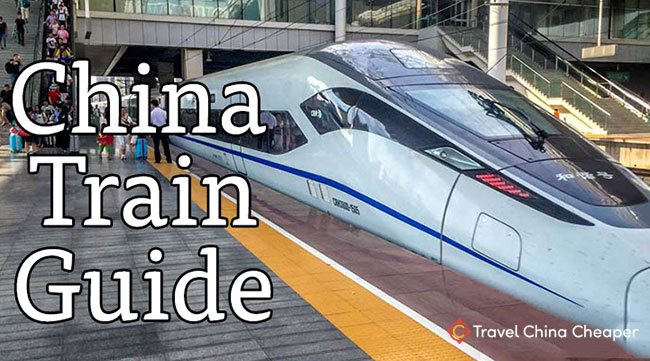
It doesn’t matter if you’re taking a high speed train from Beijing to Shanghai or the slow train from Lanzhou to Urumqi…
…in this guide we’re going to attempt to cover all aspects of train travel in China.
How, you say?
I’m not going to teach you how to buy train tickets in China…you’re going to learn how to buy train tickets in China without standing in a line .
I’m not going to just explain the different types of trains that are operating in China…you’re going to learn which trains have power plugs, what to expect with the toilets and what you need to make sure to bring with you .
But most of all, my goal by the time you finish reading this guide to trains in 2024 is to take away any fear or reservations you have about doing it.
Trust me: it’s easy;
It’s cheap;
And best of all it’s fun.
How do I know? Well…I happen to be writing this while on a high-speed train from Qingdao to Shanghai 🙂

Are you ready? Great! Let’s get started .
Because I’ve worked hard to make this such a comprehensive guide (over 4,000 words!), I’m including a table of contents to help you navigate easily.
Table of Contents
- Pros/Cons of Trains in China
- Understanding China Train Numbers (and why it matters)
A Peek Inside a Chinese Train
- Navigating a China Train Station
How to Buy China Train Tickets Online
- How to buy China Train Tickets at the Station
Understanding Your China Train Ticket
- Frequently Asked Quesitons about China Trains
- Train Tips from a Seasoned China Traveler
Note: Some links in this article are affiliate links, which means that at no extra cost to you, I may be compensated if you choose to use one of the services listed. I only recommend what I’ve personally used, and I appreciate your support!
If you don’t have time to read it all, just follow the instructions below and I’ll email you a free PDF copy!
Pros and Cons of Taking a Train in China
There are plenty of great reasons to take a train in China – and a few reasons you might want to avoid them.
In general, it is my opinion that the pros far outweigh the cons . Often, however, the choice between a train, bus or flight in China must be considered on a case-by-case basis.
So let’s start this China train guide by looking at the reasons that trains in China are such a popular form of transportation for travelers.
This is true even more so now in 2024.
The Benefits of Taking a Train in China
- Trains Save Money : Taking a train in China is in many instances the cheapest form of transportation. Cases where this might not be true is when taking a high-speed train over long distances. If you’re seriously looking to save money, buying a hard seat or standing ticket is dirt-cheap (albeit incredibly uncomfortable).
- Train Ticket Prices are Set: The best part about buying train tickets is that unlike fluctuating flight prices that make finding cheap China flights difficult , the prices of train tickets don’t fluctuate. They’re set, so you know exactly how much you’ll have to pay.
- Trains Save Time : Taking a train in China can often save time over flying or taking a bus. Train stations are often conveniently located in the middle of a Chinese city, as opposed to most airports which are far outside. In addition, you don’t have to arrive at a train station hours in advance of your departure like you do with flights. I usually arrive about 30-45 minutes ahead of my departure time. China trains are very punctual, unlike flights in China which experience delays or buses which are subject to traffic conditions.

- China Trains are Comfortable : Contrary to what you might imagine, trains in China can be quite comfortable. As a general rule, you get more leg room in a train, better opportunity to walk around, and there’s usually even a restaurant car. Sleeper car beds aren’t bad and the seats in the new high speed trains are much better than airplanes.
- China Trains Offer Beautiful Scenery : Trains offer a unique view of the varied China terrain that rolls by your window. You don’t get this beautiful view when taking a bus or airplane.
- China Trains Offer Cultural Experience : Trains offer a fun cultural experience that is hard to beat. Spending hours with your fellow Chinese passengers, most of whom will be happy to meet you and curious to chat, will provide a window into Chinese culture that you would never have in a bus or airplane. Taking a train in China is even a good opportunity to practice your Mandarin Chinese.
The Drawbacks of Taking a Train in China
As much as I like to talk up the advantages of taking a train during your trip through China, there are a few things you should be warned about before taking a train:
- China Trains Can Get Crowded : This is especially true over major holidays like Chinese New Year. Trains sell standing tickets that can make the cheaper, lower class seats uncomfortable when they’re full of people standing everywhere.
- China Trains Aren’t Always Cheaper : Always do your homework. There are many times where flights have been discounted so heavily that it has been cheaper for me to fly than take a train.
Did You Know…
In 2019, Chinese trains transported a total of 3.57 billion passengers. That’s BILLION with a “B”.
- Train Tickets Regularly Sell Out : Because train tickets are put on sale 30 days prior to departure date and prices don’t fluctuate, buying a “last minute” train ticket can be difficult. As a general rule, I try to buy my China train tickets at least 5 days prior to departure (much earlier for the China holiday season). Anything sooner than that and I risk having to buy either a super-expensive business class or an uncomfortable standing ticket.
- Train Stations Don’t Always Cater to Foreigners : At least not as much as airports do. Many of the older train stations can be confusing for somebody who doesn’t speak a bit of Mandarin. Never fear, though! This is something I hope to help you with in the section on Navigating a Train Chinese Station .
Back to Top
Understanding the China Train “Code”
What most travelers don’t know is that you can tell a lot about your China train by looking at the train route number (i.e. “D2847” vs “K1128”).
Not only can you determine the speed of your train, it’s also usually a good indicator of comfort. In other words…
… it’s good information to have!
Chinese trains are broken down into different categories, which I’m listing in this China train guide starting from the fastest/most comfortable down to the slowest/least comfortable:
China’s High Speed Trains (“G” and “D”)
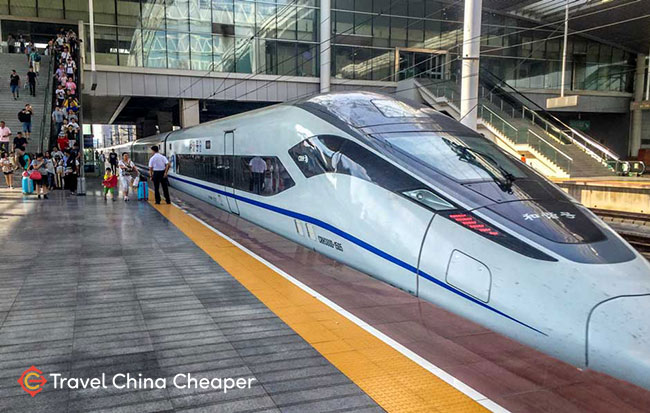
Over the past decade, China has invested heavily in its network of high speed railways, and has plans to continue this investment for the next decade .
The high speed rail is divided into two categories – “G” and “D” .
Aside from the speed and an extra class, they’re more similar than they are different. Both categories usually have western (i.e. seated) toilets (if you’re curious, here’s what to expect with China’ s toilets as a whole) as well as power plugs on *most* 1st class seats and all business class and premium seats.
- G – The “G” train, short for “Gaotie” which means “high speed train,” is the newest, fastest and usually the most comfortable China train. It’s also the most expensive. These trains usually run at speeds of up to 300km/hr and are quickly becoming the future of train travel in China. You can purchase 2nd class, 1st class and Business class tickets on this train.
- D – The “D” train, short for “Dongche”, is often identical to the G train with one exception: speed. These trains don’t exceed 250 km/hr. Still, they’re comfortable and along certain routes don’t add that much more time than the G train. You can purchase 1st class and 2nd class tickets on this train.

A new addition to China’s high speed system is the sleeper train. These trains run overnight and are still listed under the “G” and “D” designations.
China’s Standard Trains
Standard trains are the older version of China’s rail system and rarely exceed 140 km/hr.
Although less common than they used to be before the high speed train came into existence, you’ll still find these standard trains going to smaller cities or throughout less-developed regions of China.
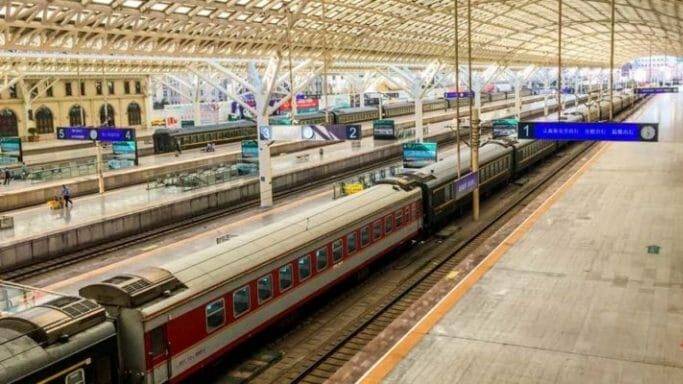
Usually, these trains are divided internally into “Soft Sleeper” , “Hard Sleeper” , “Hard Seat” and sometimes a “Soft Seat” .
They don’t always have a western toilet or air conditioning, but they are cheaper. There are different designations which include:
- Z – The “Z” train is an overnight express train that only runs select routes based on demand. They aren’t common, but it’s usually the fastest of the “standard” China trains – up to 160km/hr.
- T – The “T” train is short for “Tekuai” which means Express Train. These trains are usually special routes between two major cities that run faster than other standard trains because they don’t have many stops in between. The T trains are also less likely to have sleeper options and are more often divided into 1st and 2nd class sections similar to the D train. High speed of 140 km/hr.
- K – The “K” train is short for “Kuaiche” which simply means Fast Train . These used to be the most common – and fastest – trains in China before the era of the high speed train took over. They travel all throughout China between the different provinces.
- Only Numbers – These number trains don’t have a letter before them and are considered “ordinary” trains. If the train begins with 1, 2, 4 or 5, it will be slightly faster than a train whose number begins with 6, 7, 8 or 9. The highest speed of these trains is 100-120 km/hr.
- Other – You may also happen to run across an “L” (temporary train during peak season), a “Y” (tourism) and an “S” (train connecting a city with its suburbs) train, but these are much less common.
As we continue with this ultimate China train guide, let’s take a quick look inside both the high speed and standard China trains.
In this way, you’ll hopefully get a better idea of what to expect on your journey.
Inside China’s High Speed Trains
The two most common ticket classes you can purchase on a high speed train are a 1st class seat or a 2nd class seat.
The difference between the two usually has to do with the size of the seat as well as the personal space allowed.
The 1st Class cars are arranged with two seats on either side of a center aisle. Leg room is plentiful and there are often electrical outlets to plug in your electronic device (although this isn’t always the case).
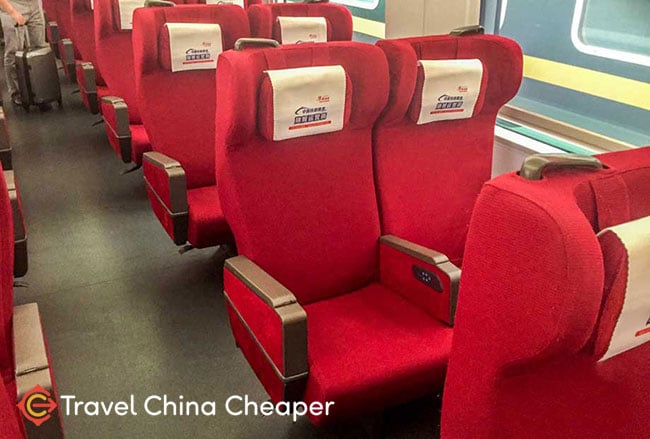
The 2nd Class cars have a tighter seating arrangement with three seats on one side of the aisle and two on the other.
Leg room feels more like an airplane but the seats are still relatively comfortable. I’ve seen some 2nd class seats that have electrical outlets but as a whole it seems that this isn’t common.
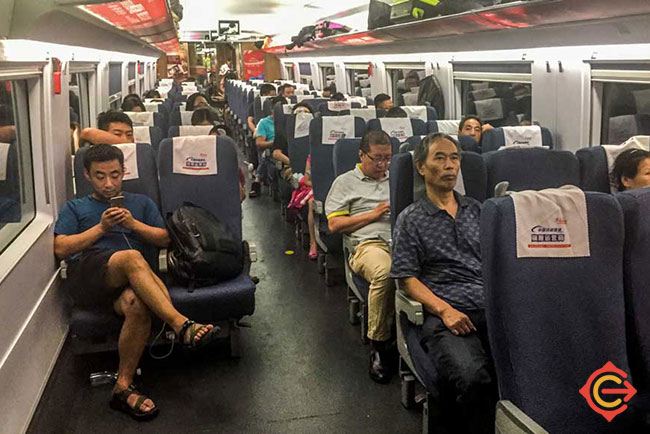
Beyond the 1st and 2nd class cars, you might also find a Business Class in high speed trains.
These comfortable, fully-reclining leather chairs are a treat for any traveler. Beware, though: it’s almost guaranteed to be more expensive than the cost of flying to your destination! Amenities here are similar to what you’d find on an airline business class.
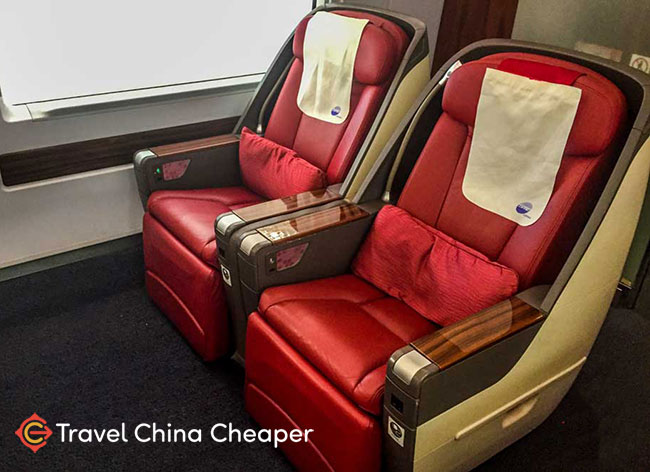
Although somewhat less-common, there are a few high-speed China trains have a super-luxurious class that goes by different names: VIP, Deluxe, Premium, Superior , etc.
These tickets are extremely expensive and usually offer private accommodation on the train, sometimes with your own private bathroom.
China’s high speed overnight trains offer the added luxury of a bed. The most common is lined on both sides with private bunks in two layers. Each compartment has its own light, window, and electrical plug.
My Personal Recommendation
In my opinion, 2nd class seats on a high speed train are comfortable enough for most people and are a great way to save money. However, I find that 1st class is the perfect blend of price and comfort. Plus, I like to work while traveling so I prefer having elbow room and a plug at my seat 😉
Inside China’s Standard Train
China’s standard trains can be arranged to include (or sometimes exclude) the following classes.
First you have the Hard Seat cars (Yinzuo or 银座) that have, as you would expect, hard bench seats set at a 90 degree angle with a table in between.
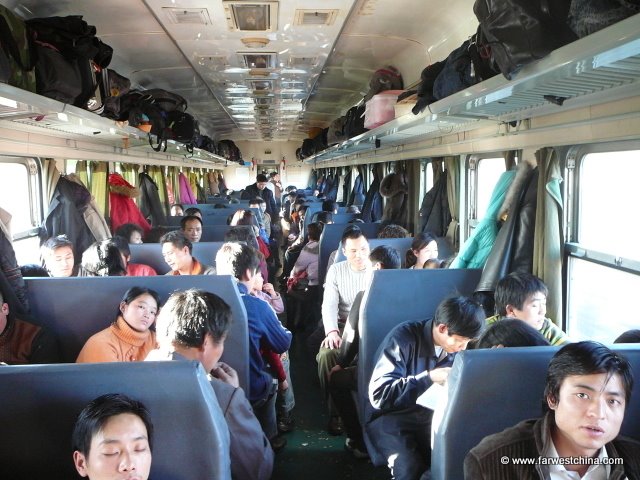
For short rides, these hard seats might not be a bad option. However, it can become incredibly uncomfortable for rides longer than a few hours. There are no electrical outlets and little room for luggage.
A limited number of trains include a Soft Seat car (Ruanzuo or 软座) whose seats would more resemble an airplane economy class, albeit a bit less comfortable. You have more personal space and the ability to slightly recline if you like.
The next step up the average China train is the Hard Sleeper cars (Yingwo or 硬卧) , which have berths of six beds – three on each side – with a small table between and no door. These are the tickets which sell out fastest because they are the best mix of price and comfort.
Beds aren’t overly comfortable but at least you can lay down!
These seats are designated as:
- “Shangpu” 上铺 (Top bunk, cheapest)
- “Zhongpu” 中铺 (Middle-bunk)
- “Xiapu” 下铺 (lower bunk, most expensive).
Finally, the best tickets you can buy on the average China train (T, K, P, L) are known as Soft Sleepers (Ruanwo or 软卧) , whose berths are comprised of 4 comfortable beds with a door that closes.
In the newer trains, these berths even include a small TV and electrical outlets for your computer and phone (although in my experience the electrical outlets rarely have electricity!).
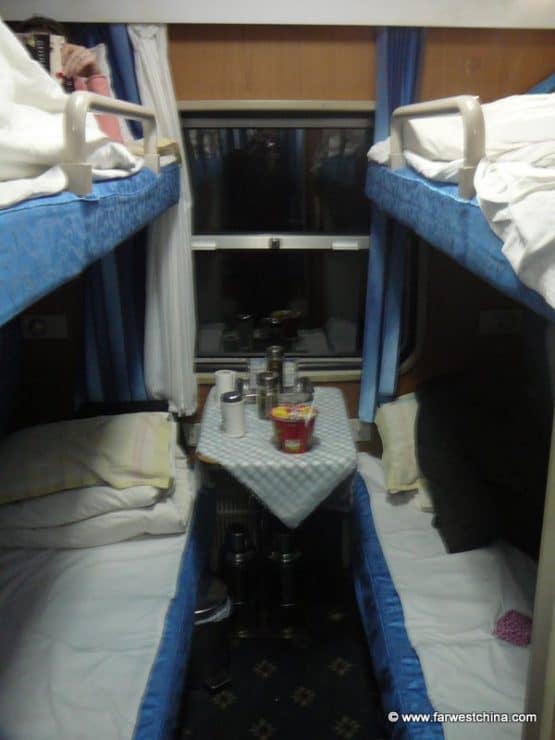
Beds here are good but the price can sometimes rival that of an airline ticket. These tickets are designated as “Shangpu” (Top bunk, cheaper) and “Xiapu” (Bottom bunk, slightly more expensive).
Bathrooms on most regular-speed China trains are squatty toilets and often are not that clean. The only exception is in the soft sleeper car, where there is usually one western-style toilet.
Additional Train Cars
On most trains you’re also likely to find a restaurant car where you can sit down for a meal that can be good but is likely a bit pricey. Feel free to walk around and ask for a menu here.
They won’t let you sit at the tables unless you order, however, so unfortunately you can’t use this as a free place to get away. Trust me…I’ve tried.
Navigating a Chinese Train Station
When talking to most China travelers, they tell me that the Chinese train stations scare them.
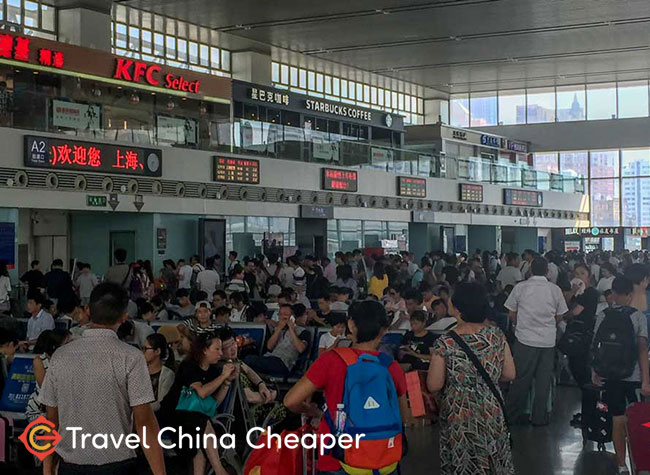
They do seem intimidating with their massive labyrinths of halls, stalls and waiting areas. It’s not as impossible as it seems, though, and I intend to direct you clearly in this China train guide.
Every train station in China is different and the newer stations are likely to have more signs in English for you.
Still, there is a basic process to a China train station you should understand:
- Step 1: Get Your Ticket – I’ll go into more detail below on how to buy China train tickets , but for now you should know that every train station has what they call a “Ticket Hall” or 售票大厅 in Chinese. Usually this ticket hall is outside the main entrance to the station and requires you to pass through its own security check to enter.
- Step 2: Show Your Ticket : As you enter the main station, one of the first lines you’ll stand in will be the ticket check, where you will need to present both your ticket and your passport. The agent checks to make sure that your identity on the two match.
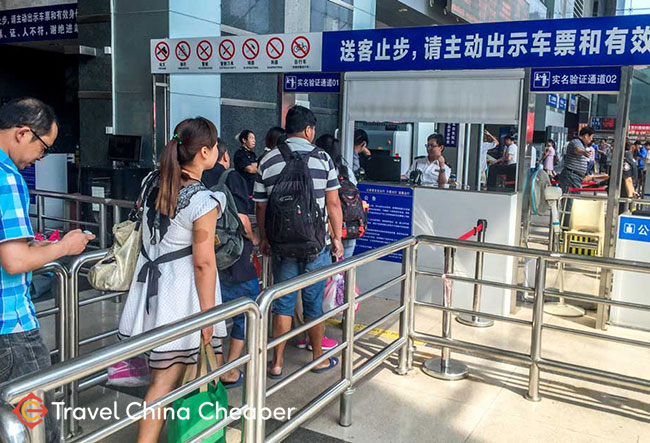
- Step 3: Security Checkpoint : Your next step is to scan your luggage. This is usually the choke point for any train station but thankfully it’s not as bad as airport security. You should keep your shoes and belt on and put your luggage through the scanner. Once you walk through a metal detector, prepare for a quick but harmless pat down by the security guard.
- Step 4: Find Your Waiting Hall/Gate : Don’t be afraid to find somebody who looks like they work there, show them your ticket and give a questioning look. Almost 90% of the time they’ll point you in the right direction. If you can read Chinese , there should be a board that will display your train number (which you can find on your train ticket) followed by the number of the waiting hall or gate from which you’ll depart. Around the waiting area there are usually small stores or fast food restaurants where you can stock up for the trip (although it’s often more expensive than buying outside).
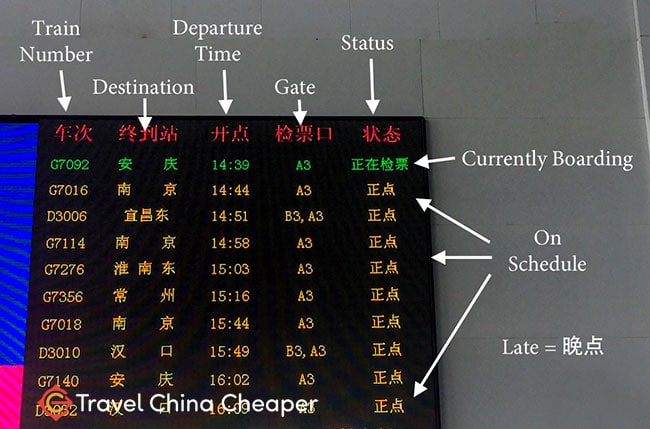
- Step 5: Board Your Train : Somewhere between 15-20 minutes before the departure time of your train, the doors will open and stewards will check your ticket one last time as you head to the train platform. Just follow everybody else and if you’re still confused, find somebody and show them your ticket.
- Step 6: Enjoy the Ride! You’ll be asked to show your ticket while on the train and sometimes even after you depart, so keep it handy.
Train Station Tips
Here are a few pro tips about train stations that I’ve picked up.
- Stock Up Outside : Purchase all your drinks and food at the stores outside the train station. Everything inside the station will be marked up considerably.
- What Makes it Through Security : It’s worth noting that things like drinks and oversized luggage are permitted through security, so don’t forget to stock up on plenty of water!
- What DOESN’T Make it Through Security : Fuel canisters, lighters, knives and other related items.
- Electrical Outlets and Internet : While some Chinese train stations offer free internet, it’s usually slow. It’s also hard to find electrical outlets so make sure you’re charged up before you arrive.
The best part about modern-day China train travel is that most of the ticketing has moved online.
For now, you MUST have a paper ticket in hand to board your train (that might change in the near future). Thankfully though, you can book it from the comfort of your home country and pick it up once you arrive in China.
Let me show you how as part of this China train guide. There are three main ways to book online:
- 12306 Website : The website 12306.cn is the official China railway website and is the best way to purchase train tickets on your computer. Unfortunately, it’s not the easiest. Aside from the website being all in Chinese, it also requires a Chinese phone number and a Chinese bank account. They don’t accept foreign credit cards right now. Still, for those who will be spending a lot of time in China, it’s a good option.
- Phone Apps : I’ve recently fallen in love with the 12306 phone app, available on both Android (direct download link) and Apple iOS . Like the website, it’s only offered in Chinese and requires a Chinese bank card to use. However, I find it useful for the purpose of checking up-to-date availability (all other apps will have a lag). It’s also possible to purchase tickets on the WeChat and Alipay platforms.
- 3rd Party Providers : For most traveler’s, this will be your only option but thankfully it’s not a bad one. 3rd party providers like China Highlights not only allow you to purchase tickets in English and use your foreign credit card, they’ll also arrange to have the tickets delivered to your hotel for you! In every case, these companies charge a fee, but usually it’s only a few dollars per ticket. Check pricing and availability of your China train here below.
Let me stress this – I highly, HIGHLY recommend you purchase tickets online prior to your departure.
Buying tickets in the station ticket hall is time consuming and difficult, particularly if you don’t have a command of the Chinese language.
It is possible to purchase China train tickets up to 30 days in advance of your departure . This and other rules about buying China train tickets have made this mode of transportation very appealing.

How To Pick Up Your Purchased Tickets
Purchasing the China train tickets is only half the battle – now you need to pick them up.
In order to reduce stress, I like to pick up my tickets prior to arriving at the station so I don’t have to stand in line.
I pick up my tickets at an official train ticket office (火车票代售点 or “Huo Che piao dai shou dian”) which are located throughout every city in China. It usually costs about 5 RMB for them to print your ticket but it is completely worth skipping the hassle at the train station.
With only one exception during a holiday season, I have never stood in line at a train ticket office to pick up my tickets.
Make sure you bring your passport and the reference code you were given when the tickets were purchased. It’s a 10-digit code that begins with one letter and ends in 9 numbers (i.e. “E123456789”).
How to Buy China Train Tickets at the Station
Every train station has a ticket hall, and you can stand in line to buy your tickets here.
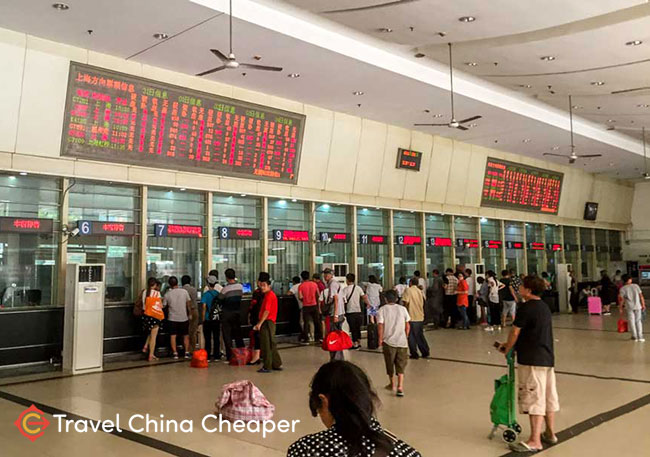
Now before we return to the train station, let me say that even if you don’t buy China train tickets online , it’s possible to use the official train ticket office I just mentioned in the section above to purchase tickets in person. There’s a 5 RMB surcharge but there usually isn’t any line.
For those that, for one reason or another, must purchase their tickets at the train station, make sure you arrive with your passport and cash.
If you’re purchasing for multiple people, you’ll need to have their passports on you as well.
It’s always best to approach the agent with a Plan A, Plan B and Plan C in case you don’t get what you want. I would even recommend you have it written down for convenience.
For instance, let’s say you want to go from Beijing to Shanghai on Friday. Your plan of action might be:
- Plan A : Buy 1st class tickets on Friday; in case that’s sold out…
- Plan B: Buy 1st class tickets on Saturday; if even that’s not available…
- Plan C: Buy 2nd class tickets on either day;
This “Plan A, B, C” method is important because there’s nothing worse than waiting in line only to have your plans foiled and with no backup.
You have to leave the window, regroup with your fellow travelers and stand in line again. I’ve done that before and it’s frustrating.
Once you have your ticket in hand, here’s a quick China train guide ticket reference to help you understand what your ticket is telling you.
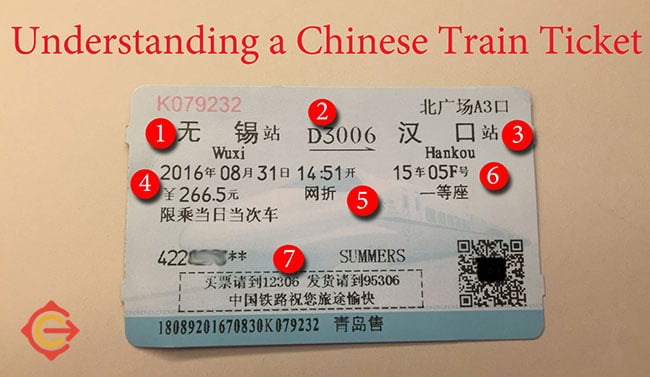
- Departure station : This should be written in both Chinese and English.
- Train Number : This number is specific to your train and tells you the class of the train.
- Arrival Station : Again, this should be written in both Chinese and English.
- Date of Departure : This is written as year/month/day.
- Time of Departure : This is when the train departs. Boarding usually happens 15-20 minutes prior to departure.
- Seat Assignment : The first number is the train car (车) followed by your seat number (号). Below that you’ll see exactly what kind of seat it is (i.e. 1st class, 2nd class, hard seat, soft sleeper, etc.).
- ID Information : The first few digits of your passport and your last name will be toward the bottom, which means that your tickets can’t be transferred to anybody else.
China Train Guide: Frequently Asked Questions

The following are the most common questions I hear about train travel in China. If there are any questions you think I’ve missed, add them in the comments below!
Officially there are luggage weight and size limits on a China train but they’re never enforced. If you can carry it on your person and it fits through a scanning machine, it will be permitted. The only thing to consider is that there’s no such thing as “checking baggage” on a Chinese train. You have to carry and store it by your seat and often there’s not a lot of room to do so.
Train tickets can be purchased 30 days in advance of the scheduled departure date. Note that many train ticket companies will accept reservation requests much earlier than this, but they can’t physically purchase the ticket until they go on sale 30 days prior to departure.
No, you can’t transfer your ticket because it is attached to your passport number. What you can do is return the tickets for a refund or have them changed at the ticket counter, although it’s not the easiest process.
Getting off the train during stops used to be common but is now highly discouraged. More than likely the train stewardess won’t let you leave unless it’s your stop.
After getting on the train, a steward/stewardess will come and check your ticket, making note of where you’re getting off. At each stop, he or she will (usually) come down the aisles calling out the name of the station and in the case of most foreign travelers will come and tell you that it is your stop.
Yes, you can! In fact, I highly recommend bringing food since the food on the Chinese train isn’t that good and is overpriced. Both food and drink are welcome.
Train Tips from Seasoned Travelers | China Train Guide
As somebody who has taken every type of China train to every size of China train station over the past 10 years, I’ve learned a thing or two about how to make the best of the experience.
Hopefully I can pass along some of this wisdom to you.
The following are a few of the “pro tips” I’ve picked up over the years.
- Download the Baidu Maps app on your phone (available for Apple iOS and Android phones).
- Wherever you are in a city, type in “火车票代售点” – or copy and paste it from here – to search for the nearest train ticket office where you can buy or pick up your tickets.
- If you don’t know a lick of Mandarin, download China Highlight’s China Train Booking app (available on Apple iOS and Android ). It’s possible to purchase tickets through the app but I find it equally useful for planning, letting you know what trains run on what days and approximately how many tickets are available. Note : If you read Mandarin, the 12306 app does the same thing, but is more accurate.
- When picking your tickets, I recommend the middle bunk (中铺 or “Zhongpu”) of a hard sleeper train or the top bunk (上铺 or “Shangpu”) of the soft sleeper train. The bottom bunks always have people sitting on them during the day and the top bunk of the hard sleeper has too little room between the bed and the train car ceiling.
- Bring hand sanitizer, particularly for longer trips. Bring a small book light if you like to read. Once the lights go out at night during an overnight train, you’re on your own.
- If you’re not sure you’ll have a plug to charge your phone on a long journey, buy a cheap external battery pack on Amazon before you leave or you can find plenty to purchase in China. They’re cheap and they’ll give you an extra full battery or two.
- Noise cancelling headphones are great on airplanes. They’re priceless on a China train – I never leave home without mine! Here is a look at my favorite noise-cancelling headphones for travelers .
- When you get off the train and out of the station, you’re probably going to be mobbed by people yelling “taxi”! Ignore them (I just put headphones on and keep walking). Every train station has a place for official taxis to wait and if you can’t find that just walk to the nearest major street and wait for one. The hawkers you meet will always charge you far more than you should pay and usually aren’t even legal.
- Bring your own entertainment – download movies, take along a card deck or whatever else you like. You’re probably not going to like any movie that might be shown on the train – if there even is one.
Final Thoughts | Enjoy the Journey!
We’ve come to the end of my ultimate China train guide for 2024!
Phew…you made it!
I trust you now feel confident to purchase your own tickets and jump on your train. Enjoy the China train experience during your travels here!
Do you have any other questions you’d like to ask? Feel free to leave a message in the comment section below.
Further Reading & Resources

Traveling or Moving to China Soon?
Download "44 Tips You MUST Know Before Traveling to China". These simple but often overlooked tips could make or break your trip !
Download the Tips Here
About Josh Summers
Josh is the founder of TravelChinaCheaper.com who has been living in China with his family since 2006. Over that period of time he has traveled by plane, train, car, motorcycle and even camel to explore almost every corner of the country.
Reader Interactions
September 14, 2016 at 7:03 pm
Great guide! Thanks for the tips about the best sleeper bunk – but how can I choose my seat/bunk? Is there an option on the app or do I have to go to the station? What about fast trains? I want a window seat! Haha 🙂
September 15, 2016 at 10:14 am
thank you. very good summary. i will read this again before i take next trip to china.
September 20, 2016 at 4:08 am
Thanks, Curtis…I’m glad you found it useful!
September 18, 2016 at 10:08 pm
In answer to my own question up there, you can’t book your seat using an English app (eg Ctrip) or the official Chinese app. The only way is to go to a ticket window or to the train station. I went to a ticket window with everything I wanted written in Chinese – and I got everything! A window seat on a G train and middle and lower bunks on sleepers. The prices for lower and middle bunks were cheaper than the quoted Ctrip price, but the G train was the same price, so no idea how that works!
September 20, 2016 at 4:06 am
Sorry for the late reply here, Justine, and thanks for the question (and answer!).
You’re right, using the apps, you can only specify which class of ticket you want to purchase, not the exact bunk or seat position (window, aisle). The good news, though, is that you don’t *have to* do this at the train station. You can also go to the train ticket offices I mentioned in the guide.
September 21, 2016 at 9:36 pm
Oh no worries Josh! I thought I would ask you as you’d just written this guide, and I haven’t been able to find info about choosing a seat or bunk anywhere else!
Yes, I did go to a train ticket office, not the station! The one on my street is tiny, just a window and space for 2 people inside, so I always call it a ticket window! Hahaha.
Thanks again for the guide and help!
September 26, 2016 at 9:17 am
My pleasure! Hope it all goes well.
November 1, 2016 at 11:50 am
wonderful experience for me after being aware from china train service which was much advance.also there are luxery and medium and economy class as well.
December 14, 2016 at 1:35 pm
Great! I’m glad you had a good experience 🙂
December 12, 2016 at 3:00 am
HI josh, is there a way to know on which side the door is going to open a a high-speed train? Tnx Alan
December 14, 2016 at 1:33 pm
Usually, the train attendants will stand in front of the door that will open. Prior to arrival at the station, though, I’m not sure if there’s any indication where the door will open.
October 11, 2017 at 4:27 am
Hi- this is great, very helpful! Quick question about baggage on the train. You mentioned that there is not much storage. If I have a bag that would have to be checked on a plane, will I have issues on a train?
October 11, 2017 at 10:17 am
Thanks, Tiffany! To answer your question…maybe and maybe not. You should be fine but baggage space is first-come, first-serve. If you don’t have room for it you’ll just have to find a place somewhere. That’s the hassle.
July 22, 2018 at 7:14 pm
Josh I am told not expect that the fast train conductors to speak english. If there is an emergency or other significant issue are there written instructions or an app that can be of help?
July 23, 2018 at 2:48 pm
Hey Gary, even if they did speak English, passengers don’t have access to speak with the train conductors at any time. If you have trouble, you’ll talk with the train attendants (again, most of whom don’t speak fluent English). In that case, here are my tips for getting around China without speaking Chinese .
October 13, 2018 at 5:36 pm
thank you for your China train guide and helpful. However, I have searched all over the web, including reading different new paper articles and cannot find, specifically how many pieces of luggage is one adult allowed to carry onto a China High Speed train. I know the weight allowance is 2o KG and the allowed measurement is 130 cm…..but will I be allowed to carry on 2 or 3 suitcases, each measuring 130 cm and each weighing less than 20KG?
October 14, 2018 at 12:15 pm
There are limits, but I’ve never heard anybody enforce them. Worst case scenario, they will ask you to “check” your bags, which is essentially putting it in the freight car for the cost of shipping.
October 19, 2018 at 8:49 am
Josh thanks for the above information. I need clarity if g trains allow off season and group discount on station ticket purchase. I have seen as a general information but not sure if it is applicable on all categories of trains.
October 19, 2018 at 9:51 am
I’ve never seen any type of discount on train tickets. The prices are what they are.
October 24, 2018 at 4:41 pm
Hi Josh, thanks for your veRy useful guide. I’m planning to take a G train from Shaghai to shenzhen, partly so i can see a range of china scEnery for at least the first half oF the journey. However, i’m wondering if you can really see anything at the speed of a g train? Many thanks.
October 25, 2018 at 8:13 am
Absolutely! I love checking out the scenery from the comfort of the high speed train. Everything close to the train goes by quickly, but the landscape just rolls along at a nice pace.
November 9, 2018 at 8:06 am
Hi Josh, thanks for the detailed guide. This is very helpful as we are planning to take a train for the coming visit to China.
Can you help to clarify if it is still true that all first time passengers need to have their personal information verified at the train station before they are able to purchase tickets online? I was told by a local 3rd party provider that this is part of the standard practice in the Chinese railway system. Thanks for your advice.
November 9, 2018 at 12:51 pm
Hi Lee, I’m not exactly sure what this 3rd party provider is referring to. China uses a real-name system for their ticketing, which means that when buying, picking up or using train tickets, you must have your passport with you to prove your identity. That remains true whether you’re buying at the station or online.
December 28, 2018 at 2:09 am
trip.com and the app work well too. Thx for the priceless 火车票代售点 info. Will be using that for sure. I came here trying to find out if i can take my electric unicycle with me. Theyre banned on shenzhen subway 🙁
January 5, 2019 at 9:57 pm
Thanks a million for the tips, its going to help me.
Azhar amin Penang-malaysia
January 8, 2019 at 9:23 am
My pleasure! Glad it was helpful for you.
January 30, 2019 at 10:23 am
hello, thank you for the guide really helpful 🙂
January 30, 2019 at 1:15 pm
My pleasure! I’m glad you found it useful, Nihed 🙂
May 30, 2019 at 3:06 am
Thanks for a great guide.
However there is one i cannot find. Kan you have the train tickets electronically on your cell phone/tablet?
Best regards Tore
May 30, 2019 at 7:39 am
No, not yet. Right now, you must have a physical ticket to get on a train. When that changes, I’ll immediately update this guide.
July 12, 2019 at 1:26 am
hELLO jOSH,
We’re going to buy train tickets (Beijing -> Shanghai) but we don’t know which class to choose, could you help us? We are tall people (2m) and looking for comfort so we choose between 1st class and business class. I found some pictures of 1st class seat where seat width is 47 cm so I’m a little scared of that seat i too narrow for us, what do you think? Business class is very nice but price is also very high.
July 12, 2019 at 9:27 am
I’m 1.88 meters and I found 1st class to be more than comfortable. Business class is, in my opinion, a bit over the top.
August 1, 2019 at 2:41 am
Hi Josh, We used trip.com to purchase train and air tickets and just showed the confirmation numbers to pick up our tickets at the train stations. You don’t mention trip.com. This is an english version of ctrip.com.
October 21, 2019 at 8:46 am
Hello. tks for your piece.
I have plans to do a trip from Datong to Pingyao. I am traveling in two people only. Do you believe we can buy the four tickets of the soft sleeper Cabin and avoid to travel with somebody that i do not know?
kind regards
October 21, 2019 at 8:29 pm
I don’t believe they’ll allow you to buy two tickets on the same passport. You could purchase a ticket using the passport of a friend or family member that isn’t in China. They’ll be considered a “no show”, though, and sometimes those seats get sold to other passengers. You can’t be guaranteed to have your own cabin.
Are you planning to travel or move to China soon?
Don't miss out on these 44 money-saving tips!
© 2024 Go West Ventures LLC | Best-Selling China Travel Guide | Contact | Affiliate Disclaimer | Privacy Policy

The Man in Seat 61
A beginner's guide to
Train travel in china.
- Buy train tickets
- Buy ferry tickets
- Book a hotel
- Privacy & cookies
- Home
Train travel UK & Ireland...
Train travel in europe..., train travel in asia..., train travel in africa..., train travel in america..., train travel in australasia, how to take the train in china.
China has one of the biggest and busiest rail networks in the world, and trains link almost every town & city. Chinese trains are a safe, comfortable, punctual & cheap way to travel around China, and a Chinese train journey is an experience in itself, in contrast with less reliable and environmentally-unfriendly internal flights. This page will help you understand & plan train travel in China, & arrange your train tickets.
UPDATE 2024 : Travel to China is open again post-pandemic. China-Vietnam and China-Russia trains are still suspended, a limited China-Mongolia and a new China-Laos train service are operating.
Train times & fares for popular routes
International trains & ferries.
Beijing to Ulan Bator & Moscow by Trans-Siberian railway & onwards to Paris & London
Beijing, Xian & Ürümqi to Almaty & Astana (Kazakhstan)
Beijing to Hanoi (Vietnam) by train , onwards to Saigon , on to Phnom Penh & Bangkok
Beijing to Japan by ferry
Beijing to South Korea by ferry
Beijing to North Korea by train
Beijing to Taiwan by ferry
Hong Kong to Hanoi (Vietnam)
Kunming to Hanoi (Vietnam) by train
Lhasa to Kathmandu by bus & onwards to Delhi
Other information
Tours of China by train - organised for you
Recommended guidebooks for China
Travel insurance
Hotels in Beijing Hotels in Shanghai Hotels in Xian
Hotel suggestions in Beijing & Shanghai
Get a VPN to access Twitter, Facebook, Google and so on whilst in China
Useful country information
How to check train times & fares.
For online train timetables in English between any two major Chinese cities, use the journey planner at one of these sites:
- www.chinahighlights.com (also gives fares, in US$)
- www.trip.com
Be aware that some online journey planners aren't connected directly to the Chinese Railways system, they take periodic downloads. One site may therefore be more up to date than others.
The official Chinese Railways website is www.12306.cn , previously Chinese-only, it now has an English version.
Beijing Metro: For a map, see www.johomaps.com/as/china/beijing/beijingmetro , showing Beijing Main (Zhan), Beijing West (Xi) & Beijing South (Nan) mainline stations. Metro website www.bjsubway.com . Another simpler metro map is at www.explorebj.com/subway .
Shanghai metro: service.shmetro.com/en/ .
Maps of the Chinese train network
cnrail.geogv.org/enus - interactive map, you can search for a station or enter a train number to see the route taken by that train. High-speed lines shown in red, classic lines in green.
www.chinahighlights.com/image/map/china-railway-map-big.jpg
www.cnvol.com/images/chinarailwaymap.gif ,
www.johomaps.com/as/china/chinarail.html
A neat little site that will map the calling points of any train number you enter: cn.freepublicinfo.org .
Map of Beijing: Click for street map of Beijing showing stations & main sights .
How to buy tickets
When do reservations open .
Reservations usually open 30 days before departure for online bookings and 28 days before departure for sale at stations, for most long-distance trains. You cannot buy tickets before reservations open.
Some D-category sleeper trains only open 20 days ahead. Some C-category trains only 10 days ahead.
The booking horizon used to be 12 days (10 days at stations), but was increased to 20 days in January 2013, then to 60 days in December 2014. However, a temporary shortening to 30 days in early 2017 has become permanent.
Do tickets sell out?
Yes they do. Most long-distance trains get fully-booked days ahead. So book as many days ahead as you can or pre-arrange tickets online as explained below . Although as China's new G-category high-speed trains are expensive by Chinese standards you'll sometimes find Beijing-Shanghai or Beijing-Xian high-speed train tickets available on the day of travel or the day before, assuming you are flexible as to the class or exact departure time. But in all other cases, long-distance train tickets often sell out days before departure. Train tickets are best booked at least 3-4 days in advance, preferably more, apart from peak holiday periods when they should be booked as soon as reservations open or secured through a train ticketing agency who knows the ropes, as trains get very fully-booked weeks ahead.
Peak holiday periods means on and around the Spring Festival, May Day on 1st May and National Day on 1st October. It's also busy throughout the summer, and the beginning or end of university terms. At other times, trains can still sell out but it's usually possible to secure seats or sleepers a few days ahead.
But why not see for yourself? If you run an enquiry on www.chinahighlights.com/china-trains or www.trip.com for today, tomorrow or a few days time, you'll see which trains are sold out, which are still available, an d which have only a few seats left. As I write this, most Beijing-Shanghai trains are sold out for the day after tomorrow, but a few trains still have seats left the day after that. It's a similar story between Beijing and Xian.
How to buy tickets online
Chinese Railways launched online booking in 2011 at www.12306.cn , but until 2020 it was only in Chinese. It now has an English version, but unless that has changed too, it only accepts Chinese bank cards. So visitors to China should buy tickets through one of the following reliable recommended agencies, who charge a small fee.
Option 1, b uy at Chinahighlights.com
www.chinahighlights.com/china-trains is a reliable and helpful train ticketing agency which has been around since 1998. They have developed a clear & easy-to-use English-language train booking website linked to the Chinese Railways ticketing system to show train times, fares & availability for any train journey within China. They can book Chinese domestic trains and now also international trains to or from Hong Kong and from China to Hanoi, Ulan Bator & Moscow.
Prices are shown in US Dollars, they add a service fee of around $6 per ticket.
You can book months ahead if you like , they will take your booking request before reservations open and will make the actual booking with Chinese Railways the maximum 30 days before departure, as soon as reservations open. Booking with them more than 30 days ahead therefore gives you a 99% chance of getting the exact date, train & class you want, at least outside peak periods when half of China is trying to do the same thing!
After making a booking at www.chinahighlights.com/china-trains you'll be sent a payment link, and staff will contact you when the booking has been confirmed with Chinese Railways. A s with all Chinese train ticket agencies, the actual booking is made by staff behind the scenes (not 'live' online) so is only confirmed when you get their confirmation email.
Travel is now ticketless, you scan your passport at the automatic gates at the entrance to the platform, the system recognises your passport number, knows you have a reservation and lets you through, see the section below about finding & boarding your train .
Tip: If you find a self service ticket machine of the latest type which recognises passports as well as Chinese ID cards, you can use it to print out a reminder of your itinerary with car & seat numbers, and/or after your journey use one to print an old-style ticket (now merely a reimbursement slip) as a souvenir, see the self-service ticket machine section below .
If you have feedback from using www.chinahighlights.com/china-trains , do please e-mail me . So far they have been reported as providing a prompt and efficient service.
Option 2, buy at Trip.com
www.trip.com (formerly Ctrip.com) also offers live online train times, fares & tickets, it's a well-known long-established site with a great reputation which is also useful for hotels & flights.
Trip.com can book any Chinese domestic train, also high-speed trains to/from Hong Kong, but not other international trains or the sleeper trains to/from Hong Kong.
You can select a range of currencies including RMB, $, €, $ & Au$.
You need names & passport numbers for each passenger. You can order online before Chinese Railways opens bookings, www.trip.com will book tickets for you as soon as booking opens.
Trip.com charges the official Chinese Railways price plus an RMB 30 ($5) fee per ticket, which they call a Hotel Promotion Code.
Tip: If you find a self service ticket machine of the latest type which recognises passports as well as Chinese ID cards, you can use it to print out a reminder of your itinerary with car & seat numbers, and/or after your journey use one to print an old-style ticket (now merely a reimbursement slip) as a souvenir, see the self-service ticket machine section below .
If you have feedback from using www.trip.com , do please e-mail me .
Option 3, buying tickets for departures from Hong Kong
You can easily look up train times and buy tickets between Hong Kong and Beijing, Shanghai or Guangzhou in either direction at www.chinahighlights.com/china-trains . Tickets can be sent to a hotel or private address anywhere in mainland China, Hong Kong or Macau. They get good feedback for their service and charge in US$ and add a service fee of around $20. On www.chinahighlights.com , Hong Kong's Hung Hom station is listed as 'HongKong'.
Alternatively, if you're willing to make a bit more effort to save on the booking fee, you can book departures from Hong Kong to Beijing and Shanghai by email at the official ticket office price through KCRC (Kowloon Canton Railway Corporation) Customer Services. Visit their website at www.mtr.com.hk (click 'customer site' then 'intercity passenger services' then 'more information'. Note that the online booking system on their intercity trains home page is only for the HK to Guangzhou intercity trains, for the Beijing & Shanghai through trains you'll need to email their customer services department. When looking up times and fares on their website, remember that Hong Kong is shown as 'Hung Hom'). You will be given a reference number and can then pick up and pay for tickets at Hong Kong's 'Hung Hom' station in Kowloon. Note that Hong Kong ticket office does not accept credit cards, only cash. However, there is an ATM just round the corner from the station.
Back to top
How to buy tickets at the station
It's fairly easy to buy tickets yourself at the station even if you don't speak Chinese, although trains are busy so book as many days ahead as you can and be prepared to take a second choice of train, class or date. Expect an X-ray bag check to enter the ticket office.
Take your passport!
Remember to take your own passport and the passports of all other passengers. Rules introduced in 2011 make it essential for foreigners to show a passport to buy tickets for any long-distance train. You'll also need your passport to board the train. A Chinese citizen's ID card, foreigner's temporary residence permit, exit-entry permit or diplomatic certificate can be used to buy tickets instead of a passport.
Check the train availability board!
At major stations you'll see a colourful LED display showing how many seats are left in each class on each main train departure today and for the next week or so. Don't waste time queuing to ask for a ticket today if the board above your head is clearly showing zero seats left on that train! See what these look like and how to read them below .
Which ticket window for which trains?
Ticket windows are only signed in Chinese, apart from a few labelled as for cancellations & refunds. However, don't worry, in a major station ticket hall, all ticket windows can generally sell tickets for all trains and routes. Chinese Railways have a central computer reservation system so you can buy tickets for any route at any station. But when picking a train, remember that it's usually easier to get tickets for a train which starts at the station you're at, rather than one starting somewhere else and picking up passengers at your station en route.
English-speaking ticket windows
There is a special English-speaking ticket window for foreigners at Beijing main station, usually window 16 in the separate ticket office to the right of the main building accessed off the forecourt, see the photos below . You may also find English-speaking windows at Xian and Shanghai.
Language problems? Use these useful booking forms!
You won't always find an English-speaking window. Use these handy forms designed by Chinese rail expert Duncan Peattie and updated by Eliot Zhang, which not only help you ask for what you want, they will help you understand the booking clerk's reply if your first choice isn't available. Your hotel can help you write down the place names.
Download booking form for C, D, G category high-speed trains
Download booking form for Z, T, K category trains, including sleepers .
Travel is now ticketless
You won't be given a ticket as travel is now ticketless and all you need is your passport to board the train, see the section below about finding & boarding your train . However, when you book travel in person at a ticket office, you'll be given a printout confirming your journey details. This is not a ticket!
At Beijing station (= Beijing or Beijing Railway station)
T he ticket office is a separate block to the right of the main building as you stand on the forecourt, clearly marked 'Ticket Office'. Expect a baggage X-ray check at the door. Only domestic Chinese tickets are sold, not international tickets. One or two of the many ticket windows are designated for foreigners, a red LED display may tell you which one. It's often window 16, but not necessarily. Allow plenty of time to buy your ticket, as you may have to queue.
At Beijing West station (= Beijing Xi or Xizhan)
There are various ticket offices including offices on both the north and south sides of the station, directly accessed from outside the station. At Beijing West you need a ticket to enter the departures area. As Beijing West is a mile or two outside central Beijing, you may find it easier to buy tickets at Beijing station.
At Beijing South station (= Beijing Nan or Beijingnan)
There are various ticket offices inside the main departures hall. Go through the X-ray and metal detector security checks into the main departure hall and look for one of the offices around the sides. As Beijing Nan is a few miles outside central Beijing, you may find it easier to buy tickets at Beijing station.
To buy Trans-Siberian tickets in Beijing from Beijing to Ulan Bator or Moscow, see the Trans-Siberian page . To buy tickets from Beijing to Hanoi , see the Vietnam page .
At Shanghai station
The English speaking ticket window at the main station was window 43 though this has now been reported as changed to window 10 on the ground floor of the main ticket office to the southeast of the main station.
At Shanghai Hongqiao
There are several ticket offices inside the main departure hall. Go through the X-ray and metal detector security checks into the main departure hall and look for one of the offices around the sides.
Alternatively, buy from a local train ticket agency
In major cities, it can be more convenient to buy tickets at one of the numerous 'hole in the wall' ticketing agencies located all over the city. These local offices charge an RMB 5 (50p or $1) extra fee, just ask your hotel if there is one nearby or use the 'Train Ticket Office Search' at www.cnvol.com . Don't expect these local agencies to speak English, so ask your hotel to write down your destination, date, time and class in Chinese to show the staff.
Train availability displays in ticket offices
You'll find these train availability boards at all main station ticket offices and they're not hard to read, even though they're in Chinese. The photo below was taken at Beijing West on 1 August, and as you can see, there's zero availability in any class for today's train G625 leaving at 18:56, so don't waste time asking. But there's plenty of availability in all classes tomorrow (2nd August) including 13 seats in business class and 36 seats in 1st class and 617 in 2nd class.
At Beijing Railway Station & Beijing West the class columns run left to right as soft sleeper, hard sleeper, soft seat, hard seat then standing places. The soft seat & hard seat columns are used for 1st class & 2nd class on C, D & G-trains and the soft sleeper column is used for premium or business class on those trains.
At Beijing South the sequence from left to right is Business class, 1st class, 2nd class .
Self-service ticket machines
Most stations have self-service ticket machines. Until recently, these were of no use to foreign visitors as they only recognised Chinese ID cards. The latest type now recognises foreign passports, although they don't normally have an English language facility (although an English version may be in the pipeline). That means most visitors will find using them for tickets too difficult, but you can easily use them to print your itinerary, or print a reimbursement slip as a souvenir or to claim expenses.
How to print your itinerary, or a reimbursement slip as a souvenir
If you have already booked online, you can print out a Trip information reminder with your train times, car & seat/berth numbers. You can do this any time before you travel. After your journey you can print out an old-school blue ticket, although this is now only a Reimbursement slip good if you want to claim the journey on expenses or just want a souvenir, it's not valid for travel. You can do this immediately after you travel, or for up to 30 days afterwards. Follow the steps shown below. Photos below courtesy of David Feng.
Finding & boarding your train
Allow time for security checks at the station.
Arrive at the station in plenty of time before the departure of your train, perhaps 30-40 minutes before departure.
At stations where the ticket office is separate, for example Beijing Railway Station or Beijing West, there are queues at the entrance to the station for a ticket & ID check, as only ticket-holders are allowed into the departures hall. Join any queue at any kiosk, have your ticket and 1'wand'.
At stations where the ticket office is inside the main hall, for example Beijing South or Shanghai Hongqiao, there will be short queues just inside the entrance to the station hall for a security check. You put your bags through an X-ray scanner then security staff check you over with an electronic 'wand'.
Scan your passport to access the platform
Once inside the station, look for the departure indicators. At major stations such as Beijing South or Shanghai Hongqiao, the departure boards alternate between Chinese & English. At smaller stations they are only in Chinese, but you can easily make out your train number and departure time, and the platform or gate number to go to, as the photos in this section show. Finding your train is unlikely to be a problem.
There are automatic gates at the entrance to each platform or group of platforms. The gates can read Chinese ID cards & Chinese Green Cards for expats settled in China.
At some stations, each gate has a passport scanner as well as a Chinese ID card scanner. This latest type of gate is shown in the photo below. You place your passport data page face-down on the passport scanner, it reads your passport, knows you have a reservation and lets you through. Your passport needs to be machine-readable, although it doesn't need to be biometric.
At other stations, the gates only have Chinese ID card scanners. Foreign passport holders must use a separate passport reader, located at one end of the gateline, after which you are let through a manual gate. You place your passport data page face-down on the scanner, it reads your passport, knows you have a reservation and lets you through.
A few small stations have no passport readers at all, so you need to ask staff to let you through. Showing a printout of your journey helps with this, if you buy at a ticket office you'll be given a printout, if you have booked online you can get a printout by showing your reservation number at a ticket office window. These printouts are labelled Trip information reminder in English.
Tip: Expenses to claim or you just want a souvenir? You can still get the traditional blue ticket if you like, but this now a Reimbursement slip and not valid for travel. You can collect it either immediately after your journey or for up to 30 days afterwards, from a staffed ticket window or from the latest type of self-service machine which can recognise foreign passports. Watch the video guide .
Boarding a train at Beijing Station
1. Beijing station is in central Beijing, 3 km from Tiananmen Square. It has it's own station on the Beijing Subway, called simply Beijing Railway Station - see Beijing subway map .
2. Beijing main station dates from 1959 and whilst Beijing's South & West stations are modern and airport-like, negotiating Beijing's original station is a more chaotic old-style Asian experience. So arrive in plenty of time, at least 40 minutes before your train leaves.
3. Whether you arrive by subway or taxi, you end up on the station forecourt seen in the photo below left. You then enter the station through any of the 30-odd red-canopied ticket-check kiosks seen in the photo below right in front of the main entrance. There will be a queue in front of each kiosk.
4. Immediately after the ticket check, there's a luggage X-ray check as you enter the building itself.
5. You can then check the departure display to see which waiting room to go to for your train. Boarding usually starts around 20-30 minutes before departure.
Boarding a train at Beijing South: See the Beijing to Shanghai page
Boarding a train at beijing west.
7. You may also find departure boards showing the status of each train. Most trains will be shown as 'on time' with the most immediate departures shown as 'waiting', which means you can enter that train's specific waiting room. Once a train is ready for boarding, usually about 30 minutes before departure, it's shown as 'check in', meaning you can proceed through to the platform. Barriers close 5 minutes before departure, and the train is then shown as 'check out'. Photos in this section are courtesy of Sunil Mehta .
What are Chinese trains like ?
Chinese trains link virtually all main cities and towns in China, and are a safe, comfortable & civilised way to travel, even for families or women travelling alone.
Classes of seat & sleeper on classic trains
Chinese trains generally have four classes, although you won't find every class on every train:
Soft sleeper = comfortable 4-berth compartments. Most western travellers travel soft sleeper, a comfortable, civilised & affordable way to travel. Soft sleepers are spacious 4-berth compartments with two upper & two lower berths by night, converting to two sofas for daytime use. All necessary bedding is provided. There's a table with tablecloth, and usually a vacuum flask of hot water for making tea (or drinking chocolate or cuppas soups if you've brought some). The compartment door locks securely, and a smartly-dressed attendant looks after each car. The best trains even feature individual TV screens and power sockets for laptops & mobiles. Passengers share with other passengers, but this is no problem, and a good way to meet people.
Can you book a 4-berth soft sleeper for sole or dual occupancy? My advice is to do what the Chinese do, buy one ticket for one berth for one person and share. It's not a problem, and you meet people this way.
Hard sleeper = open-plan bunks in bays of 6. If you're on a tight budget or if the soft sleepers are full, there's no reason why you shouldn't go hard sleeper, as many western backpackers do. Hard sleeper consists of open-plan carriages with a broad aisle on one side of the car, bays of 6 bunks (upper, middle & lower) on the other side. In spite of the name, hard sleeper bunks are reasonably well padded, and bedding is supplied. Newer trains even have power sockets for laptops & mobiles.
Soft seat & hard seat: Equivalent to first & second class seats on a European train. Short distance daytime trains often only have hard class seats, though some inter-city trains have both soft & hard class. 'Hard' seats are usually padded and reasonable comfortable, in spite of the name.
Deluxe soft sleeper = 2-berth compartment with toilet. In addition to the normal classes, a handful of trains have deluxe soft sleepers, also known as Superior soft sleepers, include Beijing-Hong Kong, Beijing-Shanghai & Beijing-Xian. These are 2-berth compartments with private toilet. There are only limited numbers of these 2-berth compartments are available, often booked by government officials, so by all means ask for one but don't bang your head against a brick wall trying to get one, be prepared to travel in normal 4-berth soft class if necessary. Sharing a 4-berth really isn't a problem, it's the norm in China, and you might even meet some real Chinese people this way.
Classes of seat on high-speed trains
1st & 2nd class: Just to confuse you, the new high-speed C, D & G category trains are described as having 1st class & 2nd class seats. The Chinese officially classify these trains as 1st class soft seat and 2nd class soft seat , as this allows the Ministry of Railways to get around government regulations that limit the price of normal hard & soft class ticket train fares. 2nd class has very compact seats usually arranged 2+3 across the car width. 1st class has much larger seats arranged 2+2 across the car width.
Business class . G-category high-speed trains have a premium first class called Business class. This has individual electrically-reclining leather seats arranged 2+1 across the car width. There is complimentary green tea and juice and a tray meal may be included in the fare, served at your seat. Business class is spacious, carpeted, and the egg-like business class seats recline to a flat bed at the touch of a button. Business class is expensive even by western standards, but it's a real treat, very civilised and relaxed.
Premium, premier or superior class. Now it gets a bit confusing, so listen up! All the G-category high-speed trains have a small compartment immediately behind the driving cab at each end of the train, originally called 'sightseeing' because you could look through a glass bulkhead through the driving cab to get a view of the line ahead or behind. However, this glass sightseeing window is now permanently kept electrically frosted up, and on some newer trains it's a solid bulkhead in any case, so the term 'sightseeing' is no longer used.
On some trains , the end compartment is fitted with five business class seats, arranged in one 1+1 row across the car width and one 1+2 row. They all rotate to face the direction of travel, and are sold as normal business class.
On other trains there are two business class seats immediately behind the cab, arranged 1+1 across the car width, followed by three more red leather seats arranged 2+1 across the car width. As these three seats are narrower and don't recline or rotate, they are sold as first class.
On a few trains , the end compartment is fitted with 6 seats arranged in two rows 2+1 across the car width. These seats are the same style of seat found in first class, but they are sold at a higher price than first but less than business. The Chinese term for this class is usually translated as premium or premier or superior or occasionally deluxe , depending which website you're using. On a few trains you'll also find these superior class seats in a small 6-seat compartment mid-train. Although you'll never find superior class on a train which has business class!
Restaurant cars, toilets, smoking...
Toilets: Chinese trains generally have both western & squat toilets, but it's always a good idea to take your own supply of toilet paper. The toilets on the modern D & Z category trains are immaculate, so no worries there!
Restaurant cars: Most long-distance trains have a restaurant car, with waiter service of drinks, snacks & meals. The best trains on key routes such as Beijing-Shanghai have menus in both Chinese and English.
Smoking: Smoking is not permitted in the sleeping-car compartments or corridors on any Chinese train, or anywhere at all on board high-speed trains or the pressurised trains to Tibet. But smoking is allowed (or at least, condoned) in the vestibules between carriages and in some restaurant cars on the regular T & K category long-distance trains.
Categories of train
Chinese train numbers usually start with a letter, which indicates the category of train. The better the category of train, the faster it is likely to be, and the more modern & comfortable the carriages are likely to be. Slightly higher fares are charged for the better train categories.
C (Chengji), D (Dongche) & G (Gaotie) trains are China's top-quality high-speed trains with modern air-conditioned coaches and streamlined power-cars at each end. Most are 200-300km/h daytime electric trains, with 'G' category trains the fastest, 'D' category the next fastest. A few overnight D-trains are equipped as high-quality 200km/h sleeper trains. Photos of G-category train . Photos of D category sleeper train .
Z trains (= Zhida, high-quality express sleeper trains): The previous top-quality sleeper train, the Z-trains are now the second best, but still with very modern air-conditioned coaches. Photos of Z category sleeper train
T trains (= Tekuai, extra fast): Trains with a T in the train number are the next best category, see the photos below.
K trains (= Kuaisu, fast): Trains with a K in the train number are 'fast'. Slightly higher fares are charged for better categories of train.
A typical T or K category Chinese train
T & K category trains may not be as glamorous as the front-rank D or Z category trains, but even these T or K trains are usually very comfortable, often modern & air-conditioned.
Luggage on Chinese trains
You take your bags with you onto the train, and put them on the racks in your sleeper compartment. At major stations, bags may be X-rayed before boarding.
In theory, the luggage limit on Chinese trains is 20 Kg for adults, 10 Kg for children, and the maximum dimension of any item should not exceed 160 cm (this is reduced to 130cm on all C, D & G category high-speed trains).
However, in reality no-one weighs or measure your bags, so as long as they will fit through the security X-ray machines and as long as you can carry them all onto the train yourself, you'll be fine. If you really want to transport vast quantities of luggage you can pay for a baggage ticket for bags in excess of the official limits.
Taking a bike
You can't take a bike with you onto Chinese trains as carry-on luggage, bikes have to be sent as cargo on a passenger train with a luggage van, which of course means a classic train, not a high-speed train. There are two options:
Option 1 , you can take it to the luggage office at your starting station and check it in, then collect it again from the luggage office at your destination station. This option is described in Matt Glaspole's report below. Your bike will travel on whatever train has the necessary luggage van with space available, whatever train you choose to use yourself.
Option 2 , you can use a faster door-to-door collect-&-deliver service offered by Chinese Railways between major cities. You may need an agency to help you arrange this.
Traveller Matt Glaspole reports on taking a bicycle on Chinese trains : "Not every train has a luggage van, but if you mention in the ticket office that you have a bicycle, the ticket staff can book you onto a train that has one. If you do have to take a train without a luggage van, the luggage staff will send your bicycle on the next train that does have one. Once you have your ticket, you need to find the luggage office, which is often hidden around the back of the station somewhere. You might not find any English spoken here, but your train tickets should give the staff all the information they need. The luggage service is a bit old fashioned, and the charges can involve a few RMB in 'tips' to the officials involved. The luggage rates are calculated per kilometre like a passenger ticket, but are not as expensive. If you take the pedals or anything else off to prevent joyriding, point this out to the staff so they can make a note of this on the luggage ticket. This indemnifies them from the potential that you or someone else at the other end will accuse them of having lost or stolen the missing bits. Once, I didn't mention to the staff that the pedals were missing, and they starting combing the town near the station to find me, so they could amend the ticket. Accusations of theft must be very serious! My bicycle was never damaged in the luggage vans, although other cyclists have found themselves missing a bungee strap or two from time to time."
Luggage storage at stations
There are left luggage offices at most main Chinese stations, often privatised so markings and signage vary. Look for the suitcase in a square pictogram or the words Left Luggage.
Stations with a left luggage office include Beijing railway station (which has at least two, both accessed from outside in the forecourt), Beijing South (inside the ticket hall), Beijing West (accessed from outside), Xian, Shanghai Hongqiao, Shanghai, Shenzhen.
The left luggage office at Beijing South inside the departures hall is open 06:00-23:00, a medium locker costs RMB 10 (£1, $1.50) for 0 to 7 hours, RMB 15 (£1.50, $2.50) for up to 12 hours, RMB 25 for up to 24 hours. A large locker costs RMB 15, RMB 25 & RMB 40 respectively for the same time periods. Other left luggage offices are likely to charge similar prices.
Beijing to Shanghai
The best way to travel this route is by train. Not only is the train ride an experience in itself, the trains are generally very punctual and reliable than flying, avoiding the many delays affecting flights on this crowded air corridor.
Beijing to Xian
Beijing to Xian by time-effective sleeper or by high-speed train. The best way to travel between Beijing & Xian is by train, either on a time-effective overnight sleeper train which also saves a hotel bill, or on one of the new 300km/h (186 mph) high-speed trains. The high-speed line opened on 26 December 2012 allowing trains to link Beijing West and Xian North in as little as 4h17, with a dozen high-speed departures a day.
Xian North , also known as XianBei , is 10 km north of the city centre on Xian metro line 2.
Xian main station is in the city centre, so significantly more convenient.
G-category high-speed trains have Business class, 1st class, 2nd class and a buffet car. 1st class seats are 2+2 across the car width, 2nd class seats are 2+3 across the car width. Business class consists of leather power-reclining seats arranged 1+2 across the car width in a carpeted car.
D-category highsleeper trains are high-speed sleeper trains with air-conditioned soft sleepers, hard class sleepers & hard class seats.
T-category sleeper trains are classic sleeper trains with 4-berth soft sleepers, hard sleepers & restaurant car.
Distances: Beijing to Xian by sleeper train on the classic route is 1,283 km (801 miles), via the new high-speed route it's 1,198km (749 miles).
The Terracotta warriors are 40-45 minutes from Xian main station by bus 306 or 307, fare about RMB 7. Minibuses & taxis are also available. There are luggage storage facilities (left luggage office) at Xian main station, price RMB 5 per person.
All trains shown here run every day. Finding & boarding your train Luggage arrangements
Beijing metro map . Street map of Beijing showing stations . Hotels in Beijing . Hotels in Xian .
$1 = approx RMB 7.0, £1 = approx RMB 8.9.
As of 1 January 2023, children under 6 travel free (just one per adult goes free), all other children under 14 travel for half fare. Those 14 & over pay full fare. Child discounts only apply to the 'base' part of a sleeper fare, so in sleepers it's closer to a 25% reduction on the total fare.
The sleeper fares shown here are for lower berths. Upper berths (and middle berths in hard sleeper) are a fraction cheaper.
You can easily tickets online at www.chinahighlights.com or www.trip.com once booking has opened .
For full details of how to buy tickets online or at stations, see the How to buy tickets section above .
What are the high-speed G-trains like ?
Second class is fine if you're on a budget, although it's fairly cramped as seats are arranged 2+3 across the car width. A middle seat in the row of three isn't much fun! First class seats are arranged 2+2 across the car width, so are far more spacious and well worth the extra cost. Superior class seats (also known as Deluxe or Premium) are identical to first class seats, but arranged 2+1 across the car width in the sightseeing area immediately behind the cab at each end of the train, 6 seats in each of the two sightseeing areas. The glass to the cab is often kept frosted, defeating the object of the sightseeing area, so I'd stick with regular first class. Some trains have Business class instead of Superior class, and although expensive even by western standards, it's carpeted, spacious and relaxed, with electrically-reclining flat-bed seats and complimentary tray meal. Wonderful if you can afford it. See the photos of the Beijing-Shanghai high-speed trains here , as the Beijing-Xian G-trains are similar.
Beijing to Badaling & Great Wall
You can visit the Great Wall at Badaling by train from Beijing, no need for a restrictive tour. See the Great Wall of China page .
Beijing to Tianjin
High-speed 350 km/h C-category trains (sometimes known as Hexie trains) link Beijing South Station & Tianjin every 10-20 minutes, taking just 30 minutes for the 120 km (75 miles) journey. Simply use www.chinahighlights.com or www.trip.com to find specific train times. The fare is around RMB 58 (£6 or $9) for a 2nd class seat, RMB 69 (£7 or $10) in a first class seat. It's easy enough to buy tickets at the station on the day of travel.
Beijing to Guilin & Nanning
As well as the classic T and Z category sleeper trains from Beijing to Guilin and Nanning, since 2014 there are two Beijing-Guilin-Nanning high-speed trains which do the run in a single day. So you can choose between a high-speed journey done in a single day or a cheaper classic overnight sleeper train ride, both are genuine Chinese experiences. The choice is yours.
G421/G422/G529/G530 are G-category high-speed trains using the new high-speed lines, with 2nd, 1st & business class plus buffet car, see the photos of similar Beijing to Shanghai high-speed trains here .
The T & Z trains are classic trains using the classic route, with 4-berth soft sleepers, hard sleepers & restaurant car.
Train T289/T290 has 2-berth deluxe soft sleepers as well as 4-berth soft sleepers, hard sleepers & restaurant car.
You can check times for this & other routes at www.chinahighlights.com or www.trip.com . Map of Beijing showing stations
Beijing to Guilin is 2,135km (1,334 miles), Beijing to Nanning is 2,566km (1,603 miles) via the classic route. Beijing metro map . .
You can easily tickets online at www.chinahighlights.com or www.trip.com once booking has opened . For full details of how to buy tickets online or at stations, see the How to buy tickets section above .
Beijing to Kunming
Beijing to Kunming by high-speed train or classic sleeper. You can travel between Beijing & Kunming either on a classic Z-category sleeper train night-day-night, or on one of the G-category 300km/h (186 mph) high-speed trains which do the entire journey in a single day. Before you go for the new single-day high-speed option as a knee-jerk reaction, bear in mind that the Z53 classic train still only takes one daytime day out of your schedule, a soft sleeper on the Z53 costs less than a cramped 2nd class seat on a G-train, it gives you more room to spread out, make yourself at home and enjoy the journey across China, and it saves two hotel bills!
G-category high-speed trains have 1st & 2nd class seats, business class seats and a buffet car. 1st class seats are 2+2 across the car width, 2nd class seats are 2+3 across the car width. Business class seats are arranged 2+1 across the car width and go fully flat. See the photos in the Beijing-Xian section .
Z-category sleeper trains are classic air-conditioned sleeper trains with 4-berth soft class sleepers, hard sleepers, restaurant car with menu in Chinese and English. See the photos in the Beijing-Xian section , although there's no deluxe soft sleeper on this route.
Distances: Beijing to Kunming by sleeper train on the classic route is 3,104 km (1,929 miles), via the new high-speed route it's xxxx km (xxx miles).
Finding & boarding your train Luggage arrangements
Beijing metro map . Map of Beijing showing stations . Hotels in Beijing .
Beijing to Guangzhou & Shenzhen
By new high-speed train, new high-speed sleeper or classic sleeper. A new high-speed line opened in December 2012, and 300km/h (186mph) trains now link Beijing West and Guangzhou South in as little as 7h38, on the world's longest high-speed line. Introduced in January 2015, bullet-nosed high-speed sleeper trains run on Friday to Monday nights, taking a single night to do what the classic trains take a day and night to do.
G-category trains run at 300 km/h (186 mph) with business class, 1st class & 2nd class seats and a buffet car. 1st class seats are 2+2 across the car width, 2nd class seats are 2+3 across the car width. Business class consists of leather power-reclining seats arranged 1+2 across the car width in a carpeted car. See the photos of the Beijing to Shanghai G-category high-speed trains here as the Beijing-Guangzhou-Shenzhen G-trains are similar. You'll also find advice on which class to choose on that page.
D-category trains are high-speed sleeper trains , with 4-berth soft sleepers, 2nd class seats & buffet car, see the photos of the Beijing to Shanghai D-category high-speed sleeper trains here as the Beijing-Guangzhou-Shenzhen G-trains are similar.
Z-category trains are classic sleeper trains with 4-berth soft sleepers, hard class sleepers & restaurant car.
How to buy tickets Finding & boarding your train Luggage arrangements Map of Beijing showing stations
Beijing to Guangzhou via the new high-speed line is 2,298km (1,436 miles). Beijing to Shenzhen is 2,400km (1,500 miles).
Beijing to Hong Kong
Hong kong to shanghai : , hong kong to guangzhou : , macau : , shanghai to xian.
Option 1, Shanghai to Xian by high-speed train
High-speed trains running at up to 300 km/h (186 mph) link Shanghai Honquiao station with Xian North station, fastest journey 5h40, with some trains taking 7-8 hours. Check times at www.chinahighlights.com/china-trains or www.trip.com . For sample prices see below.
The trains have business class, 1st class & 2nd class seats and a buffet car. 1st class seats are 2+2 across the car width, 2nd class seats are 2+3 across the car width. Business class consists of leather power-reclining seats arranged 1+2 across the car width in a carpeted car. See the photos of the Beijing to Shanghai G-category high-speed trains here as these trains are similar.
Xian North, also known as XianBei , is 10 km north of the city centre on Xian metro line 2. Shanghai Honqiao station 18 km from central Shanghai near the old airport
Option 2, Shanghai to Xian by time-effective sleeper train
Classic Z-category sleeper trains and high-speed D-category sleeper trains also link Shanghai & Xian. A sleeper is not only more time-effective, it saves a hotel bill and as these trains use the main stations in the city centres, it can be more convenient, saving taxi costs too.
The high-quality Z-category trains have air-conditioned 4-berth soft sleepers, hard sleepers & restaurant car.
The high-speed D-category sleeper trains have 4-berth soft sleepers, 2nd class seats & restaurant car, see the photos here .
You can check times & fares & availability in English at www.chinahighlights.com/china-trains or www.trip.com .
Shanghai to Guangzhou
Choose between a daytime high-speed train taking as little as 6h48 at up to 300 km/h (186 mph) or a time-effective overnight train. The sleepers have an additional advantage, the use a main station in the city centre at least at one end of their journey.
G-category high-speed trains use the new high-speed lines, with business class, 1st class, 2nd class & buffet car, see photos of similar Beijing-Shanghai trains here .
Z99 & Z100 are high-quality sleeper trains with soft sleepers, hard sleepers, hard class seats & restaurant car.
T169 & T170 have soft & hard sleepers, hard class seats & restaurant car.
You can easily tickets online at www.chinahighlights.com/china-trains or www.trip.com once booking has opened . For full details of how to buy tickets online or at stations, see the How to buy tickets section above .
Shanghai to Guilin & Nanning
Choose between a daytime high-speed G-train taking around 11 hours, or a sleeper.
All trains run every day all year round.
The T-category trains have 4-berth soft sleepers, hard sleepers, hard class seats & restaurant car.
The G-category train is a high-speed train using the new high-speed route opened in 2014. Business class, 1st & 2nd. See the photos here .
Trains to Lhasa & Tibet
The first regular passenger trains started running over the new railway to Lhasa in Tibet on 1 July 2006. The Qinghai-Tibet Railway is the highest in the world, climbing from 2,829m above sea level at Golmud (Geermu) to 3,641m at Lhasa, much of it built on permafrost. Its highest point is in the Tanggula Pass, at 16,640 feet (just over 5,000m) above sea level. Because of the lack of oxygen at that altitude, all passenger coaches have extra oxygen pumped into them, and oxygen is available to passengers through tubes if they have problems. Before the railway was built into Tibet, travellers had to take a train as far as Golmud (which the railway reached in 1984) followed by a gruelling 48 hour bus journey to Lhasa. Now there are direct air-conditioned trains from Beijing, Shanghai, Guangzhou & Xian to Lhasa.
Beijing, Xian, Shanghai, Guangzhou to Lhasa by train
Getting a permit for tibet, the journey to lhasa by train, traveller's report s.
Traveller Brett Ackroyd reports: "I took the train from Lhasa to Beijing. It departed absolutely on time from Lhasa and arrived at Beijing’s West Station on time two nights later. During the first 36 hours or so the buffet car (where I spent most of time) served only buffet for lunch and dinner and a set breakfast menu. It seemed that once the train cleared Tibet in to China things changed and a food menu was provided. Smoking rules also appeared to relax once the train entered China, a fact backed up by the Lonely Planet’s entry regarding the train. As far as I could tell oxygen wasn’t pumped in to the carriages, and although there were ports at all seats and beds for an oxygen mask to be attached I never saw a mask itself. I and all other passengers had to sign a health declaration form that before boarding that confirmed we hadn't any heart conditions and related problems!"
Traveller Frances Partridge reports: "Just completed the 48 hour Lhasa to Beijing train ride. Lhasa station is awesome; very modern, very beautiful; maybe a bit of a showcase? No one seemed to mind my photographing anywhere. We left dead on time. The attendant came to my compartment and gave me the oxygen tube to attach to the outlet in case of need. Having been in Tibet for a week already, I was fine, just coughing a lot like most Tibetans were. There were about eight other Westerners on the train, a handful of Tibetans and lots of Chinese people. To be honest, not the most spectacular scenery, compared to crossing Tibet, but what an engineering achievement! The highest railway in the world, much of it constructed on permafrost. At night the inside of the carriage doors froze hard but the carriages themselves were very warm and comfortable. Outside we were above the tree line but under the yak line. Endless moss, frozen rivulets of old ice, yak herds and what I thought were eagles but a Tibetan told me were 'eagle's nephews'. I booked soft class (for a nice change) but the hard sleeper was almost as good according to my companions down the train. I had the cabin of four beds to myself all day until late in the evening when an elegant Chinese lady appeared at my door. She looked appalled to be sharing with a foreign backpacker, especially one who had spread out all over the adjoining bunk, but soon settled in and was civil (in Chinese). The car attendants were pleasant; the waitresses in the restaurant car were surly with a habit of whipping away the ashtray after one cigarette. Trying to make them smile was a good, if fruitless, way to spend time. One morning we arrived for breakfast at 9.30 am to be told that for us, breakfast was over. Annoying when the car is full of train personnel eating their heads off. Travel, eh? The train stopped at stations twice a day so we could stretch our legs and have an unhindered smoke and buy snacks. I was tempted to jump off at Xian to go see the terracotta warriors but restrained myself, as there's always next year. We stopped at one station late at night, where it seemed that half the Chinese Army were saying goodbye to the other half. From the hugging and sobs and photography I assumed they had finished their posting in the Tibet Autonomous Region and were heading home to Beijing. They were very young boys and girls. On the second day trees appeared outside and farms and cows. Suddenly I stopped coughing and could breathe much more easily. Then into the chaos and noise of Beijing. I am so very glad I took this train - if you get the chance, go for it!"
Traveller Keith Crane reports: "We had great trouble finding somebody who could book me a ticket independently (we were in Guangdong province - and tried calling Beijing) as all the agents wanted to offer a fully inclusive tour for between 5,000-7,000 Yuan. Finally we found an agent in Chengdu, www.dreams-travel.com , who could book the ticket and our Tibet pass very efficiently. They also run the very good Wen Jun Mansion Hotel, a recommendable, cheap place to stay. Chengdu is also the home of China's Panda research and breeding base so you can see the cuddly black and white creatures close while you wait for your train! Chinatripadvisor was pretty slow off the mark, not knowing much more than anyone else before bookings opened. Anyway our combined ticket (soft sleeper and Tibet pass) came to about 1,700 Yuan each in the end and off we went. Despite reading stories of altitude sickness we suffered none - and if the train was pressurised, we found the toilet windows open throughout the journey. The soft class accommodation is comfortable - there are western-style toilets - but the catering facilities are limited - a 44 seat dining car for a 15 carriage train! And not enough refrigeration for cold beer!"

International train, bus & ferries
Beijing ► ulan bator (mongolia) ► moscow (russia) ► western europe.
Two weekly trains link Beijing with Moscow, one via Mongolia, one direct into Russia, see the Trans-Siberian page . From Moscow, daily trains run to Cologne & Amsterdam, with connections for London, see the London to Russia page .
Beijing ► Japan
Ferries link Shanghai several times a week with Kobe and Osaka in Japan. For ferry connections between China & Japan, see below .
Beijing ► Taiwan
You can travel between China and Taiwan by ferry. For details see the Taiwan page .
Beijing ► North Korea
For the direct train between Beijing & Pyongyang in North Korea, see the North Korea page .
Beijing ► South Korea
For ferry connections between Beijing & South Korea, see the South Korea page .
Beijing ► Hanoi, Saigon (Vietnam)
There's a comfortable train service from Beijing to Hanoi taking 2 nights and 1 day. You can also travel from Kunming or Nanning to Hanoi by train. For train times & fares, for details see the Train travel in Vietnam page .
Hong Kong ► Hanoi, Saigon (Vietnam)
You can travel overland by train & bus from Hong Kong to Hanoi in Vietnam, quite cheaply and comfortably. You take an intercity train from HK to Guangzhou, the overnight sleeper train from Guangzhou to Nanning, a connecting train to Pinxiang then a bus to the border and on the Hanoi. For details of how to do this, see the Train travel in Vietnam page .
Beijing ► Lhasa (Tibet) ► Kathmandu (Nepal)
There's no railway from Tibet through the Himalayas to Nepal, at least not yet, but the Lhasa to Kathmandu journey can be done using various 7-day organised bus tours.
Weekly Lhasa-Kathmandu bus service? The internet is full of reports of a Lhasa to Kathmandu bus service starting, then being withdrawn, then starting again. However, the most reliable information suggests that there is currently NO such bus, as all attempts to keep it going have so far failed. So if you want to travel from Lhasa to Kathmandu, you'll need to sign up to one of the organised tours, see below.
Organised tours between Tibet & Nepal: Currently, the only way foreigners are legally permitted to travel between Lhasa & Kathmandu is with an organised tour. The cheapest tours take 8 days (7 nights) for the 955 km journey and cost about $400. Try www.heiantreks.com , who normally run Lhasa-Kathmandu overland tours twice a week, www.trekkingtibet.com (recommended by one seat61 correspondent), www.visitnepal.com/getaway (weekly, $450) or www.richatours.com or do a Google search for other agencies. In 2005, there were reports of a new twice-weekly bus service from Kathmandu to Lhasa but apparently this service folded soon after it started. If you have any feedback or recommendations, please email me !
For onward travel from Kathmandu to Delhi or Varanasi in India by a combination of bus & train, see the Nepal page .
Beijing ► India
The direct route from China to India is not particularly practical. Most if not all border crossings are officially closed to foreigners, and you need some serious permits to be in those border regions. You can, however, go from Beijing to Lhasa in Tibet by train ( see here ), then take regular organised tours from Lhasa to Kathmandu, see the Nepal page . You can then get by regular scheduled bus and train to Delhi or Varanasi in India, also see the Nepal page .
Beijing ► Bangkok (Thailand), Kuala Lumpur (Malaysia) and Singapore
Start by taking the twice-weekly Beijing to Hanoi train, details on the Vietnam page . You can then either go to Saigon and across Cambodia to Bangkok, then by train to Malaysia and Singapore, or take a 24 hour bus ride from Hanoi to Vientiane in Laos, then by overnight train to Bangkok. See this interactive route map and click each part of the route you want for details.
Ferries from China to Japan
There were two ferry companies each sailing weekly year-round from Shanghai to either Kobe or Osaka in Japan. However, in 2021 the Shanghai Ferry Co. ceased trading and sold its vessel to its competitor, www.shinganjin.com . Feedback if you use this ferry is appreciated!
Japan-China International Ferry Company
The Japan-China International Ferry Company, www.shinganjin.com , sails weekly from Shanghai to Japan, going alternately to Kobe or Osaka.
Important update 2024 : This ferry has been suspended since the pandemic, but they hope to resume in June 2024 with a new ship.
* Ship sails to Osaka & Kobe alternately, see www.shinganjin.com for fares & schedules, for English, change JP to EN top right.
Fares start at 20,000 Japanese Yen or RMB 1,300 (£140 or $195) one way for a berth in a shared Japanese-style room accommodating 8-15 passengers or 25,000 Yen / RMB 1,600 for a berth in a western-style 4-berth cabin. There's a 10% discount for students, children 6-11 half fare. A range of cabins is available on board, with restaurants, cafe, etc.
You can book via their online application form less than 2 months but no less than 7 days before departure at www.shinganjin.com .
Alternatively, for sailings from China, the telephone number for the Shanghai branch is +86 2165 957 988. There is someone who can speak English and the only information you need to give is your name, date of birth, class of travel and passport number. They will then make a reservation and you can buy the ticket at the port. The telephone number for people travelling from Japan to China is +81 3 5489 4800. This is their Tokyo branch, as unfortunately nobody can speak English at their Osaka office.
The following photos show the former Shanghai Ferry Co vessel, now sold to the Japan-China International Ferry Co.
Traveller's reports
Traveller Mark Cundall used the Japan-China International Ferry Company: "The ship was first class, clean and absolutely no problem. If anyone wants to get from China to Japan, I'd recommend this company. One key point is that when you get dropped in Osaka you need a bus to get to the metro, costing 300 yen, although there are no money exchange facilities at the port. Also, all vending machines on the ship use Japanese yen, although Chinese RMB are accepted in the gift shop, cafe and so on. So change some money into yen before you board the ship!"
Train travel within Japan
For information about train travel in Japan, see the Japan page . To check Japanese train times online, see www.hyperdia.com (English button upper left).
Hotels in China
The Beijing Hotel Nuo Forbidden City is one of the oldest hotels in Beijing, built in 1917. It's location is perfect, it's just a few minutes walk along the main road to Tiananmen Square and the entrance to the Forbidden City, 3 minutes walk from Wanfujing Metro Station. Service is excellent and the colonial-style rooms spacious. An excellent and extensive breakfast buffet is served in the modern extension behind the main building. The hotel was originally Block B of the Beijing Hotel, Block C next door dating from 1954 is now the Beijing Grand Hotel and Block D dating from 1974 retains the name Beijing Hotel and is a state-run hotel. There's more on the history of this hotel at en.wikipedia.org/wiki/Beijing_Hotel . Tip: The hotel's rooms are both in the original 1917 block and the modern block behind, ask for a room in the original 1917 building.
A cheaper option , still with good reviews and location, try the Pentahotel Beijing . It's informal, comfortable, and walking distance from Beijing Railway station - although a taxi is better if you've luggage. There's a bar and noodle bar downstairs.
In Shanghai
The Fairmont Peace Hotel is the place if you want 5-star comfort as well as history & grandeur, it starts at around €190 for a double. It's right in the centre of the Bund in a building dating from 1929. As the Cathay Hotel, pre-1949 it was regarded as Shanghai's most prestigious hotel, see en.wikipedia.org/wiki/Peace_Hotel .
Tours of China by train
Train travel specialists Railbookers offer several tours of China by train, with hotels, tours, train tickets organised for you as a package. They can also arrange flights if you need them. Check out their Beijing to Shanghai and China's History & Panda Trail itineraries .
Flights to China
Overland travel around China by train is an essential part of the experience, so once there, don't cheat and fly, stay on the ground! But if a long-haul flight is unavoidable to reach China in the first place, try Virgin Atlantic who fly direct from London to Beijing, Shanghai or Hong Kong , a sound choice for both price and service.
1) Check flight prices at Opodo, www.opodo.com
2) use skyscanner to compare flight prices & routes worldwide across 600 airlines..

3) Lounge passes
Make the airport experience a little more bearable with a VIP lounge pass, it's not as expensive as you think, see www.loungepass.com
Buy at Amazon.co.uk or Amazon.com
Alternatively, you can download just the chapters you need in .PDF format from the Lonely Planet Website , from around £2.99 or US$4.95 a chapter.
Travel insurance & other tips
Always take out travel insurance.
Never travel overseas without travel insurance from a reliable insurer, with at least £1m or preferably £5m medical cover. It should also cover cancellation and loss of cash and belongings, up to a sensible limit. An annual multi-trip policy is usually cheaper than several single-trip policies even for just 2 or 3 trips a year, I have an annual policy with Staysure.co.uk myself. Here are some suggested insurers. Seat61 gets a small commission if you buy through these links.
Get an eSIM with mobile data package
Don't rely on WiFi, download an eSIM with a mobile data package for the country you're visiting and stay connected. Most newer mobile phones can download a virtual SIM card so you don't need to buy a physical SIM, including iPhone 11 & later, see device compatibility list . Maya.net is a reliable eSIM data retailer with a 4.5 out of 5 Trustpilot rating and a range of packages including unlimited data .
Get a Curve card for foreign travel
Most banks give you a poor exchange rate, then add a foreign transaction fee on top. A Curve MasterCard means no foreign transaction fees and gives you the mid-market exchange rate, at least up to a certain limit, £500 per month at time of writing. The money you spend on your Curve card goes straight onto one of your existing debit or credit cards.
How it works: 1. Download the Curve app for iPhone or Android . 2. Enter your details & they'll send you a Curve MasterCard - they send to the UK and most European addresses. 3. Link your existing credit & debit cards to the app, you can link up to two cards with the free version of Curve, I link my normal debit card and my normal credit card. 4. Now use the Curve MasterCard to buy things online or in person or take cash from ATMs, exactly like a normal MasterCard. Curve does the currency conversion and puts the balance in your own currency onto whichever debit or credit card is currently selected in the Curve app. You can even change your mind about which card it goes onto, within 14 days of the transaction.
I have a Curve Blue card myself, it means I can buy a coffee on a foreign station on a card without being stung by fees and lousy exchange rates, just by tapping the Curve card on their card reader. The money goes through Curve to my normal debit card and is taken directly from my account (in fact I have the Curve card set up as payment card on Apple Pay on my iPhone, so can double-click my phone, let it do Face ID then tap the reader with the phone - even easier than digging a card out). I get a little commission if you sign up to Curve, but I recommend it here because I think it's great. See details, download the app and get a Curve card , they'll give you £5 cashback through that link.
Get a VPN for safe browsing. W hy you need a VPN
When you're travelling you often use free WiFi in public places which may not be secure. A VPN encrypts your connection so it's always secure, even on unsecured WiFi. It also means you can select the geographic location of the IP address you browse with, to get around geoblocking which a surprising number of websites apply. See VPNs & why you need one explained . ExpressVPN is a best buy with a 4.7 out of 5 Trustpilot ranking which I use myself - I've signed up as an ExpressVPN affiliate, and if you go with expressvpn.com using the links on this page, you should see a special deal, 3 months free with an annual subscription. I get a small commission to help support this site.
Carry an Anker powerbank
Tickets, reservations, vaccination records and Interrail or Eurail passes are often held digitally on your mobile phone, so it's vital to keep it charged. I always carry an Anker powerbank which can recharge my phone several times over if I can't get to a power outlet. Buy from Amazon.co.uk or from Buy from Amazon.com .
Back to home page
- High Speed Trains
- A Beginner's Guide
- Train Ticket Types
- International Tickets
- How to Buy Tickets
- How to Take Trains
- Baggage Allowance
- Railway Stations
- Food Onboard
- Useful Chinese Phrases
- Railway Map
- China Railway
- Beijing - Shanghai
- Beijing - Xi'an
- Hong Kong - Guangzhou
- Hong Kong - Shenzhen
How to Buy China Train Tickets
How to buy train tickets in china - 2 ways.
1. Book tickets online - hassle free if on TravelChinaGuide
2. Buy tickets at railway stations or ticket outlets in Mainland China - language barrier
Book with An Online Agency - Hassle Free if with TravelChinaGuide
- Select seats for free
- Reschedule for Free
- One-to-one service in English
- 24/7 customer support
- 3,000+ 5-star reviews on TripAdvisor
Buy at Railway Stations and Ticket Outlets - Language Problems
5 tips on how to get train tickets in china.
China Train Travel
- China Train
- Int’l Train from China
Traveling by train in China is a cost-effective, comfortable, and safe mode of transportation. Cabins on most trains are well-maintained and equipped with comfortable seating arrangements, allowing passengers to relax during their journey. With its increasing popularity, understanding the basics of train travel in China will help ensure a smooth and enjoyable journey.
What are the Chinese Trains Like?
Generally speaking, the trains in China are classified into high-speed trains and ordinary trains. What are the differences between them? What are the seats and facilities on Chinese trains? Click the links below and get to know what the Chinese trains are like.
Why Traveling by Train?
Choosing train travel in China comes with several advantages.
No Delay : Trains, particularly D-trains and G-trains, are known for their punctuality, with minimal delays. Major railway stations in cities offer convenient connections to various modes of transport, including metro lines, buses, taxis, and coaches, making it easy for passengers to navigate and continue their journey seamlessly.
Appreciate Scenery : One of the distinctive aspects of train travel is the opportunity it provides to appreciate the scenic views along the journey through the train windows. This immersive experience is quite different from air travel, allowing passengers to enjoy the diverse landscapes of China.
More Legroom : train travel offers more legroom compared to other modes of transportation, and passengers have the flexibility to walk around and stretch their legs during the journey, contributing to a more comfortable and relaxed travel experience.
Faster than Flight : Opting for high-speed trains over flights can be a faster alternative, especially for short to medium-distance routes. Airports are often located far from city centers, and the time required to travel to and from airports can significantly contribute to the overall travel duration. In contrast, high-speed trains usually connect city centers directly, eliminating the need for lengthy airport transfers. Considering the total transportation time, high-speed trains can outpace flights on certain routes, providing a quicker and more efficient means of travel.
Planning Your Train Travel
Chinese train is not only a convenient transportation when traveling in China, but also a unique experience. You will get a basic idea on how to arrange your train travel in China by reading the articles below.
- How to process your first train journey
- How to choose train types and seat class
- 7 Things to Know Before Riding A Train in China
- How to buy train tickets in China
- How to buy train tickets at 12306.cn
- How to Change and Cancel Train Tickets in China
- Tips for riding a train in China
- How to get on/get off a train in China
- After getting off the train
Recommended Months for Train Travel in China
Generally speaking, it is suitable to travel around China throughout the year due to its varieties of climate and rich tourist resources in different months. The best time for train travel depends on the train routes you plan to take.
- April to June : Enjoy comfortable weather in most Chinese cities, avoiding extreme temperatures. Train tickets are readily available except during holidays.
- July to August : This period is the hottest, with peak travel due to school vacations. Ideal for visiting Tibet, but train tickets to Lhasa are in high demand and often sold out.
- September to October : Experience the most pleasant weather nationwide, with limited rainy days. Train tickets may be challenging to secure during the National Holiday from September 30th to October 7th.
- November to March : Considered the off-season, with bitterly cold weather in the north and milder conditions in the far south. Train stations become busy during the winter holiday from late January to early February.
However, it is also wise to avoid traveling by train during peak times, as train tickets will be hard to book or purchase. The peak times include:
- Chinese New Year: End of January or early in February
- Tomb Sweeping Festival: April 4th/5th
- Labor Day: May 1st to 3rd
- Dragon Boat Festival: Middle of June
- Mid-Autumn Festival: Middle or end of September
- National Day: October 1st to 7th
Popular Train Routes
Below are brief introductions to the train stations and train schedules in main cities.
- Beijing - Xi'an
- Beijing - Shanghai
- Beijing - Guangzhou
- Beijing - Guilin
- Beijing - Badaling Great Wall
- Beijing - Tianjin
- Beijing - Hong Kong
- Guangzhou - Hong Kong
- Guangzhou - Sanya
- Guangzhou - Wuhan
- Guangzhou - Shenzhen
- Shanghai - Xi'an
- Shanghai - Guilin
- Shanghai - Hangzhou
- Shanghai - Nanjing
- Shanghai - Hong Kong
Popular International Train Routes
- Beijing - Ulan Bator
- Beijing - Pyongyang
- China - Vietnam
- Beijing - Moscow
- Kunming - Hekou - Vietnam
China Train Schedule
Below are brief introductions to the train stations and train schedules in the main cities.
- 8-Day Beijing–Xi'an–Shanghai Private Tour
- 11-Day China Classic Tour
- 14-Day China Natural Wonders Discovery
- 3-Week Must-See Places China Tour Including Holy Tibet
- How to Plan Your First Trip to China 2024/2025 — 7 Easy Steps
- 15 Best Places to Visit in China (2024)
- How to Plan a 10-Day Itinerary in China (Best 5 Options)
- 2-Week China Itineraries: Where to Go & Routes (2024)
- China Weather in January 2024: Enjoy Less-Crowded Traveling
- China Weather in February 2024: Places to Go, Costs, and Crowds
- China Weather in March 2024: Destinations, Crowds, and Costs
- China Weather in April 2024: Where to Go (Smart Pre-Season Pick)
- China Weather in May 2024: Where to Go, Crowds, and Costs
- China Weather in June 2024: How to Benefit from the Rainy Season
- China Weather in July 2024: How to Avoid Heat and Crowds
- China Weather in August 2024: Weather Tips & Where to Go
- China Weather in September 2024: Weather Tips & Where to Go
- China Weather in October 2024: Where to Go, Crowds, and Costs
- China Weather in November 2024: Places to Go & Crowds
- China Weather in December 2024: Places to Go and Crowds
Get Inspired with Some Popular Itineraries
More travel ideas and inspiration, sign up to our newsletter.
Be the first to receive exciting updates, exclusive promotions, and valuable travel tips from our team of experts.
Why China Highlights
Where can we take you today.
- Southeast Asia
- Japan, South Korea
- India, Nepal, Bhutan, and Sri lanka
- Central Asia
- Middle East
- African Safari

- Travel Agents
- Loyalty & Referral Program
- Privacy Policy

Address: Building 6, Chuangyi Business Park, 70 Qilidian Road, Guilin, Guangxi, 541004, China

- WildChina’s Travelogue
- The China Travel Podcast
- Search All Journeys
- Expert-led Journeys
- Small Group Tours
- Mainland China
- Day Experiences
- Global Departures
- Beshan Website
- Education Programs
- Corporate Services
- Cultural Projects and Spaces
- How to Enter China in 2023
- WildChina Restaurant Guides
- A Guide to China’s Trains
- Travel Updates
- Booking Conditions
- Health and Safety
- Traveling to Tibet FAQ
- How Wild is WildChina?
- Award Winning Services
- Recognitions
- Our Leadership
- Our Designers
- Our Experts
- Work with Us
- Our Sustainability Position
- Plan your journey

China’s Trains: A Comprehensive Guide
Linking vibrant cities, enchanting landscapes, and cultural marvels, China’s trains redefine the way you experience the rich tapestry of this vast and vibrant nation.
With the complex network comes a slightly more nuanced system of train classes and seat classes. Each train type and seating class offers unique amenities and comforts, catering to different budgets and preferences.

Seat classes
Seat classes, frequently asked questions.
Here’s a breakdown of the different train types in China to help you choose the one for your adventures.
Train Types
High-speed trains (g-series, d-series, and c-series).
China’s high-speed rail system or Fuxing Hao (meaning “rejuvenation”) is renowned worldwide for its speed, reliability, and modern amenities.

G ( Gaosu ) trains are the fastest high-speed trains you can book in China and with top speeds of 400kmph, they are the second fastest commercial trains in the world. The “fastest train in the world” honor goes to the Shanghai maglev train with a top speed of 431 kmh (268mph), but unlike G trains, the maglev only travels between Shanghai Pudong International Airport and Longyang Road station. G trains usually run on middle-to-long distance routes, such as Beijing-Shanghai and Beijing-Guangzhou, and are like airplanes in comfort and luxury, with Wi-Fi available. Put simply, where a conventional train would take more than 24 hours, the G trains will take 7-8 hours depending on the stops. They are daytime trains, i.e., no sleeper compartments here.
D ( Dongche ) trains are the second fastest train type in China, with an average speed of 250kmph (155mph). D trains are also available as overnight sleeper trains. *Note that these are not as widely available as G trains.
C ( Chenji Dongche ) trains are intercity trains that run between neighboring cities. Their average speed is 200kmph (124 mph).
G trains offer three seat classes (business, first and second), while the rest of the train types (D and C) offer two primary seat classes (first and second):
First Class ( Yidengzuo )* : The first-class cabins on high-speed trains offer spacious, adjustable seats with more elbow room than second-class seats, dedicated power outlets, and fewer seats in a row. * WildChina’s recommended seat class if business class is not available

Second Class ( Erdengzuo ) : Second-class seats are the most common and most affordable seat class on high-speed trains, with shared power outlets, and smaller elbow and leg room. This is the most popular choice for local travelers, providing a perfect balance between affordability and convenience.

Business Class: For extra luxury and comfort, G trains offer Business Class seats (business class is higher than 1 st class on Chinese trains). The amenities are similar to what you expect from business class seats on planes: fully reclining seats that turn into beds, more privacy, fewer passengers in the car, free snacks and soft drinks, and a dedicated TV. (This is WildChina’s recommended seat class.)

Most major train stations feature VIP lounges for business class travelers to relax before boarding, offering complimentary beverages and snacks, access to newspapers and magazines, free Wi-Fi, and more. Additionally, these lounges may provide complimentary porter services for passengers with large luggage and wheelchair assistance for those with special needs during boarding.
On key routes like Beijing-Shanghai, the business class seats have undergone an exceptional upgrade, now offering an extra layer of privacy, luxury, and comfort.

Conventional Trains (Z, T, K, and 4-digit trains)

China’s conventional (slow) trains offer several seat classes, catering to diverse travel modes.
Z trains are non-stop express trains, making only the odd stops along the way. The top speed is 160kmph (100mph). They run between major cities like Beijing and Shanghai
T trains (express trains), K trains (fast trains), and 4-digit trains run at an average speed range of 120 – 140kmph (75-87mph). These conventional trains have been around since the middle of the 20 th century and are an excellent choice if you want to explore the cities at a slower pace, as they stop along most major stops.
Hard Seat ( Yingzuo ): The most economical choice, hard seats provide a budget-friendly option for short journeys. These seats are, as the name suggests, hard and not the most comfortable.

Soft Seat ( Ruanzuo ): Soft seats offer a more comfortable experience with cushioned seating, making them suitable for medium-distance travel.

Hard Sleeper ( Yingwo ): These budget-friendly sleeper options offer three-tiered bunk beds and are suitable for overnight journeys where comfort is a consideration. Hard sleeper cars are open-compartment/ cars, which means less privacy.

Soft Sleeper ( Ruanwo ): Soft sleeper compartments provide a higher level of comfort with two-tiered bunk beds, bedding, and more privacy. They are perfect for extended overnight travel and provide more privacy as the four-bed cabins have closing doors.

Refer to the below handy table that summarizes the different train classes, seat types, and amenities available on China’s trains.

Do they speak English at stations / on trains?
Train staff speak little English, but railway station announcements, including boarding calls, may be provided with English translations.
Is food included?
Ticket prices do not include food.
Is food available on trains ?
Food is available in dining cars: Car 9 on conventional trains, and usually Car 5 on high-speed trains. Trolley selling snacks and beverages often goes back and forth between cars. You may consider bringing your food, as the choices are limited to few Chinese dishes. For sleeper trains your WildChina guide will take you shopping to get everything you need for dinner, breakfast and lunch prior to your journey.
What are the recommended baggage types to bring?
Consider bringing baggage with wheels, as most stations have long flights of stairs, but have wheel ramps available.
Are there porter services to help with luggage?
Most major city train stations have a porter service which WildChina can book for you. The porter will help carry your baggage on and off the train and through the station. Note that this service is limited to major cities like Beijing, Shanghai, Chengdu and Xi’an. Get in touch with us to see the availability of your arrival station.
What are the toilet facilities like?
Toilets and washbasins are public and available at the end of every car. High-speed trains are equipped with a few Western-style toilets across the train. Conventional trains usually only have squat toilets. *As with all Chinese public toilets, you need to bring your own hand soap, toilet paper, and other sanitary supplies. On high-speed trains, Car 5 has an accessible WC with a Western-style toilet and a changing table. Regular trains don’t have accessible WCs.
What are the most popular routes to take and how much are they?
Here’s a table showing the popular train routes and how much they cost:
Looking for a train to Tibet? Here’s an article on the Qinghai-Tibet railway.
Already planning a trip with WildChina? Get in touch with your travel designer to add a rail journey to your itinerary. They’ll be happy to advise you on where in your itinerary the best rail connection can be made!
Interested in planning a new trip with WildChina? Get in touch to begin.
More interesting reads

We’re on hand to help you get the information you need about travel in China, whenever you need it. We’re not robots; we’re real people, travel designers here to help you.
As COVID-19 restrictions and regulations change, we want to make sure that you can travel in a safe and responsible way. Let us know your China travel questions and, within one business day, we’ll personally get in touch via email, phone call, or WeChat (whichever method you’d prefer) to help you answer it.
Beijing Address:
803 Oriental Place, 9 East Dongfang Rd, Chaoyang District, Beijing, 100027
Shanghai Address:
A12, 3rd Floor, SIP, No. 1318, North Sichuan Road, Hongkou District, Shanghai
Chengdu Address:
26th Floor, No. 1-2 Hangkong Road, Wuhou District, Chengdu, Sichuan
Yangshuo Address:
No. 26 Furong Road, Yangshuo, Guangxi
+86 10 6465 6602
+1 888 902 8808 (Toll Free)

- [email protected]
- 86-773-286-5632 (Intl rates apply)
Top 8 Tips for China Train Guide
China train ticket booking.
- China Train
- Int’l Train from China
China is famous for having the world’s biggest and fastest train network. A train ride should be included in your travel itinerary. Is it difficult to travel in China by train? Here are the top 8 useful tips about traveling by train in China.
Easy communication and urgent tickets booking via WeChat
Scan ChinaTravel Business Team QR Code
1. Have a Quick Lesson about China’s Trains
Traveling in China by train is easy and fun, even for first-timers. However, you might not be familiar with China’s rail system, making it difficult for you to decide which train option will be better for you.
The first step is to have a quick lesson about train travel in China. We have made some videos about China’s trains , which include the differences between the train types and seat classes and the processes for collecting your tickets and boarding the trains.
Watch these videos to be prepared for a smooth train trip. Click the link to access our YouTube page and watch our China train travel videos .
2. E-Tickets Have been Fully Implemented on China Trains
E-ticketing has been available for all trains in China, paper tickets are not required for boarding. This has brought great convenience to passengers. Foreign passengers can use a passport to check in at the automatic or manual ticket check-in gate, with no need to collect a paper ticket. After your e-tickets are issued, you will be able to swipe your passports at the ticket check-in gate to board the train.
See How to Use a Chinese Train E-ticket .
3. Purchase Your Tickets Online as Early as Possible
You can book your China train tickets once your schedule has been confirmed. To guarantee a smooth trip, you are strongly advised to book your tickets in advance, especially when traveling in the peak season.
There are different ways to buy train tickets in China, including booking online with China Travel, at a train station, or at a ticket office, among others.
The best and most convenient way is to book online via China Travel . We provide a helpful and professional one-to-one service as well as continuing 24/7 after-sales support.
You can purchase your tickets online - the train tickets are usually put on sale 15 days in advance. We will keep your reservation and confirm the booking once the tickets are put on sale.
Purchasing your tickets when you arrive in China is not a good idea either. Tickets are sold out very quickly and there are language issues because most of the staff members at train stations only speak Chinese.
4. Get to the Train Station at Least an Hour Earlier
We suggest you arrive at the station at least an hour ahead of the stated departure time to allow enough time to pass through the security and ticket checks before entering the departure lounge. The boarding gate will be closed 5 minutes before the departure time. Make sure you have everything ready . Your passport and paper ticket (for normal-speed trains) are the two essential things needed for boarding, along with your luggage.
China Railway now provides an e-ticket service for all trains. You can use your passport to check in at the automatic ticket check-in gate with no need to collect a paper ticket.
Check your departure railway station in advance . Most cities in China have more than one train station. On your departure day, please time your arrival at the station wisely.
5. Bring Some Food Onboard
On distance high-speed trains and normal-speed trains, there are dining cars onboard. Chinese-style food like boxed meals, instant noodle, snacks and soft drinks are available. Dining car is usually not available on short-distance trains. But sometimes you can see staff wheeling a food trolley through the aisle of the train offering snacks and fruits.
The choices of food on the train is limited. The food price is usually higher than that of the outside restaurants or supermarkets. It is recommended that you buy some food at the supermarkets before getting on the train. It is also recommended that you bring a bottle of water. Or you can bring a bottle to take hot water on the train. Drinkable hot water is available at the end of each coach.
6. Smoking is Forbidden on High-Speed Trains
a. For safety reasons, smoking is prohibited on all Chinese high-speed trains (G, D, and C trains). The high-speed trains are all equipped with smoke detectors. Smoking anywhere on the trains will trigger an alarm, slowing down or even stopping the train.
b. Most Chinese normal-speed trains (Z, T, and K trains) offer smoking areas in the spaces between the cars. You will find the “Smoking” sign at the connection space between two cars.
c. You are allowed to smoke in the open areas of the platforms. You can get off the train and smoke on an open platform for a little while when it stops. It is recommended to check the stopover time at each station in advance because the trains only stop for 2–3 minutes at some stations.
d. If you are allergic to smoke , it is better to travel on a high-speed train to avoid the smell. This is because the smoke can spread to non-smoking sections on normal-speed trains.
If you have to travel in a normal-speed train, the best solution is to get a ticket for a seat in the middle of a car.
7. Bring Boilet Paper on Your Own
Toilet paper is provided on Chinese bullet trains, but is not provided on normal-speed trains. However, toilet paper usually runs out. So it is suggested that you bring you own toilet paper. You can also bring you own hand sanitizers and disposable toilet seat covers because these are also not available on the train.
There are two types of toilets on China trains, squat toilet and western-style toilet. Both are available on a high-speed train, but only squat toilet available on normal-speed trains. The toilets will be locked when the train stops. Avoid to use the them when the train is about to stop for arriving at a station.
8. Prepare to Get Off Your Train
Be ready to get off your train 10 minutes in advance.
If you need to get off at an intermediate station, it is advisable to remember your arrival time. Most of the trains arrive at their destinations punctually.
You can take your luggage to the exit and get ready to get off the train. You can also ask the conductor or other passengers to remind you before you arrive at the station. Here is a sentence that might be helpful:
- English: Excuse me, please notify me 10 minutes before the train gets to this station (show your ticket), thank you.
- Chinese: 你好,请你在还有10分钟到这个站的时候告诉我一声,谢谢.
If your arrival station is the terminal station, you can take your time and move slowly. The train will stop for a quite long time so you can get off just after the other passengers to avoid the crowds.
Request a custom itinerary today and get one step closer to your personalized trip
Create Your Trip

The Jenna Way
Unapologetic – Queer – Unstoppable
Trains in China: The Ultimate Travel Guide
Taking trains in China was surprisingly straightforward & a lot easier than I expected. If you’re planning to visit multiple spots in the country, rail travel is an affordable, efficient and scenic option that you should definitely consider.
To help you out, I’ve broken down my experience with getting tickets and being onboard along with some top tips for a smooth and enjoyable journey.
(All of my recent journeys were on the daytime bullet trains in China. There are also a lot of sleeper trains but I haven’t used one since 2010 so I can’t speak for those.)

Trains in China
Tickets for trains in China go on sale 60 days prior to departure so you should book online if possible as many of them sell-out.
I used Trip.com and found it incredibly easy to navigate and the prices were the same as they would have been at the station.

The queues in the ticket halls can often be quite lengthy but I found ticket collection incredibly easy. I showed a screenshot of my trip.com booking reference and my passport and the tickets were handed back to me immediately.

Ticket Tips:
- Make a screenshot of your trip.com reference in advance, as without Internet you cannot access them within the app.
- Allow at least 30 minutes to wait in the ticket hall queues, and a further 20 to get through security and into the departures hall.
- BRING YOUR PASSPORT. I was unable to take a day trip one day as I left my passport at the hotel. Your passport is a golden ticket in China, you won’t get anywhere without it.

Cleanliness
During my seven hour ride a cleaner passed through the mop and disinfectant spray at least four or five times. The seats were clean as were the folding tables. The toilet was also in better condition than some of those in the station.

As with all my encounters with Chinese public transport, the trains almost always ran to schedule. Each bullet train I took arrived and departed exactly on time. I had one issue with a delayed slower train, but they allowed me to board an alternative bullet train because I had to get to the airport! Having faith that the trains are reliable makes planning a complex itinerary a lot less stressful.

Seat allocation
All seats on trains in China are allocated (unless you bought a Standing fare) and you should sit in the respective carriage and seat. Currently on trip.com I did not see a way of selecting a seat however I was lucky enough to get an aisle each time. #TeamAisle

Leg Room / Comfort
The legroom and space on board trains in China was surprisingly impressive. I honestly preferred my seven hour train journey over my seven hour Etihad flight. The leg room is very generous and the generous recliner makes for a rather comfortable ride. There is also a tray table and a power outlet between every 2 nd seat.

Catering Services
On-board there is a trolley that passed through and a service window selling snacks and drinks. However, I would recommend that you buy your own in advance for convenience, variety and also cost. A popular choice in China is instant noodle pots and there is boiling water available on the train should you wish to make these.

On Board Tip:
- Pack headphones. Like everywhere in China, the trains can be rather loud. Headphones don’t seem to be a popular choice and so often music is played out load from various seats. Particularly if you’re travelling for a long journey or overnight and wish to get some sleep or get work done, ensure that you pack headphones or earplugs to allow this.

For more truths about TRAVEL IN CHINA check HERE
Share this:
- Click to share on Facebook (Opens in new window)
- Click to share on Twitter (Opens in new window)
- Click to share on Pinterest (Opens in new window)
- Click to share on LinkedIn (Opens in new window)
- Click to share on Reddit (Opens in new window)
- Click to share on WhatsApp (Opens in new window)
- Click to share on Tumblr (Opens in new window)
- Click to print (Opens in new window)
Recommended Articles
How to spend a day at south beach.

A Review Of Rome

Teaching English Abroad: Internships vs. Doing it Yourself


China Train Travel: A How-To Guide
T rain travel in China is best summed up in three words: comfy, convenient, and at times, confusing . At least, that's compared to the country's budget airlines and buses, both of which offer a rickety, hair-rising adventure in itself. If you're happy to fork out a little extra cash and get the China train experience, here's some tips to make the process a little bit smoother!
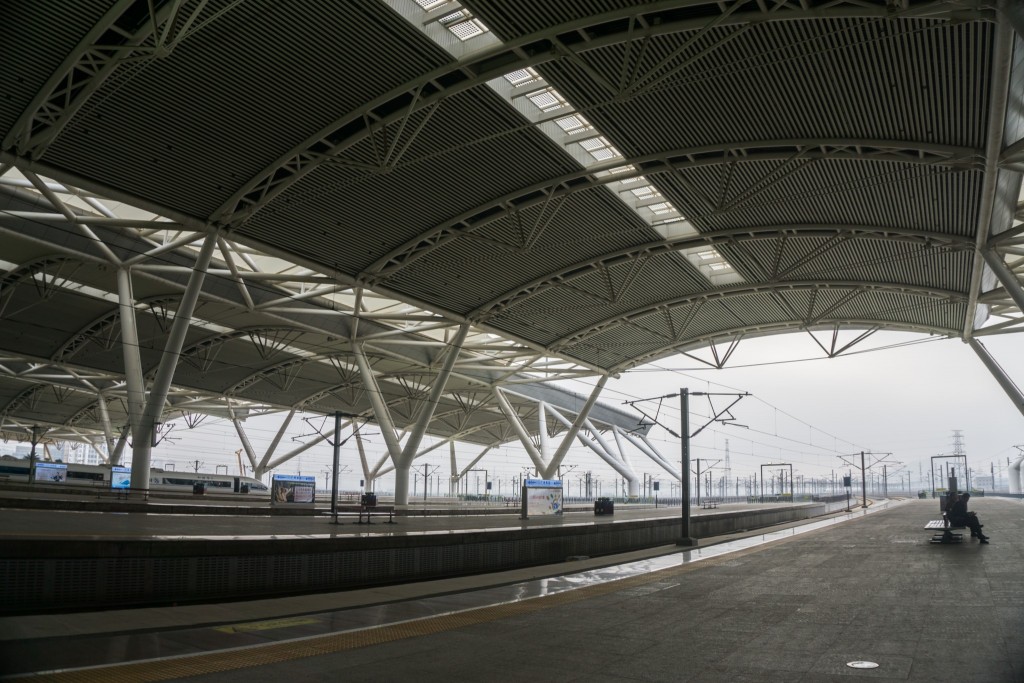
Train Types
There are a few classes of trains in China, each ranging in seat type, services offered, speed, and overall cleanliness. Here's a quick run-down of your options:
High-speed Rail
- Modern & clean
- Cover large distances
- Are fast (up to 300km/hr!)
- Non-smoking in entire train (enforced)
- Assigned seating (enforced)
“Regular” trains
- Cheaper than high-speed (often the older version of current high-speed trains)
- Fairly clean
- Non-smoking except between cars
Overnight/ Sleeper Trains
- Provides a “free” night of accommodation
- Fairly comfortable & affordable
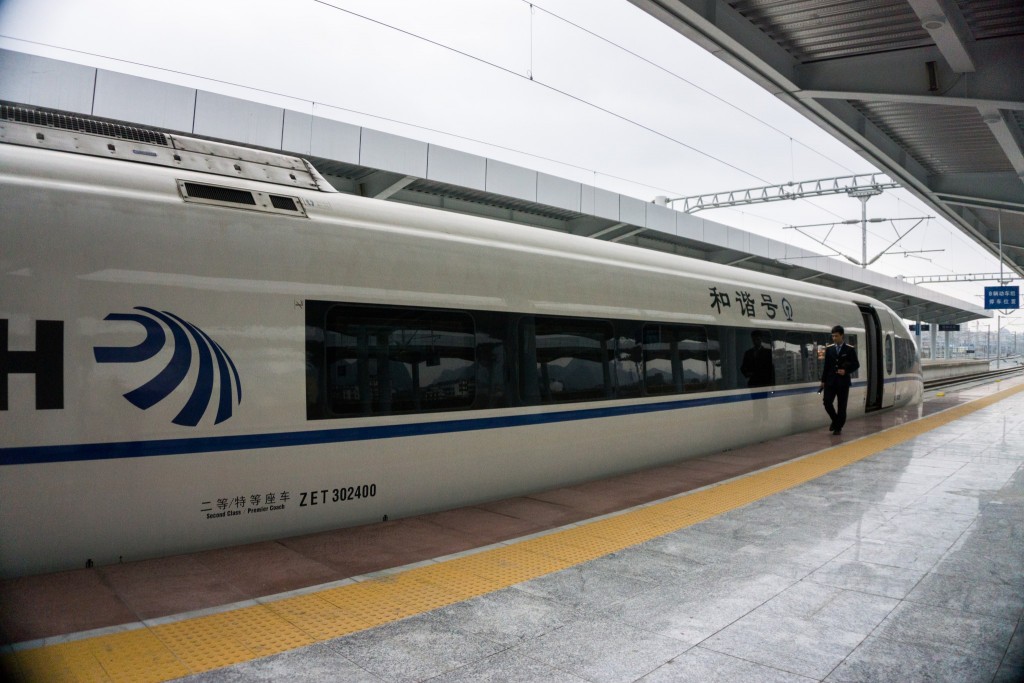
China is well serviced by trains, with connections between major cities and even remote locations including Mongolia. Simply search your Point A to B via sites like C-Trip (more on that below), and you'll very likely find a number of trains servicing that route.
How to Buy China Train Tickets
C-Trip is another user-friendly option that we mostly used throughout our travels in China. The website's English is decent, it has competitive pricing, plus a rewards program that earned us ~$40 USD back which we used on accommodation. Tickets can be bought with credit or Paypal, then pick up at the train station ticket office
You can buy tickets at the train station ticket counters. Take note, the self-service “English” machines won't accept non-Chinese cards, and often aren't fully English anyway, so just approach any of the ticket counters. It's helpful to have the name of your destination in Chinese in case of potential language barriers. As always in China, bring your passport .
You could also buy train tickets from a travel agency (they are abundant in China), simply ask your hotel or Tourist Information Centre.
Train Classes
Once you look to buy tickets, you'll notice there's several classes to choose from, indicated by letters. Here's what those letters mean:
- C, D & G trains : China's best high-speed trains. They're modern, air-conditioned, and most run at 200-300km/hr. Most overnight D-trains are older versions of the high-speed train.
- Z trains : now second best, these were previously China's greatest quality high-speed sleeper trains. Fairly modern with air conditioning.
- T trains : these are the next best after Z trains. Much older models but still functional.
- K trains : these aren't as quick as high-speed trains but are still “fast”, and as such are higher-priced.
Overnight Sleeper Train Types: A Comparison
Upon booking an overnight train, you'll notice there are several seat options. Here's a quick breakdown of what each entails.
Hard Sleeper
- Cheapest ticket type (and despite the name, isn't actually hard)
- Has thinner sleeping mattresses than the “soft” ones
- Shared compartment/room without doors
- 6 bunks per compartment
Soft Sleeper
- Cheaper ticket type
- Thicker sleeping mattresses
- Shared compartment/room without doors
- 4 bunks per compartment
Private Rooms
- Priciest ticket type
- 2 bunk compartment
- Some have a private toilet (which sells out FAST)
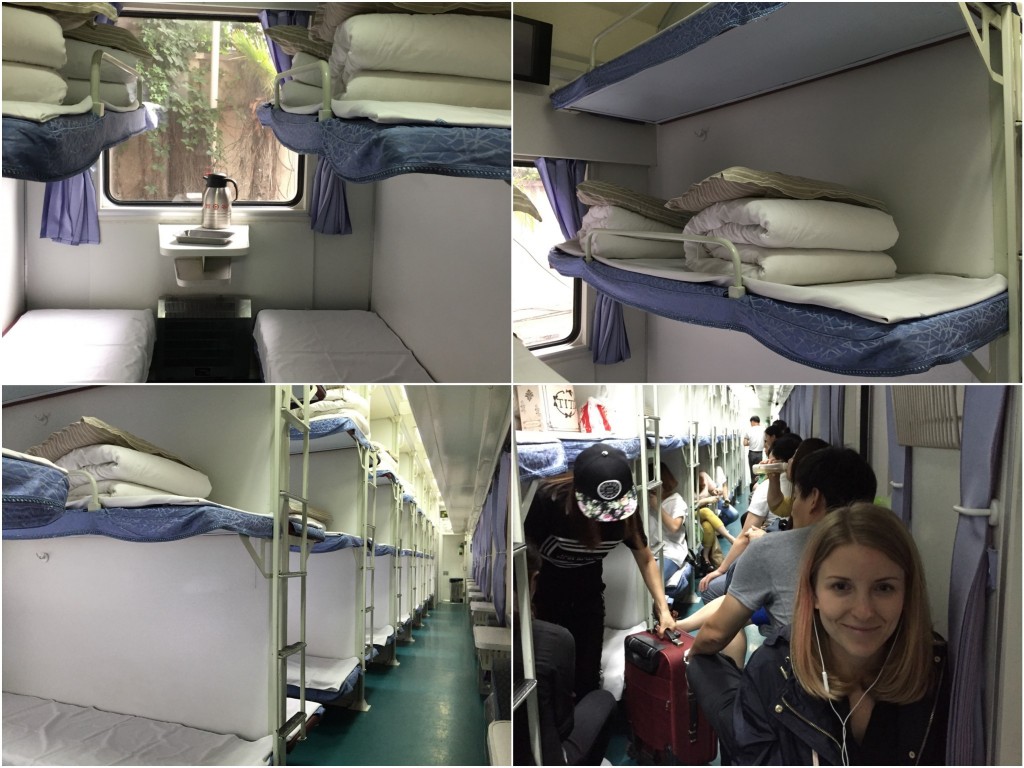
We've taken all of China's train types – overnight, regular, and high-speed. We were pleasantly surprised by the overnight train experience in the “hard” sleeper class (see above photo). It was quieter and cleaner than expected, and felt like sleeping in a hostel dorm. Some points worth noting:
- There are no seats (besides your bed), except for 2 tiny hard seats per aisle for the 6 bunks (see photo at end of article). If you're lucky enough to have the bottom bunk (which is the only one tall enough to sit upright in), it also has its own mini table.
- There isn't anywhere to lock your belongings but there is a shelf where everyone puts their bags. Theft seems to not be a concern, but we did sleep with our valuables (phone etc) in our beds to be safe.
- There are no doors to the compartments, but there are curtains on the windows.
- Lights are turned off automatically at 10PM & people generally are quiet after this time
- The bottom bunk has the most space (you can actually sit up in it), whereas the top two above it you cannot sit upright
China's trains mostly have squat toilets, but are fairly clean with a washing station outside the bathroom. Be sure to bring toilet paper & soap or sanitizer (as you should everywhere in China!).
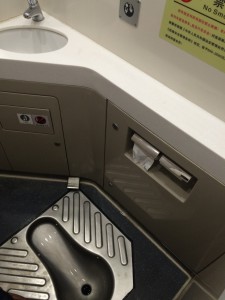
Some overnight trains have a restaurant car, it depends on the class. Snack carts regularly go by with overpriced food, snacks and bottled drinks. No coffee though except instant on high-speed trains, at a hefty 40 RMB/cup (~$6 USD!).
Nearly all Chinese trains have free water dispensers that dispense hot water only . So if instant coffee, tea, or instant noodles are your thing, bring 'em along!
Note : free bottles of mineral water are offered at train stations for certain train classes. Simply show your ticket and see if you’re eligible (or if you speak Chinese, just ask!).
Reading Your Train Ticket
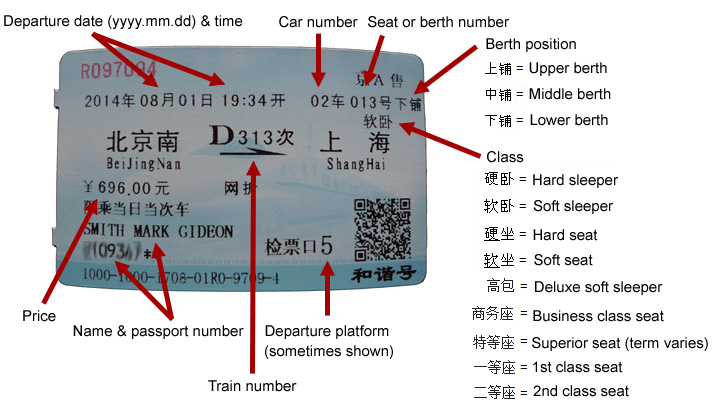
Seat61 has made this great translation picture to help you decipher your ticket. That being said, even without this you'll still be able to ask staff to help you figure your seat and platform out.
Avoiding Headaches & Mishaps
- Give lots of buffer time for train ticket pick-up/boarding – Chinese train stations are HUGE .
- Always bring your passport.
- Check ticket availability online in advance to avoid disappointment. Tickets can sell out in high season (July/Aug).
- All train stations in China involve a security check . Yep, even public subway stations, too. Give yourself LOTS of buffer time to put your bags through x-ray machines, possibly be patted down and maybe have your bags pried through – much like airport security. If you're carrying bottled drinks, you'll be asked to drink them to prove they don't contain harmful contents.
- Eat before boarding & pack snacks. Food is quite inflated on Chinese trains, so it pays to pack food if you can. Convenience/grocery stores have pre-made sandwiches, noodle boxes, or salads. Most train stations have noodle restaurants inside if you want to eat pre-boarding.
- Pack headphones and/or ear plugs . You'll likely need it to block out the movies people watch without headphones and general noisy conversation (though our overnight experience was surprisingly tranquil).
- Bring layers of clothing . You never know if a train will be overly air-conditioned or stiflingly hot. I always wear loose layers for long rides, with easy options to add on if I’m too cold.
And there you have it, (just about) everything you need to know for train travel in China. Having done China's long-distance buses and budget airlines, I'd definitely say train travel is our preference. If you've got a long trip, have the extra pocket cash, or are low on travel sanity, the trains are absolutely worth it.
Questions, comments or info to add? Don't be shy, ask away!
Leave a Reply Cancel reply
Your email address will not be published. Required fields are marked *
- 86-19138970032 (GMT+8 18:00~09:00)

- Beijing Xian Tours
- Shanghai Beijing Tours
- Hong Kong Guilin Tours
- Hangzhou Suzhou Tours
- Kunming Lijiang Tours
- Shanghai Yangtze Cruise Tours
- Chengdu Tibet Tours
- More Short Stay Tours
- China Tours in January
- China Tours in February
- China Tours in March
- China Tours in April
- China Tours in May
- China Tours in June
- China Tours in July
- China Tours in August
- China Tours in September
- China Tours in October
- China Tours in November
- China Tours in December

- High Speed Trains
- China Yangtze Cruise Tour
- Photography
- Desert Adventure
- Ethnic Villages
- Biking Tours
- Kung Fu Tours
- Heritage Sites Exploration
- China Spring Tours
- China Summer Tours
- China Autumn Tours
- China Winter Tours
Notice! 2024 available cruise routes include 4~5 days Chongqing-Yichang(most classic) and 11~12 days Chongqing-Yichang-Shanghai(limited).

- Best-value Yangtze Cruises
- Top Family-friendly Cruise Ships
- Top 3 Luxury Yangtze River Cruises
- Yangtze River Highlights
- Yangtze River Cruise Routes
- Upstream or Downstream?
- Dining & Drinking
- Accommodations
- On-board Activities
- Yangtze Cruise Booking Steps

- Inner Mongolia

- Fanjingshan
- How to Plan Your First China Tour
- How to Plan Beijing Tour
- How to Plan Xian Tour
- How to Plan Shanghai Tour
- How to Plan Guilin Tour
- How to Plan Sichuan Tour
- How to Plan Family Tour
- 2024 China Travel Ideas
- Best Time to Visit China
- What to Pack for Your China Journey
- Updated China Travel News
- Ultimate Chinese Visa Guide
- Chinese Visa Types
- Chinese Visa Requirements
- Do I Need a Visa for China
- Chinese Visa Application
- Chinese Visa Exemptions
- 144-hour Visa Free
- Shenzhen Visa on Arrival
- Hainan 30-day Visa Free
- Embassies & Consulates
- Invitation Letter
- Useful Visa FAQs & Tips
- Entry Regulations
- Baggage Allowance
- Customs Declaration
- Exit Regulation
- How to Book Train Tickets
- How to Collect Train Tickets
- How to Cancel & Alter Train Tickets
- How to Read Train Tickets
- China High Speed Train Types
- Seats Class & How to Choose
- Friendly Facilities on the Train
- The Train Station Departure Process
- Available Food and Drinks on the Train
- Western Toilets on the Train
- Luggage Racks & Baggage Allowance
- Beijing Train Stations
- Shanghai Train Stations
- Guilin Train Stations
- Xian Train Stations
- Chengdu Train Stations
- Hong Kong West Kowloon Railway Station
- Beijing - Xian
- Beijing - Shanghai
- Guangzhou - Shanghai
- Shenzhen - Shanghai
- Chengdu - Xian
- Shanghai - Hangzhou
- Shanghai - Xian
- Chengdu - Chongqing
- Kunming - Lijiang
- Beijing Capital International
- Beijing Daxing International
- Shanghai Pudong International
- Shanghai Hongqiao International
- Guangzhou Baiyun International
- Hangzhou Xiaoshan International
- Chengdu Tianfu International
- Chengdu Shuangliu International
- Xian Xianyang International
- Shanghai - Beijing
- Hong Kong - Shanghai
- Guangzhou - Beijing
- Chengdu - Lhasa
- Shanghai - Guilin
- Shanghai - Sanya
- Travel in Spring Season
- Travel in Summer Season
- Travel in Autumn Season
- Travel in Winter Season
- Weather in January
- Weather in February
- Weather in March
- Weather in April
- Weather in May
- Weather in June
- Weather in July
- Weather in August
- Weather in September
- Weather in October
- Weather in November
- Weather in December
- Top 10 China Destinations
- Top 15 Things to Do
- China World Heritage Sites
- Top 10 Best Natural Beauties
- Top 10 Museums in China
- Top 10 Old Towns & Villages
- Five Great Mountains in China
- Top 10 Monasteries & Temples
- Top 10 Ski Resorts
- Top 10 Beautiful Lakes in China
- 7 Best Beaches in Sanya
- Top 6 Beautiful Waterfalls
- Panda Volunteering
- Having fun on Ice and Snow Festival
- About Us Who We Are Our Team Why Travel with Us Feedback & Reviews Travel Stories Travelers' Gallery Payment Guide Customer Support Contact Us
- Tour Experiences
Destinations
- Travel Guide
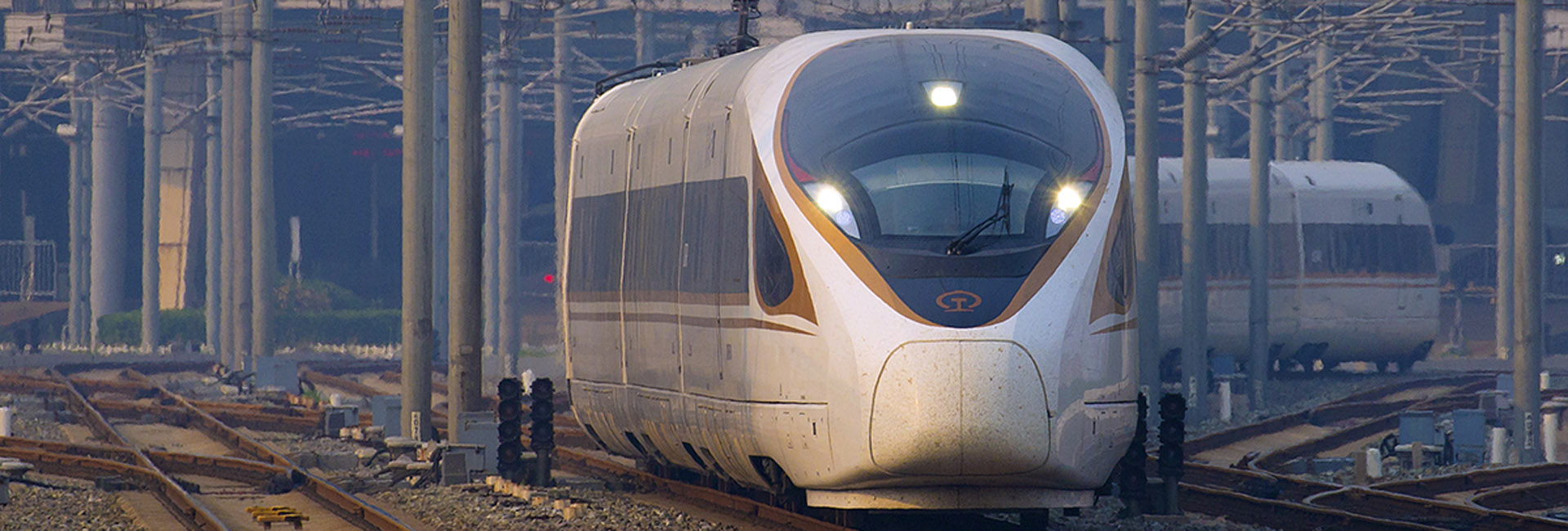
Updated China Train Schedules and Routes 2024
More than 500 cities in China can be traveled by high speed trains now. Check below top high speed rail routes, and clink into find more details.
High Speed Trains Departing from Beijing
High speed trains departing from shanghai, high speed trains departing from hong kong, high speed trains departing from guilin, high speed trains departing from xian, high speed trains departing from chengdu, high speed trains departing from guangzhou, high speed trains departing from shenzhen, high speed trains departing from chongqing, high speed trains departing from kunming.
Please Note: The above information about Fuxing Trains are only for your reference, details may be slightly changed according to practical situation, feel free to contact our professional travel expert for the latest and detailed information for help.
- Chengdu to Beijing Trains
- Beijing to Chengdu Trains
- Beijing to Chongqing Trains
- Chongqing to Beijing Trains
- Beijing to Guilin Trains
- Guilin to Beijing Trains
- Beijing to Kunming Trains
- Kunming to Beijing Trains
- Beijing to Huangshan Trains
- Huangshan to Beijing Trains
- Beijing to Hangzhou Trains
- Hangzhou to Beijing Trains
- Beijing to Suzhou Trains
- Suzhou to Beijing Trains
- Beijing to Nanjing Travel
- Nanjing to Beijing Trains
- Beijing to Changsha Trains
- Changsha to Beijing Trains
- Beijing to Shenzhen Trains
- Shenzhen to Beijing Trains
- Beijing to Guiyang Trains
- Guiyang to Beijing Trains
- Beijing to Xiamen Trains
- Xiamen to Beijing Trains
- Travel from Beijing to Luoyang
- Luoyang to Beijjing Trains
- Beijing to Taiyuan Trains
- Taiyuan to Beijing Trains
- Datong to Beijing Trains
- Beijing to Pingyao Trains
- Pingyao to Beijing
- Beijing to Tianjin Trains
- Tianjin to Beijing Trains
- Shanghai to Chengdu
- Chengdu to Shanghai Trains
- Shanghai to Guilin Trains
- Guilin to Shanghai Trains
- Shanghai to Shenzhen Trains
- Shenzhen to Shanghai
- Shanghai to Huangshan Trains
- Huangshan to Shanghai Trains
- Shanghai to Yichang Trains
- Yichang to Shanghai Trains
- Shanghai to Chongqing Trains
- Chongqing to Shanghai Trains
- Shanghai to Nanjing Travel
- Nanjing to Shanghai
- Shanghai to Changsha Trains
- Changsha to Shanghai Trains
- Changsha to Shaoshan Trains
- Shaoshan to Changsha Trains
- Shanghai to Guiyang Trains
- Guiyang to Shanghai Trains
- Shanghai to Xiamen Trains
- Xiamen to Shanghai Trains
- Shanghai to Luoyang Travel
- Luoyang to Shanghai Trains
- Shanghai to Tianjin Trains
- Tianjin to Shanghai Trains
- Chengdu to Kunming Trains
- Kunming to Chengdu Trains
- Chengdu to Leshan Trains
- Leshan to Chengdu Trains
- Chengdu to Emeishan Trains
- Emeishan to Chengdu Trains
- Chengdu to Dujiangyan Trains
- Dujiangyan to Chengdu Trains
- Chengdu to Guilin Trains
- Guilin to Chengdu Trains
- Chengdu to Luoyang Trains
- Luoyang to Chengdu Trains
- Chengdu to Kaifeng Trains
- Kaifeng to Chengdu Trains
- Guilin to Guiyang Trains
- Guiyang to Guilin Trains
- Guilin to Guangzhou Trains
- Guangzhou to Guilin Trains
- Guilin to Changsha Trains
- Changsha to Guilin Trains
- Guilin to Chongqing Trains
- Chongqing to Guilin Trains
- Hangzhou to Suzhou Trains
- Suzhou to Hangzhou Trains
- Chongqing to Wuhan Trains
- Wuhan to Chongqing Trains
- Chongqing to Kunming Trains
- Kunming to Chongqing Trains
- Xian to Pingyao Trains
- Pingyao to Xian Trains
- Xian to Beijing Trains
- Beijing to Xian Trains
- Xian to Shanghai Trains
- Shanghai to Xian Trains
- Xian to Guangzhou Trains
- Guangzhou to Xian Trains
- Xian to Shenzhen Trains
- Shenzhen to Xian Trains
- Xian to Kunming Trains
- Kunming to Xian Trains
- Xian to Chengdu Trains
- Chengdu to Xian Trains
- Xian to Guiyang Trains
- Guiyang to Xian Trains
- Xian to Luoyang Travel
- Luoyang to Xian Trains
- Xian to Taiyuan Trains
- Taiyuan to Xian Trains
- Xian to Zhengzhou Trains
- Zhengzhou to Xian Trains
- Zhengzhou to Shenyang Trains
- Shenyang to Zhengzhou Trains
- Qingdao to Shenyang Trains
- Shenyang to Qingdao Trains
- Xian to Xining Trains
- Xining to Xian Trains
- Xian to Lanzhou Trains
- Lanzhou to Xian Trains
- Xian to Wuhan Trains
- Wuhan to Xian Trains
- Xian to Chongqing Trains
- Chongqing to Xian Trains
- Chongqing to Chengdu Trains
- Chengdu to Chongqing Trains
- Chengdu to Wuhan Trains
- Wuhan to Chengdu Trains
- Chengdu to Yichang Trains
- Yichang to Chengdu Trains
- Chengdu to Guiyang Trains
- Guiyang to Chengdu Trains
- Chengdu to Zhengzhou Trains
- Zhengzhou to Chengdu Trains
- Pingyao to Chengdu Trains
- Chengdu to Taiyuan Trains
- Taiyuan to Chengdu Trains
- Chengdu to Tianjin Trains
- Tianjin to Chengdu Trains
- Chengdu to Hangzhou Trains
- Hangzhou to Chengdu Trains
- Chengdu to Suzhou Trains
- Suzhou to Chengdu Trains
- Chengdu to Jinan Trains
- Jinan to Chengdu Trains
- Chengdu to Changsha Trains
- Changsha to Chengdu Trains
- Chengdu to Guangzhou Trains
- Guangzhou to Chengdu Trains
- Chengdu to Lhasa Trains
- Lhasa to Chengdu Trains
- Beijing to Lhasa Trains
- Lhasa to Beijing Trains
- Xian to Lhasa Trains
- Lhasa to Xian Trains
- Xining to Lhasa Trains
- Lhasa to Xining Trains
- Yichang to Zhangjiajie Trains
- Zhangjiajie to Yichang Trains
- Zhangjiajie to Changsha Trains
- Changsha to Zhangjiajie Trains
- Kunming to Dali Trains
- Dali to Kunming Trains
- Kunming to Lijiang Trains
- Lijiang to Kunming Trains
- Guangzhou to Beijing Trains
- Beijing to Guangzhou Trains
- Guangzhou to Shanghai Trains
- Shanghai to Guangzhou Trains
- Guangzhou to Shenzhen Trains
- Shenzhen to Guangzhou Trains
- Guangzhou to Hangzhou Trains
- Hangzhou to Guangzhou Trains
- Guangzhou to Nanjing Trains
- Nanjing to Guangzhou Trains
- Guangzhou to Wuhan Trains
- Lhasa to Nyingchi
- Wuhan to Guangzhou Trains
- Nyingchi to Lhasa
- Guangzhou to Yichang Trains
- Yichang to Guangzhou Trains
- Guangzhou to Guiyang Trains
- Guiyang to Guangzhou Trains
- Guangzhou to Kunming Trains
- Kunming to Guangzhou Trains
- Guangzhou to Zhengzhou Trains
- Zhengzhou to Guangzhou Trains
- Guangzhou to Tianjin Trains
- Tianjin to Guangzhou Trains
- Guangzhou to Qingdao Trains
- Qingdao to Guangzhou Trains
- Guangzhou to Chongqing Trains
- Chongqing to Guangzhou Trains
- Guangzhou to Huangshan Trains
- Huangshan to Guangzhou Trains
- Shenzhen to Guilin Trains
- Guilin to Shenzhen Trains
- Shenzhen to Xiamen Trains
- Xiamen to Shenzhen Trains
- Shenzhen to Hangzhou Trains
- Hangzhou to Shenzhen Trains
- Shenzhen to Suzhou Trains
- Suzhou to Shenzhen Trains
- Shenzhen to Nanjing Trains
- Nanjing to Shenzhen Trains
- Shenzhen to Wuhan Trains
- Wuhan to Shenzhen Trains
- Shenzhen to Yichang Trains
- Yichang to Shenzhen Trains
- Shenzhen to Guiyang Trains
- Guiyang to Shenzhen Trains
- Shenzhen to Kunming Trains
- Kunming to Shenzhen Trains
- Shenzhen to Zhengzhou Trains
- Zhengzhou to Shenzhen Trains
- Shenzhen to Chongqing Trains
- Chongqing to Shenzhen Trains
- Shenzhen to Huangshan Trains
- Huangshan to Shenzhen Trains
- Chongqing to Xiamen Trains
- Xiamen to Chongqing Trains
- Chongqing to Hangzhou Trains
- Hangzhou to Chongqing Trains
- Chongqing to Suzhou Trains
- Suzhou to Chongqing Trains
- Chongqing to Yichang Trains
- Yichang to Chongqing Trains
- Chongqing to Guiyang Trains
- Guiyang to Chongqing Trains
- Chongqing to Zhengzhou Trains
- Zhengzhou to Chongqing Trains
- Chongqing to Tianjin Trains
- Tianjin to Chongqing Trains
- Chongqing to Qingdao Trains
- Qingdao to Chongqing Trains
- Chongqing to Nanjing Trains
- Nanjing to Chongqing Trains
- Kunming to Guilin Trains
- Guilin to Kunming Trains
- Kunming to Shanghai Trains
- Shanghai to Kunming Trains
- Kunming to Xiamen Trains
- Xiamen to Kunming Trains
- Kunming to Hangzhou Trains
- Hangzhou to Kunming Trains
- Kunming to Suzhou Trains
- Suzhou to Kunming Trains
- Kunming to Nanjing Trains
- Nanjing to Kunming Trains
- Kunming to Wuhan Trains
- Wuhan to Kunming Trains
- Kunming to Guiyang Trains
- Guiyang to Kunming Trains
- Kunming to Zhengzhou Trains
- Zhengzhou to Kunming Trains
- Kunming to Huangshan Trains
- Huangshan to Kunming Trains
- Wuhan to Yichang Trains
- Yichang to Wuhan Trains
- Wuhan to Wudangshan Trains
- Wudangshan to Wuhan Trains
- Xiamen to Huangshan Trains
- Huangshan to Xiamen Trains
- Urumqi to Lanzhou Trains
- Lanzhou to Urumqi
- Haikou to Sanya
- Sanya to Haikou
- Shanghai to Hangzhou Trains
- Hangzhou to Shanghai
- Beijing to Shanghai Trains
- Shanghai to Beijing Trains
- Shanghai to Suzhou Trains
- Suzhou to Shanghai Trains
- Beijing to Harbin Trains
- Harbin to Beijing Trains
- Hangzhou to Huangshan Trains
- Huangshan to Hangzhou Trains
- Guangzhou to Hong Kong Trains
- Hong Kong to Guangzhou Trains
- Beijing to Hong Kong Trains
- Hong Kong to Guilin Trains
- Hong Kong to Shanghai Trains
- Shanghai to Hong Kong Trains
- Guilin to Hong Kong Trains
- Hong Kong to Beijing Trains
- Shanghai to Zhengzhou Trains
- Zhengzhou to Shanghai Trains
- Hohhot to Ordos
- Ordos to Hohhot Trains
- Shanghai to Chizhou Trains
- Chizhou to Shanghai Trains
- Shanghai to Zhangjiajie Trains
- Zhangjiajie to Shanghai Trains
- Zhangjiajie to Guangzhou Trains
- Guangzhou to Zhangjiajie Trains
- Beijing to Zhangjiajie Trains
- Zhangjiajie to Beijing Trains
- Shanghai to Wuyishan Trains
- Wuyishan to Shanghai Trains
- Xiamen to Wuyishan Trains
- Wuyishan to Xiamen Trains
- Huangshan to WuyishanTrains
- Wuyishan to Huangshan Trains
- Beijing to Wuhan Trains
- Wuhan to Beijing Trains
- Guangzhou to Changsha Trains
- Changsha to Guangzhou Trains
- Xian to Huashan Trains
- Huashan to Xian Trains
- Zhangye to Xian Trains
- Xian to Zhangye Trains
- Xian to Jiayuguan Trains
- Jiayuguan to Xian Trains
- Lanzhou to Zhangye Trains
- Zhangye to Lanzhou Trains
- Xining to Zhangye Trains
- Zhangye to Xining Trains
- Shanghai to Lanzhou Trains
- Lanzhou to Shanghai Trains
- Guiyang to Kaili Trains
- Kaili to Guiyang Trains
- Changsha to Kaili Trains
- Kaili to Changsha Trains
- Hangzhou to Nanjing Trains
- Nanjing to Hangzhou Trains
- Suzhou to Nanjing Travel
- Nanjing to Suzhou Travel
- Hong Kong to Shenzhen Trains
- Shenzhen to Hong Kong Trains
- Hong Kong to Kunming Trains
- Kunming to Hong Kong Trains
- Hong Kong to Hangzhou Trains
- Hangzhou to Hong Kong Trains
- Hong Kong to Guiyang Trains
- Guiyang to Hong Kong Trains
- Hong Kong to Wuhan Trains
- Wuhan to Hong Kong Trains
- Hong Kong to Xiamen Trains
- Xiamen to Hong Kong Trains
- Hong Kong to Changsha Trains
- Changsha to Hong Kong Trains
- Chengdu to Yaan Trains
- Yaan to Chengdu Trains
- Dali to Lijiang Trains
- Lanzhou to Chongqing Trains
- Chongqing to Lanzhou Trains
- Chengdu to Xiamen Trains
- Xiamen to Chengdu Trains
- Jinan to Qingdao Travel
- Qingdao to Jinan Trains
- Fuzhou to Guilin Trains
- Guilin to Fuzhou Trains
- Yangshuo to Shenzhen Trains
- Shenzhen to Yangshuo Trains
- Guangzhou to Yangshuo Trains
- Yangshuo to Guangzhou Trains
- Chengdu to Yangshuo Trains
- Yangshuo to Chengdu Trains
- Nanning to Yangshuo Trains
- Yangshuo to Nanning Trains
- Guilin to Yangshuo Trains
- Yangshuo to Guilin Trains
- Yangshuo to Chongqing Trains
- Chongqing to Yangshuo Trains
- Guiyang to Yangshuo Trains
- Yangshuo to Guiyang Trains
- Xian to Zhangjiajie Trains
- Zhangjiajie to Xian Trains
- Shenzhen to Zhangjiajie Trains
- Zhangjiajie to Shenzhen Trains
- Hangzhou to Zhangjiajie Trains
- Zhangjiajie to Hangzhou Trains
- Kunming to Zhangjiajie Trains
- Zhangjiajie to Kunming Trains
- Nanning to Zhangjiajie Trains
- Zhangjiajie to Nanning Trains
- Wuhan to Zhangjiajie Trains
- Zhangjiajie to Wuhan Trains
- Kunming to Jianshui Trains
- Chengdu to Huaihua Trains
- Huaihua to Chengdu Trains
- Jianshui to Kunming Trains
- Beijing to Qingdao Travel
- Chengdu to Tongren Trains
- Tongren to Chengdu Trains
- Qingdao to Beijing Trains
- Huaihua to Zhangjiajie Trains
- Zhangjiajie to Huaihua Trains
- Zhangjiajie to Tongren Trains
- Tongren to Zhangjiajie Trains
- Chengdu to Lanzhou Trains
- Lanzhou to Chengdu Trains
- Guangzhou to Zhuhai Trains
- Zhuhai to Guangzhou Trains
- Guangzhou to Shantou Trains
- Shantou to GuangzhouTrains
- Guangzhou to Jiangmen Trains
- Jiangmen to Guangzhou Trains
- Guangzhou to Zhongshan Trains
- Zhongshan to Guangzhou Trains
- Guangzhou to Zhaoqing Trains
- Guangzhou to Chaoshan Trains
- Zhaoqing to Guangzhou Trains
- Chaoshan to Guangzhou Trains
- Guangzhou to Foshan Trains
- Foshan to Guangzhou Trains
- Guangzhou to Zhanjiang Trains
- Zhanjiang to Guangzhou Trains
- Guangzhou to Futian Trains
- Futian to Guangzhou Trains
- Guangzhou to Dongguan Trains
- Dongguan to Guangzhou Trains
- Guangzhou to Humen Trains
- Humen to Guangzhou Trains
- Guangzhou to Qingyuan Trains
- Qingyuan to Guangzhou Trains
- Guangzhou to Shaoguan Trains
- Shaoguan to Guangzhou Trains
- Guangzhou to Huizhou Trains
- Huizhou to Guangzhou Trains
- Beijing to Zhangjiakou Trains
- Zhangjiakou to Beijing Trains
- Beijing to Dalian Trains
- Dalian to Beijing Trains
- Beijing to Dandong Trains
- Dandong to Beijing Trains
- Beijing to Hefei Trains
- Hefei to Beijing Trains
- Beijing to Datong Trains
- Beijing to Futian Trains
- Futian to Beijing Trains
- Beijing to Qinhuangdao Trains
- Qinhuangdao to Beijing Trains
- Beijing to Chengde
- Chengde to Beijing Trains
- Beijing to Zhengzhou Trains
- Zhengzhou to Beijing Trains
- Beijing to Yichang Trains
- Yichang to Beijing Trains
- Beijing to Hohhot Transportation
- Hohhot to Beijing Trains
- Beijing to Manzhouli Trains
- Shanghai to Hohhot Trains
- Hohhot to Shanghai Trains
- Hohhot to Jining Trains
- Jining to Hohhot Trains
- Hailar to Hohhot Trains
- Hohhot to Hailar Trains
- Manzhouli to Beijing Trains
- Chengdu to Hohhot Trains
- Hohhot to Chengdu Trains
- Beijing to Nanchang Trains
- Nanchang to Beijing Trains
- Beijing to Nanning Trains
- Nanning to Beijing Trains
- Beijing to Urumqi Trains
- Urumqi to Beijing Trains
- Beijing to Lanzhou Trains
- Lanzhou to Beijing Trains
- Shenzhen to Zhuhai
- Zhuhai to Shenzhen
- Shenzhen to Shantou
- Shantou to Shenzhen
- Shenzhen to Zhongshan
- Zhongshan to Shenzhen
- Shenzhen to Zhaoqing
- Zhaoqing to Shenzhen
- Shenzhen to Chaoshan
- Chaoshan to Shenzhen
- Shenzhen to Foshan
- Foshan to Shenzhen
- Shenzhen to Dongguan
- Dongguan to Shenzhen
- Shenzhen to Humen
- Humen to Shenzhen
- Shenzhen to Qingyuan
- Qingyuan to Shenzhen
- Shenzhen to Shaoguan
- Shaoguan to Shenzhen
- Shenzhen to Huizhou
- Huizhou to Shenzhen
- Zhuhai to Shunde
- Shunde to Zhuhai
- Zhuhai to Foshan
- Foshan to Zhuhai
- Zhuhai to Shaoguan
- Shaoguan to Zhuhai
- Shunde to Jiangmen
- Jiangmen to Shunde
- Shunde to Foshan
- Foshan to Shunde
- Jiangmen to Foshan
- Foshan to Jiangmen
- Foshan to Zhanjiang
- Zhanjiang to Foshan
- Foshan to Zhongshan
- Zhongshan to Foshan
- Foshan to Zhaoqing
- Zhaoqing to Foshan
- Shaoguan to Qingyuan
- Qingyuan to Shaoguan
- Shaoguan to Humen
- Humen to Shaoguan
- Shaoguan to Hong Kong
- Hong Kong to Shaoguan
- Chengdu to Yibin
- Yibin to Chengdu
- Chongqing to Hong Kong
- Hong Kong to Chongqing
- Tianjin to Hong Kong
- Hong Kong to Tianjin
- Nanning to Hong Kong
- Hong Kong to Nanning
- Zhengzhou to Hong Kong
- Hong Kong to Zhengzhou
- Chaoshan to Hong Kong
- Hong Kong to Chaoshan
- Shantou to Hong Kong
- Hong Kong to Shantou
- Zhaoqing to Hong Kong
- Hong Kong to Zhaoqing
- Xian to Emeishan
- Emeishan to Xian
- Chengdu to Xining
- Xining to Chengdu
- Beijing to Shenyang
- Shenyang to Beijing
- Beijing to Xining
- Xining to Beijing
- Shanghai to Hefei
- Hefei to Shanghai
- Shanghai to Lhasa
- Lhasa to Shanghai
- Shanghai to Wenzhou
- Wenzhou to Shanghai
- Shanghai to Wuhan
- Wuhan to Shanghai
- Shanghai to Ningbo
- Hangzhou to Ningbo
- Ningbo to Hangzhou
- Nanjing to Ningbo
- Wuxi to Ningbo
- Fuzhou to Ningbo
- Xiamen to Ningbo
- Changsha to Ningbo
- Wuhan to Ningbo
- Shenzhen to Ningbo
- Xian to Ningbo
- Suzhou to Ningbo
- Ningbo to Suzhou
- Ningbo to Nanjing
- Ningbo to Shanghai
- Shanghai to Wuxi
- Wuxi to Shanghai
- Xian to Hangzhou
- Hangzhou to Xian
- Xian to Guilin
- Guilin to Xian
- Xian to Suzhou
- Suzhou to Xian
- Xian to Tianjin
- Tianjin to Xian
- Guangzhou to Yiwu
- Yiwu to Guangzhou
- Guangzhou to Lhasa
- Lhasa to Guangzhou
- Guangzhou to Nanning
- Nanning to Guangzhou
- Guangzhou to Taizhou
- Taizhou to Guangzhou
- Guangzhou to Xiamen
- Xiamen to Guangzhou
- Beijing to Erlian Ulaanbaatar
- Erlian Ulaanbaatar to Beijing
- Chengdu to Shenzhen
- Shenzhen to Chengdu
- Chengdu to Lijiang
- Lijiang to Chengdu
- Shenzhen to Changsha
- Changsha to Shenzhen
- Lanzhou to Dunhuang
- Dunhuang to Lanzhou
- Guilin to Lijiang
- Shanghai to Liuyuan
- Lijiang to Guilin
- Nanjing to Huangshan (Yellow Mountain)
- Huangshan (Yellow Mountain) to Nanjing
- Nanjing to Wuyuan
- Wuyuan to Nanjing
- Foshan to Hong Kong
- Hong Kong to Foshan
- Baiyangdian (Xiongan New Area) to Hong Kong
- Hong Kong to Baiyangdian (Xiongan New Area)
- Futian to Hong Kong
- Hong Kong to Futian
- Shijiazhuang to Hong Kong
- Hong Kong to Shijiazhuang
- Yueyang to Hong Kong
- Hong Kong to Yueyang
- Handan to Hong Kong
- Hong Kong to Handan
- Hengyang to Hong Kong
- Hong Kong to Hengyang
- Wuzhou to Hong Kong
- Hong Kong to Wuzhou
- Beijing to Jinan
- Jinan to Beijing
- Tianjin to Shenyang
- Shenyang to Tianjin
- Tianjin to Yuncheng
- Yuncheng to Tianjin
- Shenyang to Weihai
- Weihai to Shenyang
- Harbin to Chengde
- Chengde to Harbin
- Shijiazhuang to Jiamusi
- Jiamusi to Shijiazhuang
- Tianjin to Qingdao
- Qingdao to Tianjin
- Tianjin to Harbin
- Harbin to Tianjin
- Harbin to Shanghai
- Shanghai to Harbin
- Harbin to Shenyang
- Jilin to Shenyang
- Shenyang to Jilin
- Changchun to Shenyang
- Shenyang to Changchun
- Shenyang to Harbin
- Harbin to Jilin
- Jilin to Harbin
- Harbin to Mohe
- Mohe to Harbin
- Harbin to Dalian
- Dalian to Harbin
- Harbin to Yabuli
- Yabuli to Harbin
- Qinhuangdao to Shanghai
- Shanghai to Qinhuangdao
- Qinhuangdao to Tianjin
- Tianjin to Qinhuangdao
- Qinhuangdao to Xingtai
- Xingtai to Qinhuangdao
- Shijiazhuang to Beijing
- Beijing to Shijiazhuang
- Shijiazhuang to Shanghai
- Shanghai to Shijiazhuang
- Shijiazhuang to Zhengzhou
- Zhengzhou to Shijiazhuang
- Shijiazhuang to Qingdao
- Qingdao to Shijiazhuang
- Shijiazhuang to Guangzhou
- Guangzhou to Shijiazhuang
- Shijiazhuang to Xian
- Xian to Shijiazhuang
- Shijiazhuang to Tianjin
- Tianjin to Shijiazhuang
- Shijiazhuang to Jinan
- Jinan to Shijiazhuang
- Shijiazhuang to Shenzhen
- Shenzhen to Shijiazhuang
- Guangzhou to Shunde Trains
- Shunde to Guangzhou Trains
- Xian to Nanjing Trains
- Nanjing to Xian Trains
- Xian to Changsha Trains
- Changsha to Xian Trains
- Xian to Urumq Trains
- Urumqi to Xian Trains
- Xian to Xiamen Trains
- Xiamen to Xian Trains
- Huangshan to Xian Trains
- Xian to Huangshan Trains
- Xian to Yanan Trains
- Yanan to Xian Trains
- Xian to Dunhuang Trains
- Dunhuang to Xian Trains
- Qingdao to Xian Trains
- Xian to Qingdao Trains
- Xian to Yichang Trains
- Yichang to Xian Trains
- Shenyang to Xian Trains
- Xian to Shenyang Trains
- Dalian to Xian Trains
- Xian to Dalian Trains
- Jinan to Xian Trains
- Xian to Jinan Trains
- Xian to Yinchuan Trains
- Yinchuan to Xian Trains
- Hohhot to Xian Trains
- Xian to Hohhot Trains
- Beijing to Daxing Airport
- Daxing Airport to Beijing
- Huaihua to Shanghai
- Shanghai to Huaihua
- Zhangjiajie to Zhengzhou Trains
- Zhengzhou to Zhangjiajie Trains
- Zhangjiajie to Tianjin Trains
- Tianjin to Zhangjiajie Trains
- Zhangjiajie to Jishou Trains
- Jishou to Zhangjiajie Trains
- Zhangjiajie to Kaili Trains
- Kaili to Zhangjiajie Trains
- Zhangjiajie to Sanjiang Trains
- Sanjiang to Zhangjiajie Trains
- Zhangjiajie to Suzhou Trains
- Suzhou to Zhangjiajie Trains
- Zhangjiajie to Wuxi Trains
- Wuxi to Zhangjiajie Trains
- Zhangjiajie to Anshun Trains
- Anshun to Zhangjiajie Trains
- Zhangjiajie to Chenzhou Trains
- Chenzhou to Zhangjiajie Trains
- Zhangjiajie to Cili Trains
- Cili to Zhangjiajie Trains
- Zhangjiajie to Changchun Trains
- Changchun to Zhangjiajie Trains
- Zhangjiajie to Shijiazhuang Trains
- Shijiazhuang to Zhangjiajie Trains
- Zhangjiajie to Xiangyang Trains
- Xiangyang to Zhangjiajie Trains
- Zhangjiajie to Jingmen Trains
- Jingmen to Zhangjiajie Trains
- Zhangjiajie to Shangrao Trains
- Shangrao to Zhangjiajie Trains
- Zhangjiajie to Zhanjiang Trains
- Zhanjiang to Zhangjiajie Trains
- Zhangjiajie to Shaoguan Trains
- Shaoguan to Zhangjiajie Trains
- Beijing to Huashan Trains
- Huashan to Beijing Trains
- Shanghai to Huashan Trains
- Huashan to Shanghai Trains
- Tianjin to Huashan Trains
- Huashan to Tianjin Trains
- Huashan to Luoyang Trains
- Luoyang to Huashan Trains
- Huashan to Zhengzhou Trains
- Zhengzhou to Huashan Trains
- Lanzhou to Huashan Trains
- Huashan to Lanzhou Trains
- Huashan to Baoji Trains
- Baoji to Huashan Trains
- Nanjing to Huashan Trains
- Huashan to Nanjing Trains
- Chongqing to Huashan Trains
- Huashan to Chongqing Trains
- Chengdu to Huashan Trains
- Huashan to Chengdu Trains
- Huashan to Changsha Trains
- Changsha to Huashan Trains
- Guangzhou to Huashan Trains
- Huashan to Guangzhou Trains
- Huashan to Shenzhen Trains
- Shenzhen to Huashan Trains
- Hangzhou to Huashan Trains
- Huashan to Hangzhou Trains
- Huashan to Suzhou Trains
- Suzhou to Huashan Trains
- Wuhan to Huashan Trains
- Huashan to Wuhan Trains
- Shenyang to Huashan Trains
- Huashan to Shenyang Trains
- Beijing to Zhangye Trains
- Zhangye to Beijing Trains
- Jiayuguan to Zhangye Trains
- Zhangye to Jiayuguan Trains
- Dunhuang to Zhangye Trains
- Zhangye to Dunhuang Trains
- Zhangye to Urumqi
- Urumqi to Zhangye Trains
- Tongren to Guiyang
- Guiyang to Tongren
- Tongren to Chongqing
- Chongqing to Tongren
- Tongren to Guangzhou
- Guangzhou to Tongren
- Tongren to Kaili
- Kaili to Tongren
- Tongren to Changsha
- Changsha to Tongren
- Tongren to Huaihua
- Huaihua to Tongren
- Tongren to Shanghai
- Shanghai to Tongren
- Tongren to Hangzhou
- Hangzhou to Tongren
- Tongren to Shenzhen
- Shenzhen to Tongren
- Liuyuan to Urumqi
- Urumqi to Liuyuan
- Jiayuguan to Dunhuang
- Dunhuang to Jiayuguan Trains
- Beijing to Dunhuang Trains
- Dunhuang to Beijing Trains
- Dunhuang to Turpan
- Turpan to Dunhuang Trains
- Lanzhou to Jiayuguan Trains
- Jiayuguan to Lanzhou Trains
- Urumqi to Dunhuang Trains
- Dunhuang to Urumqi
- Kashgar to Dunhuang Trains
- Dunhuang to Kashgar
- Xian to Tianshui Trains
- Tianshui to Xian Trains
- Tianshui to Zhangye Trains
- Zhangye to Tianshui Trains
- Dunhuang to Guazhou Trains
- Guazhou to Dunhuang Trains
- Jiayuguan to Guazhou Trains
- Guazhou to Jiayuguan Trains
- Beijing to Jiayuguan Trains
- Jiayuguan to Beijing Trains
- Jiayuguan to Turpan Trains
- Turpan to Jiayuguan Trains
- Jiayuguan to Urumqi Trains
- Urumqi to Jiayuguan Trains
- Jiayuguan to Kashgar Trains
- Kashgar to Jiayuguan Trains
- Xining to Lanzhou Trains
- Lanzhou to Xining Trains
- Tianshui to Jiayuguan Trains
- Jiyuguan to Tianshui Trains
- Xining to Jiayuguan Trains
- Jiayuguan to Xining Trains
- Guilin to Wuhan Trains
- Wuhan to Guilin Trains
- Guilin to Nanning Trains
- Nanning to Guilin Trains
- Guilin to Hangzhou Trains
- Hangzhou to Guilin Trains
- Shanghai to Kaifeng Trains
- Kaifeng to Shanghai Trains
- Suzhou to Zhengzhou Trains
- Zhengzhou to Suzhou Trains
- Beijing to Wuyishan Trains
- Wuyishan to Beijing Trains
- Beijing to Weifang Trains
- Weifang to Beijing Trains
- Beijing to Yiwu Trains
- Yiwu to Beijing Trains
- Zhangjiakou to Hohhot Trains
- Hohhot to Zhangjiakou Trains
- Zhangjiakou to Datong Trains
- Datong to Zhangjiakou Trains
- Ningxia Yinchuan to Zhongwei Trains
- Ningxia Zhongwei to Yinchuan Trains
- Datong to Xian Trains
- Xian to Datong Trains
- Taiyuan to Datong Trains
- Datong to Taiyuan Trains
- Datong to Pingyao Trains
- Pingyao to Datong Trains
- Panzhihua to Kunming Trains
- Kunming to Panzhihua Trains
- Suzhou to Huangshan Trains
- Huangshan to Suzhou Trains
- Qingdao to Nanjing Trains
- Nanjing to Qingdao Trains
- Shanghai to Shenyang Trains
- Shenyang to Shanghai Trains
- Shenzhen to Wenzhou Trains
- Wenzhou to Shenzhen Trains
- Nanning to Kunming Trains
- Kunming to Nanning Trains
- Qingdao to Weihai Trains
- Weihai to Qingdao Trains
- Jinan to Guangzhou Trains
- Guangzhou to Jinan Trains
- Hong Kong to Nanchang Trains
- Nanchang to Hong Kong Trains
- Shanghai to Yantai Trains
- Yantai to Shanghai Trains
- Shanghai to Fuzhou Trains
- Fuzhou to Shanghai Trains
- Shenyang to Dandong Trains
- Dandong to Shenyang Trains
- Nanning to Shenzhen Trains
- Shenzhen to Nanning Trains
- Wuxi to Suzhou Trains
- Suzhou to Wuxi Trains
- Shanghai to Foshan Trains
- Foshan to Shanghai Trains
- Shanghai to Dongguan Trains
- Dongguan to Shanghai Trains
- Suzhou to Guangzhou Trains
- Guangzhou to Suzhou Trains
- Fuzhou to Wuyishan Trains
- Wuyishan to Fuzhou Trains
- Shanghai to Nanchang Trains
- Nanchang to Shanghai Trains
- Shanghai to Kaili Trains
- Kaili to Shanghai Trains
- Kunming to Kaili Trains
- Kaili to Kunming Trains
- Kunming to Changsha Trains
- Changsha to Kunming Trains
- Kunming to Nanchang Trains
- Nanchang to Kunming Trains
- Chengdu to Zunyi Trains
- Zunyi to Chengdu Trains
- Guangzhou to Ningbo Trains
- Ningbo to Guangzhou Trains
- Shanghai to Kunshan Trains
- Kunshan to Shanghai Trains
- Guangzhou to Jieyang Trains
- Jieyang to Guangzhou Trains
- Chengdu to Zhangjiajie Trains
- Zhangjiajie to Chengdu Trains
- Beijing to Changchun Trains
- Changchun to Beijing Trains
- Guangzhou to Wenzhou Trains
- Wenzhou to Guangzhou Trains
- Guangzhou to Fuzhou Trains
- Fuzhou to Guangzhou Trains
- Guangzhou to Haikou Trains
- Haikou to Guangzhou Trains
- Shanghai to Qingdao Trains
- Qingdao to Shanghai Trains
- Hong Kong to Humen Trains
- Humen to Hong Kong Trains
- Beijing to Fuzhou Trains
- Fuzhou to Beijing Trains
- Guangzhou to Quanzhou Trains
- Shanghai to Urumqi Trains
- Urumqi to Shanghai Trains
- Beijing to Wuxi Trains
- Wuxi to Beijing Trains
- Beijing to Yantai Trains
- Yantai to Beijing Trains
- Beijing to Sanya Trains
- Sanya to Beijing Trains
- Fuzhou to Shenzhen Trains
- Shenzhen to Fuzhou Trains
- Shanghai to Linyi Trains
- Linyi to Shanghai Trains
- Shanghai to Shaoxing Travel
- Shaoxing to Shanghai
- Beijing to Ningbo Trains
- Ningbo to Beijing Trains
- Wuhan to Nanjing Trains
- Nanjing to Wuhan Trains
- Taiyuan to Pingyao Trains
- Pingyao to Taiyuan Trains
- Hohhot to Ulanqab Trains
- Hohhot to Hulunbuir Trains
- Beijing to Hulunbuir Trains
- Hohhot to Bayannur Trains
- Bayannur to Hohhot Trains
- Ulanqab to Hohhot Trains
- Ulanqab to Baotou Trains
- Hohhot to Baotou Travel
- Baotou to Hohhot Trains
- Hefei to Huangshan Trains
- Huangshan to Hefei Trains
- Fuzhou to Huangshan Trains
- Huangshan to Fuzhou Trains
- Lanzhou to Huangshan Trains
- Huangshan to Lanzhou Trains
- Qingdao to Huangshan Trains
- Huangshan to Qingdao Trains
- Jixi to Huangshan Trains
- Huangshan to Jixi Trains
- Huangshan to Jingdezhen Trains
- Jingdezhen to Huangshan Trains
- Jingdezhen to Guangzhou Trains
- Guangzhou to Jingdezhen Trains
- Shanghai to Jingdezhen Trains
- Jingdezhen to Shanghai Trains
- Wuhan to Huangshan Trains
- Huangshan to Wuhan Trains
- Zhengzhou to Huangshan Trains
- Huangshan to Zhengzhou Trains
- Qiandaohu to Huangshan Trains
- Huangshan to Qiandaohu Trains
- Jinan to Huangshan Trains
- Huangshan to Jinan Trains
- Tianjin to Huangshan Trains
- Huangshan to Tianjin Trains
- Chongqing to Wulong
- Wulong to Chongqing
- Chongqing to Dazu
- Dazu to Chongqing
- Chengdu to Nanning Trains
- Nanning to Chengdu Trains
- Chengdu to Qingdao Trains
- Qingdao to Chengdu Trains
- Chengdu to Urumqi Trains
- Urumqi to Chengdu Trains
- Chengdu to Zhuhai Trains
- Zhuhai to Chengdu Trains
- Chengdu to Harbin Trains
- Harbin to Chengdu Trains
- Chengdu to Ningbo Trains
- Ningbo to Chengdu Trains
- Chengdu to Yiwu Trains
- Yiwu to Chengdu Trains
- Chengdu to Fuzhou Trains
- Fuzhou to Chengdu Trains
- Chengdu to Kashgar Trains
- Kashgar to Chengdu Trains
- Chengdu to Liuyuan Trains
- Liuyuan to Chengdu Trains
- Hefei to Chengdu Trains
- Chengdu to Hefei Trains
- Chengdu to Mount Qingcheng Trains
- Mount Qingcheng to Chengdu Trains
- Chengdu to Mianyang Trains
- Mianyang to Chengdu Trains
- Chengdu to Guanghan Trains
- Guanghan to Chengdu Trains
- Chengdu to Guangyuan Trains
- Guangyuan to Chengdu Trains
- Chengdu to Pengshan Trains
- Pengshan to Chengdu Trains
- Chengdu to Meishan Trains
- Meishan to Chengdu Trains
- Chengdu to Nanchong Trains
- Nanchong to Chengdu Trains
- Chengdu to Neijiang Trains
- Neijing to Chengdu Trains
- Chengdu to Suining Trains
- Suining to Chengdu Trains
- Chengdu to Jiangyou Trains
- Jiangyou to Chengdu Trains
- Chengdu to Deyang Trains
- Deyang to Chengdu Trains
- Chengdu to Xichang Trains
- Xichang to Chengdu Trains
- Chengdu to Panzhihua Trains
- Panzhihua to Chengdu Trains
- Leshan to Emeishan Trains
- Emeishan to Leshan Trains
- Chengdu to Dazhou Trains
- Dazhou to Chengdu Trains
- Langzhong to Guangyuan Trains
- Guangyuan to Langzhong Trains
- Xian to Guangyuan Trains
- Guangyuan to Xian Trains
- Chengdu to Langzhong Trains
- Langzhong to Chengdu Trains
- Chongqing to Guangyuan Trains
- Guangyuan to Chongqing Trains
- Kunming to Shilin Trains
- Shilin to Kunming Trains
- Kunming to Mengzi Trains
- Kunming to Puzhehei Trains
- Puzhehei to Kunming Trains
- Chuxiong to KunmingTrains
- Kunming to Guangnan Trains
- Guangnan to Kunming Trains
- Kunming to Mile Trains
- Mile to Kunming Trains
- Kunming to Qujing Trains
- Qujing to Kunming Trains
- Kunming to Yuxi Trains
- Yuxi to Kunming Trains
- Kunming to Jinan Trains
- Jinan to Kunming Trains
- Kunming to Fuzhou Trains
- Fuzhou to Kunming Trains
- Chengdu to Dali Trains
- Dali to Chengdu Trains
- Hohhot to Datong
- Datong to Hohhot
- Chengdu to Pingyao Trains
- Datong to Yuncheng Trains
- Yuncheng to Datong Trains
- Datong to Xinzhou Trains
- Xinzhou to Datong Trains
- Tianjin to Datong Trains
- Datong to Tianjin Trains
- Datong to Nanjing Trains
- Nanjing to Datong Trains
- Suzhou to Datong Trains
- Datong to Suzhou Trains
- Datong to Shanghai Trains
- Shanghai to Datong Trains
- Hangzhou to Datong Trains
- Datong to Hangzhou Trains
- Datong to Badaling Great Wall Trains
- Badaling Great Wall to Datong Trains
- Baotou to Datong Trains
- Datong to Baotou Trains
- Datong to Shijiazhuang Trains
- Shijiazhuang to Datong Trains
- Zhengzhou to Datong Trains
- Datong to Zhengzhou Trains
- Datong to Nanchang Trains
- Nanchang to Datong Trains
- Changsha to Datong Trains
- Datong to Changsha Trains
- Datong to Guilin Trains
- Guilin to Datong Trains
- Nanning to Datong Trains
- Datong to Nanning Trains
- Datong to Guangzhou Trains
- Guangzhou to Datong Trains
- Shenyang to Datong Trains
- Datong to Shenyang Trains
- Datong to Ningwu Trains
- Ningwu to Datong Trains
- Qinhuangdao to Datong Trains
- Datong to Qinhuangdao Trains
- Datong to Yingxian Trains
- Yingxian to Datong Trains
- Chongqing to Pingyao Trains
- Pingyao to Chongqing Trains
- Pingyao to Linfen Trains
- Linfen to Pingyao Trains
- Yuncheng to Pingyao Trains
- Pingyao to Yuncheng Trains
- Pingyao to Baoji Trains
- Baoji to Pingyao Trains
- Lanzhou to Pingyao Trains
- Pingyao to Lanzhou Trains
- Pingyao to Qingdao Trains
- Qingdao to Pingyao Trains
- Yingxian to Pingyao Trains
- Pingyao to Yingxian Trains
- Taiyuan to Yuncheng Trains
- Yuncheng to Taiyuan Trains
- Qingdao to Taiyuan Trains
- Taiyuan to Qingdao Trains
- Taiyuan to Chongqing Trains
- Chongqing to Taiyuan Trains
- Guiyang to Taiyuan Trains
- Taiyuan to Guiyang Trains
- Baoji to Taiyuan Trains
- Taiyuan to Baoji Trains
- Taiyuan to Linfen Trains
- Linfen to Taiyuan Trains
- Taiyuan to Lanzhou Trains
- Lanzhou to Taiyuan Trains
- Xining to Taiyuan Trains
- Taiyuan to Xining Trains
- Taiyuan to Shanghai Trains
- Shanghai to Taiyuan Trains
- Hangzhou to Taiyuan Trains
- Taiyuan to Hangzhou Trains
- Taiyuan to Hohhot Trains
- Hohhot to TaiyuanTrains
- Shenyang to TaiyuanTrains
- Taiyuan to Shenyang Trains
- Taiyuan to Tianjin Trains
- Tianjin to Taiyuan Trains
- Qinhuangdao to Taiyuan Trains
- Taiyuan to Qinghuangdao Trains
- Taiyuan to Wuhan Trains
- Wuhan to Taiyuan Trains
- Harbin to Taiyuan Trains
- Taiyuan to Harbin Trains
- Taiyuan to Urumqi Trains
- Urumqi to Taiyuan Trains
- Liuyuan to Taiyuan Trains
- Taiyuan to Liuyuan Trains
- Taiyuan to Wutaishan Trains
- Wutaishan to Taiyuan Trains
- Wutaishan to Xinzhou Trains
- Xinzhou to Wutaishan Trains
- Lingqiu to Wutaishan Trains
- Wutaishan to Lingqiu Trains
- Linfen to Datong Trains
- Datong to Linfen Trains
- Lanzhou to Zhengzhou Trains
- Zhengzhou to Lanzhou Trains
- Tianjin to Lanzhou Trains
- Lanzhou to Tianjin Trains
- Dunhuang to Xining Trains
- Hohhot to Lanzhou Trains
- Lanzhou to Hohhot Trains
- Lanzhou to Yinchuan Trains
- Yinchuan to Lanzhou Trains
- Luoyang to Lanzhou Trains
- Lanzhou to Luoyang Trains
- Guiyang to Anshun Trains
- Anshun to Guiyang Trains
- Guiyang to Zhenyuan Trains
- Kaili to Zhenyuan Trains
- Guiyang to Hangzhou Train
- Hangzhou to Guiyang Train
- Guiyang to Zunyi Train
- Zunyi to Guiyang Train
- Guiyang to Xiamen Train
- Xiamen to Guiyang Train
- Guiyang to Nanjing Train
- Nanjing to Guiyang Train
- Guiyang to Jinan Train
- Jinan to Guiyang Train
- Guiyang to Fuzhou Train
- Fuzhou to Guiyang Train
- Guiyang to Nanning Train
- Nanning to Guiyang Train
- Guiyang to Wuhan Train
- Wuhan to Guiyang Train
- Guiyang to Changsha Train
- Changsha to Guiyang Train
- Guiyang to Zhengzhou Train
- Zhengzhou to Guiyang Train
- Beijing to Kaili Train
- Kaili to Beijing Train
- Nanjing to Kaili Train
- Kaili to Nanjing Train
- Chongqing to Kaili Train
- Kaili to Chongqing Train
- Chengdu to Kaili Train
- Kaili to Chengdu Train
- Xiamen to Kaili Train
- Kaili to Xiamen Train
- Hangzhou to Kaili Train
- Kaili to Hangzhou Train
- Jinan to Kaili Train
- Kaili to Jinan Train
- Guangzhou to Kaili
- Kaili to Guangzhou Train
- Wuhan to Kaili Train
- Kaili to Wuhan Train
- Kunming to Kaili Train
- Kaili to Kunming Train
- Zhengzhou to Kaili Train
- Kaili to Zhengzhou Train
- Anshun to Kaili Train
- Kaili to Anshun Train
- Guiyang to Congjiang Train
- Congjiang to Guiyang Train
- Guangzhou to Congjiang Train
- Congjiang to Guangzhou Train
- Chengdu to Congjiang Train
- Congjiang to Chengdu Train
- Chongqing to Congjiang Train
- Rongjiang to Congjiang Train
- Congjiang to Chongqing Train
- Rongjiang to Chengdu Train
- Chengdu to Rongjiang Train
- Congjiang to Rongjiang Train
- Guangzhou to Rongjiang Train
- Rongjiang to Guangzhou Train
- Chongqing to Rongjiang Train
- Rongjiang to Chongqing Train
- Guiyang to Rongjiang Train
- Rongjiang to Guiyang Train
- Kunming to Anshun Train
- Anshun to Kunming Train
- Guilin to Anshun Train
- Anshun to Guilin Train
- Anshun to Guangzhou Train
- Guangzhou to Anshun Train
- Anshun to Shanghai Train
- Shanghai to Anshun Train
- Chongqing to Anshun Train
- Anshun to Chongqing Train
- Xiamen to Anshun Train
- Anshun to Xiamen Train
- Zhengzhou to Anshun Train
- Anshun to Zhengzhou Train
- Changsha to Anshun Train
- Anshun to Changsha Train
- Fuzhou to Anshun Train
- Anshun to Fuzhou Train
- Xian to Anshun Train
- Anshun to Xian Train
- Nanjing to Anshun Train
- Anshun to Nanjing Train
- Jinan to Anshun Train
- Anshun to Jinan Train
- Congjiang to Guilin Train
- Guilin to Congjiang Train
- Rongjiang to Guilin Train
- Chengdu to Anshun Train
- Guilin to Rongjiang Train
- Anshun to Chengdu Train
- Luoyang to Gongyi Train
- Gongyi to Luoyang Train
- Zhengzhou to Gongyi Train
- Gongyi to Zhengzhou Train
- Luoyang to Zhengzhou Train
- Zhengzhou to Luoyang Train
- Kaifeng to Luoyang Train
- Luoyang to Kaifeng Train
- Jinan to Luoyang Train
- Luoyang to Jinan Train
- Sanmenxia to Luoyang Train
- Luoyang to Sanmenxia Train
- Tianjin to Luoyang Train
- Luoyang to Tianjin Train
- Yichang to Zhengzhou Train
- Zhengzhou to Yichang Train
- Jinan to Zhengzhou Train
- Zhengzhou to Jinan Train
- Zhuhai to Zhengzhou Train
- Zhengzhou to Zhuhai Train
- Nanning to Zhengzhou Train
- Zhengzhou to Nanning Train
- Guilin to Zhengzhou Train
- Zhengzhou to Guilin Train
- Xuzhou to Zhengzhou Train
- Zhengzhou to Xuzhou Train
- Zhengzhou to Anyang Train
- Anyang to Zhengzhou Train
- Zhengzhou to Kaifeng Train
- Kaifeng to Zhengzhou Train
- Zhengzhou to Jiaozuo Train
- Jiaozuo to Zhengzhou Train
- Sanmenxia to Zhengzhou Train
- Zhengzhou to Sanmenxia Train
- Zhengzhou to Shangqiu Train
- Shangqiu to Zhengzhou Train
- Yantai to Zhengzhou Train
- Zhengzhou to Yantai Train
- Zhengzhou to Weihai Train
- Weihai to Zhengzhou Train
- Changchun to Zhengzhou Train
- Zhengzhou to Changchun Train
- Zhengzhou to Wuhan Train
- Wuhan to Zhengzhou Train
- Hangzhou to Zhengzhou Train
- Zhengzhou to Hangzhou Train
- Zhengzhou to Qingdao Train
- Qingdao to Zhengzhou Train
- Ningbo to Zhengzhou Train
- Zhengzhou to Ningbo Train
- Zhengzhou to Tianjin Train
- Tianjin to Zhengzhou Train
- Nanchang to Zhengzhou Train
- Zhengzhou to Nanchang Train
- Zhengzhou to Baoji Train
- Baoji to Zhengzhou Train
- Wenzhou to Zhengzhou Train
- Zhengzhou to Wenzhou Train
- Luoyang to Jiaozuo Train
- Jiaozuo to Luoyang Train
- Qufu to Zhengzhou Train
- Zhengzhou to Qufu Train
- Zhengzhou to Xiuwu Train
- Xiuwu to Zhengzhou Train
- Zhengzhou to Xinxiang Train
- Xinxiang to Zhengzhou Train
- Luoyang to Xinxiang Train
- Xinxiang to Luoyang Train
- Xinxiang to Jiaozuo Train
- Jiaozuo to Anyang Train
- Anyang to Jiaozuo Train
- Kaifeng to Jiaozuo Train
- Jiaozuo to Kaifeng Train
- Kaifeng to Anyang Train
- Anyang to Kaifeng Train
- Anyang to Luoyang Train
- Luoyang to Anyang Train
- Kaifeng to Xinxiang Train
- Xinxiang to Kaifeng Train
- Changchun to Harbin Train
- Harbin to Changchun Train
- Changchun to Jilin Train
- Jilin to Changchun Train
- Changchun to Shenyang Train
- Shenyang to Changchun Train
- Changchun to Beijing Train
- Beijing to Changchun Train
- Jilin to Beijing Train
- Dalian to Beijing Train
- Beijing to Jilin Train
- Beijing to Dalian Train
- Beijing to Dunhua Train
- Dunhua to Changchun Train
- Changchun to Dunhua Train
- Dunhua to Jilin Train
- Jilin to Dunhua Train
- Wuyishan to Changsha Train
- Changsha to Wuyishan Train
- Wuyishan to Guilin Train
- Guilin to Wuyishan Train
- Wuyishan to Wuyuan Train
- Wuyuan to Wuyishan Train
- Wuyishan to Hangzhou Train
- Hangzhou to Wuyishan Train
- Wuyishan to Chengdu Train
- Chengdu to Wuyishan Train
- Wuyishan to Leshan Train
- Leshan to Wuyishan Train
- Wuyishan to Chongqing Train
- Chongqing to Wuyishan Train
- Wuyishan to Guiyang Train
- Guiyang to Wuyishan Train
- Wuyishan to Kaili Train
- Kaili to Wuyishan Train
- Wuyishan to Tongren Train
- Tongren to Wuyishan Train
- Wuyishan to Lanzhou Train
- Lanzhou to Wuyishan Train
- Wuyishan to Xian Train
- Xian to Wuyishan Train
- Wuyishan to Luoyang Train
- Luoyang to Wuyishan Train
- Wuyishan to Shenzhen Train
- Shenzhen to Wuyishan Train
- Xiamen to Fuzhou Train
- Fuzhou to Xiamen Train
- Xiamen to Quanzhou Train
- Quanzhou to Xiamen Train
- Nanjing to Xiamen Train
- Xiamen to Nanjing Train
- Longyan to Xiamen Train
- Xiamen to Longyan Train
- Xiamen to Yongding Train
- Xiamen to Xiapu Train
- Xiapu to Xiamen Train
- Xiamen to Yichang Train
- Yichang to Xiamen Train
- Xiapu to Fuzhou Train
- Fuzhou to Xiapu Train
- Longyan to Xiapu Train
- Xiapu to Longyan Train
- Yichang to Fuzhou Train
- Fuzhou to Yichang Train
- Xiapu to Shanghai Train
- Shanghai to Xiapu Train
- Xiapu to Hangzhou Train
- Hangzhou to Xiapu Train
- Nanjing to Xiapu Train
- Xiapu to Nanjing Train
- Xiapu to Shenzhen Train
- Shenzhen to Xiapu Train
- Luoyang to Qingdao Train
- Qingdao to Luoyang Train
- Kaifeng to Qingdao Train
- Qingdao to Kaifeng Train
- Datong to Qingdao Train
- Qingdao to Datong Train
- Taishan to Qingdao Train
- Qingdao to Taishan Train
- Qufu to Qingdao Train
- Qingdao to Qufu Train
- Weifang to Qingdao Train
- Qingdao to Weifang Train
- Yantai to Qingdao Train
- Qingdao to Yantai Train
- Linyi to Qingdao Train
- Qingdao to Linyi Train
- Qingdao to Zibo Train
- Zibo to Qingdao Train
- Shanghai to Jinan Train
- Jinan to Shanghai Train
- Tianjin to Jinan Train
- Jinan to Tianjin Train
- Tai'an to Jinan Train
- Jinan to Tai'an Train
- Qufu to Jinan Train
- Jinan to Qufu Train
- Jinan to Weihai Train
- Weihai to Jinan Train
- Yantai to Jinan Train
- Jinan to Yantai Train
- Jinan to Rongcheng Train
- Rongcheng to Jinan Train
- Taiyuan to Jinan Train
- Jinan to Taiyuan Train
- Jinan to Weifang Train
- Weifang to Jinan Train
- Lanzhou to Jinan Train
- Jinan to Lanzhou Train
- Jinan to Changsha Train
- Changsha to Jinan Train
- Xiamen to Jinan Train
- Jinan to Xiamen Train
- Jinan to Hangzhou Train
- Hangzhou to Jinan Train
- Chongqing to Jinan Train
- Jinan to Chongqing Train
- Jinan to Linyi Train
- Linyi to Jinan Train
- Jinan to Shenzhen Train
- Shenzhen to Jinan Train
- Nanning to Jinan Train
- Jinan to Nanning Train
- Jinan to Hohhot Train
- Hohhot to Jinan Train
- Yinchuan to Jinan Train
- Jinan to Yinchuan Train
- Jinan to Zibo Train
- Zibo to Jinan Train
- Liaocheng to Jinan Train
- Jinan to Liaocheng Train
- Jinan to Dalian Train
- Dalian to Jinan Train
- Xining to Jinan Train
- Jinan to Xining Train
- Jinan to Taishan Train
- Taishan to Jinan Train
- Beijing to Qufu Train
- Qufu to Beijing Train
- Shanghai to Qufu Train
- Qufu to Shanghai Train
- Tianjin to Qufu Train
- Qufu to Tianjin Train
- Yantai to Qufu Train
- Qufu to Yantai Train
- Weihai to Qufu Train
- Qufu to Weihai Train
- Taian to Qufu Train
- Qufu to Taian Train
- Weifang to Qufu Train
- Qufu to Weifang Train
- Rizhao to Qufu Train
- Qufu to Rizhao Train
- Heze to Qufu Train
- Qufu to Heze Train
- Nanjing to Wuyishan Train
- Wuyishan to Nanjing Train
- Linyi to Qufu Train
- Qufu to Linyi Train
- Xian to Qufu Train
- Qufu to Xian Train
- Harbin to Qufu Train
- Qufu to Harbin Train
- Chongqing to Qufu Train
- Qufu to Chongqing Train
- Lanzhou to Qufu Train
- Qufu to Lanzhou Train
- Taian to Yantai Train
- Yantai to Taian Train
- Weihai to Yantai Train
- Yantai to Weihai Train
- Weifang to Yantai Train
- Yantai to Weifang Train
- Taiyuan to Qufu Train
- Qufu to Taiyuan Train
- Nanning to Qufu Train
- Qufu to Nanning Train
- Zibo to Qufu Train
- Qufu to Zibo Train
- Wuhan to Qufu Train
- Qufu to Wuhan Train
- Hangzhou to Qufu Train
- Qufu to Hangzhou Train
- Huangshan to Qufu Train
- Qufu to Huangshan Train
- Shenzhen to Qufu Train
- Qufu to Shenzhen Train
- Xiamen to Qufu Train
- Qufu to Xiamen Train
- Dalian to Qufu Train
- Qufu to Dalian Train
- Guiyang to Qufu Train
- Qufu to Guiyang Train
- Shanghai to Weifang Train
- Weifang to Shanghai Train
- Tianjin to Weifang Train
- Weifang to Tianjin Train
- Guangzhou to Weifang Train
- Weifang to Guangzhou Train
- Chongqing to Weifang Train
- Weifang to Chongqing Train
- Weifang to Weihai Train
- Weihai to Weifang Train
- Zibo to Weifang Train
- Weifang to Xiamen Train
- Xiamen to Weifang Train
- Wuhan to Weifang Train
- Weifang to Wuhan Train
- Weifang to Chengdu Train
- Chengdu to Weifang Train
- Xian to Weifang Train
- Weifang to Xian Train
- Zhengzhou to Weifang Train
- Weifang to Zhengzhou Train
- Weifang to Taian Train
- Taian to Weifang Train
- Shanghai to Weihai Train
- Weihai to Shanghai Train
- Weihai to Lanzhou Train
- Lanzhou to Weihai Train
- Beijing to Weihai Train
- Weihai to Beijing Train
- Weihai to Xian Train
- Xian to Weihai Train
- Taiyuan to Weihai Train
- Weihai to Taiyuan Train
- Taian to Weihai Train
- Weihai to Taian Train
- Quanzhou to Fuzhou Train
- Fuzhou to Quanzhou Train
- Quanzhou to Xiapu Train
- Xiapu to Quanzhou Train
- Putian to Xiamen Train
- Xiamen to Putian Train
- Putian to Fuzhou Train
- Fuzhou to Putain Train
- Putian to Quanzhou Train
- Quanzhou to Putian Train
- Suzhou to Chizhou Jiuhuashan Train
- Chizhou to Suzhou Train
- Wuxi to Chizhou Jiuhuashan Train
- Chizhou to Wuxi Train
- Nanjing to Chizhou Jiuhuashan Train
- Chizhou to Nanjing Train
- Wuhu to Chizhou Jiuhuashan Train
- Chizhou to Wuhu Train
- Hangzhou to Chizhou Jiuhuashan Train
- Chizhou to Hangzhou Train
- Hefei to Chizhou Jiuhuashan Train
- Chizhou to Hefei Train
- Guangzhou to Chizhou Jiuhuashan Train
- Chizhou to Guangzhou Train
- Nanning to Chizhou Jiuhuashan Train
- Chizhou to Nanning Train
- Ningbo to Chizhou Jiuhuashan Train
- Chizhou to Ningbo Train
- Nanchang to Chizhou Jiuhuashan Train
- Chizhou to Nanchang Train
- Changsha to Xiamen Train
- Xiamen to Changsha Train
- Chongqing to Changsha Train
- Changsha to Chongqing Train
- Yichang to Changsha Train
- Changsha to Yichang Train
- Huangshan to Changsha Train
- Changsha to Huangshan Train
- Dalian to Chengde
- Chengde to Dalian
- Shijiazhuang to Chengde
- Chengde to Shijiazhuang
- Shenyang to Chengde
- Chengde to Shenyang
- Hangzhou to Qiandaohu
- Qiandaohu to Hangzhou
- Hangzhou to Jiaxing
- Jiaxing to Hangzhou
- Hangzhou to Wuyuan
- Wuyuan to Hangzhou
- Hangzhou to Xiamen
- Xiamen to Hangzhou
- Fuzhou to Hangzhou
- Yiwu to Hangzhou
- Hangzhou to Fuzhou
- Hangzhou to Yiwu
- Huzhou to Hangzhou
- Hangzhou to Huzhou
- Yangzhou to Suzhou
- Suzhou to Yangzhou
- Suzhou to Changzhou
- Changzhou to Suzhou
- Wuhan to Suzhou
- Suzhou to Wuhan
- Lanzhou to Tianshui
- Tianshui to Lanzhou
- Wuxi to Nanjing
- Nanjing to Wuxi
- Nanjing to Changzhou
- Changzhou to Nanjing
- Yangzhou to Nanjing
- Nanjing to Yangzhou
- Hangzhou to Tongxiang
- Tongxiang to Hangzhou
- Shanghai to Tongxiang
- Tongxiang to Shanghai
- Hangzhou to Wuxi
- Wuxi to Hangzhou
- Shenzhen to Wuxi
- Wuxi to Shenzhen
- Chongqing to Wuxi
- Wuxi to Chongqing
- Kunming to Wuxi
- Wuxi to Kunming
- Xian to Wuxi
- Wuxi to Xian
- Zhengzhou to Wuxi
- Wuxi to Zhengzhou
- Chengdu to Wuxi
- Wuxi to Chengdu
- Shanghai to Deqing
- Deqing to Shanghai
- Deqing to Hangzhou
- Xining to Yinchuan
- Yinchuan to Xining
- Chongqing to Xining
- Xining to Chongqing
- Guangzhou to Xining
- Xining to Guangzhou
- Urumqi to Xining
- Xining to Urumqi
- Golmud to Xining
- Xining to Golmud
- Delingha to Xining
- Xining to Delingha
- Turpan to Xining
- Xining to Turpan
- Beijing to Baotou
- Baotou to Beijing
- Taiyuan to Baotou
- Zhangjiakou to Baotou
- Shanghai to Baotou
- Xian to Baotou
- Baotou to Ordos
- Chengdu to Ordos
- Taiyuan to Ordos
- Xian to Ordos
- Beijing to Ordos
- Ulanqab to Ordos
- Ordos to Wuhai
- Ordos to Baotou
- Baotou to Bayannur
- Bayannur to Baotou
- Harbin to Hulunbuir
- Chongqing to Lhasa
- Lhasa to Chongqing
- Lanzhou to Lhasa
- Lhasa to Lanzhou
- Tianshui to Urumqi
- Urumqi to Tianshui
- Hami to Urumqi
- Urumqi to Hami
- Turpan to Urumqi
- Urumqi to Turpan
- Urumqi to Kashgar
- Kashgar to Urumqi
- Urumqi to Korla
- Korla to Urumqi
- Urumqi to Karamay
- Karamay to Urumqi
- Urumqi to Khorgos
- Khorgos to Urumqi
- Urumqi to Yining
- Yining to Urumqi
- Urumqi to Shihezi
- Shihezi to Urumqi
- Urumqi to Kuitun
- Kuitun to Urumqi
- Guangzhou to Urumqi
- Urumqi to Guangzhou
- Urumqi to Khotan
- Khotan to Urumqi
- Urumqi to Shache
- Shache to Urumqi
- Chongqing to Urumqi
- Urumqi to Chongqing
- Urumqi to Bortala
- Bortala to Urumqi
- Urumqi to Wusu
- Wusu to Urumqi
- Urumqi to Fuyun
- Fuyun to Urumqi
- Urumqi to Tacheng
- Tacheng to Urumqi
- Urumqi to Altay
- Altay to Urumqi
- Urumqi to Aksu
- Aksu to Urumqi
- Lanzhou to Turpan
- Turpan to Lanzhou
- Zhangye to Turpan
- Turpan to Zhangye
- Beijing to Turpan
- Turpan to Beijing
- Chifeng to Beijing
- Chifeng to Dalian
- Dalian to Chifeng
- Chifeng to Shenyang
- Shenyang to Chifeng
- Xilinhot to Erlian
- Erlian to Xilinhot
- Hohhot to Xilinhot
- Xilinhot to Hohhot
- Bayannur to Yinchuan
- Yinchuan to Bayannur
- Bayannur to Lanzhou
- Lanzhou to Bayannur
- Bayannur to Wuhai
- Wuhai to Bayannur
- Turpan to Shanghai
- Shanghai to Turpan
- Chongqing to Turpan
- Turpan to Chongqing
- Chengdu to Turpan
- Turpan to Chengdu
- Guangzhou to Turpan
- Turpan to Guangzhou
- Hangzhou to Turpan
- Turpan to Hangzhou
- Nanjing to Turpan
- Turpan to Nanjing
- Kunming to Turpan
- Turpan to Kunming
- Zhengzhou to Turpan
- Turpan to Zhengzhou
- Turpan to Kashgar
- Kashgar to Turpan
- Lanzhou to Kashgar
- Kashgar to Lanzhou
- Xian to Turpan
- Turpan to Xian
- Beijing to Chifeng Travel
- Lhasa to Shigatse
- Shigatse to Lhasa
- Xian to Kashgar
- Kashgar to Xian
- Zhangye to Kashgar
- Kashgar to Zhangye
- Korla to Kashgar
- Kashgar to Korla
- Kuqa to Kashgar
- Kashgar to Kuqa
- Aksu to Kashgar
- Kashgar to Aksu
- Shache to Kashgar
- Kashgar to Shache
- Tianshui to Kashgar
- Kashgar to Tianshui
- Hotan to Kashgar
- Kashgar to Hotan
- Chongqing to Zhangjiajie
- Zhangjiajie to Chongqing
- Shenyang to Dalian
- Dalian to Shenyang
- Shenyang to Dandong
- Shenyang to Fushun
- Zhangjiajie to Fenghuang Train Schedule
- Fenghuang to Zhangjiajie Train Schedule
- Zhangjiajie to Guilin Train Schedule
- Guilin to Zhangjiajie Train Schedule
- Kunming to Xishuangbanna Train
- Xishuangbanna to Kunming Train
- Jilin to Changbaishan
- Changbaishan to Jilin Train
- Changchun to Changbaishan Train
- Changbaishan to Changchun Train
- Beijing to Changbaishan Train
- Changbaishan to Beijing Train
- Dalian to Changbaishan Train
- Changbaishan to Dalian Train
- Shenyang to Changbaishan Train
- Changbaishan to Shenyang Train
- Guilin to Beihai Train
- Beihai to Guilin
- Shanghai to Yinchuan
- Yichuan to Shanghai
- Beijing to Yinchuan
- Yichuan to Beijing
- Hetian to Ruoqiang
- Ruoqiang to Hetian
- Kunming to Shangri-La
- Dali to Shangri-La
- Lijiang to Shangri-La
- Shangri-La to Kunming
- Shangri-La to Dali
- Shangri-La to Lijiang
- Chengdu to Huanglong
- Sanxingdui to Chengdu
- Jiuzhaigou to Chengdu
- Chengdu to Sanxingdui
Extension Practical Info of China High Speed Trains
- China High Speed Train Facts
- Everything about the Tickets
- How to Book China Train Tickets
- High Speed Train Seats & How to Choose
- How to Board/Disembark a Train
- China Train Baggage Allowance & Policy
- Facilities, Food & Services Onboard China Bullet Train
- Most Useful Chinese Phrases for Taking Trains
Popular Articles for China High Speed Train Travel Planning
- Ultimate China Train Travel Guide
- Top 10 Advantages of Train Travel in China
- Top 10 Most Popular Routes
- 8 Most Beautiful Railways in China
- China Train Travelling with Kids
- Most Useful Train Travel Tips & Advice
- China High Speed Train Maps
- China Major Train Stations
Recommended Tours
Top 3 tours chosen by most customers to explore in the best way. Check the detailed itinerary, or tailor your own trip now with us.
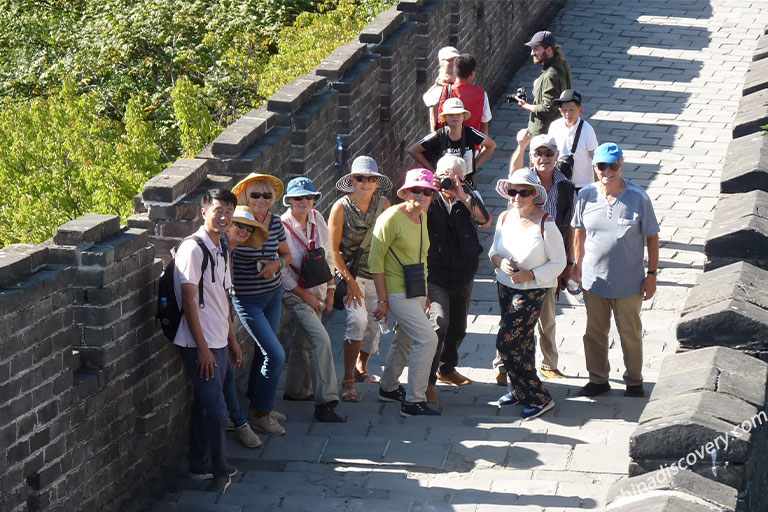
6 Days Classic Beijing Xian High-speed Train Tour (Most Valuable)
Beijing / Xian
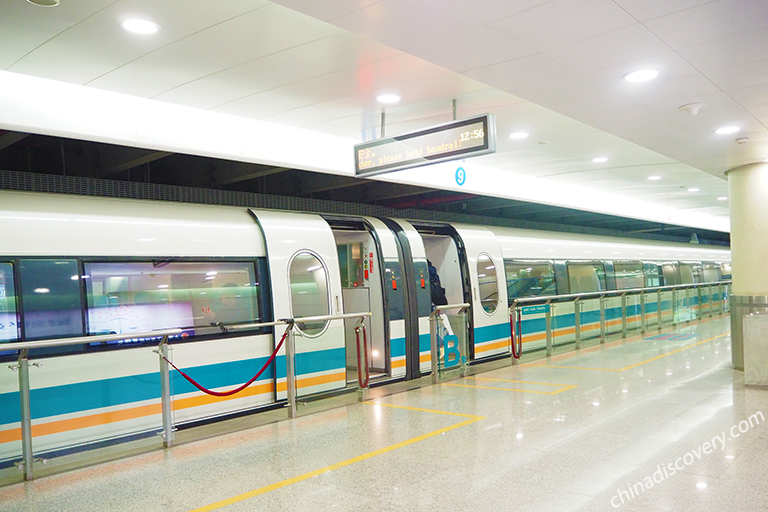
7 Days Shanghai Suzhou Beijing Contrast Tour by High Speed Train
Shanghai / Tongli / Suzhou / Beijing
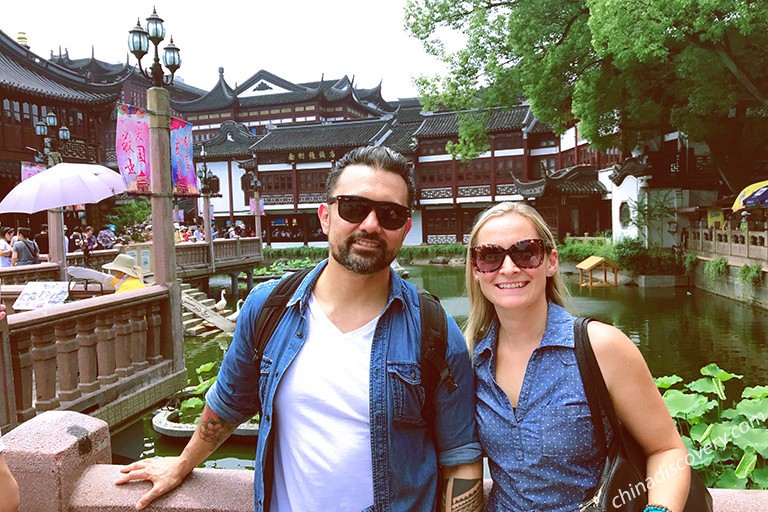
13 Days China Leisure Tour with Yangtze Cruise & Train Experience
Beijing / Xian / Chengdu / Chongqing / Yangtze Cruise / Yichang / Shanghai
Start planning your tailor-made holiday to China by contacting one of our specialists. Once inquired, you’ll get a response within 0.5~23.5 hours.

Have a question? Get answers from our travel experts or guests
- Your Question:
- Your Email:
- Affordable and valuable price
- 100% tailor-made packages
- Highly rated customers reviews
- Efficient customer support
China Tours
- Top 10 China Tours
- Classic China Tours
- China Tours from Beijing
- China Tours from Shanghai
- China Tours from Hong Kong
- China Tours from Chengdu
- Short China Trips
- Customize China Tour
- China Panda Tours
- Family Tour with Kids
- High-Speed Train Tour
- Silk Road Travel
- Yangtze River Cruise
- Hiking & Trekking Tours
- Photography Tours
- China Minority Travel
- Beijing Shanghai Tours
- Shanghai Yangtze Tours
- Chengdu Jiuzhaigou Tours
- Chengdu Lhasa Tours
- Suzhou Hangzhou Tours
- Guilin & Yangshuo
- Zhangjiajie
“Very good experience”
“WONDERFUL 25 DAYS IN CHINA - PRIVATE TOUR”
“Awesome China tour from northeast to southwest”
Any questions, please email us at: [email protected] or call us at: 86-19138970032 (Monday-Friday 9 a.m. to 6 p.m. GMT+8)
- Terms & Condition
- Privacy Policy
- Customer Support
Copyright © 2011-2024. All rights reserved.
Cookie policy
We use cookies to give you the best experience on our website. Continue using our website means you agree with our cookie policy. For more info, please read here .

How to Travel by Train in China: A Complete Guide
Have you ever dreamed of traveling by train in China, the world’s most populous and diverse country? If so, you are not alone. Millions of travelers from all over the world choose to explore China by train every year and for good reasons. Train travel in China is not only fast, convenient, and affordable, but also scenic, cultural, and historical. You can experience the world’s largest high-speed train system, the breathtaking scenery along the routes, and the diverse culture and history of China by taking a train. In this article, we will show you how to travel by train in China, including how to book your train tickets, how to arrive at the station, how to get on a train, and how to deal with your luggage. We will also share some tips and tricks to make your train travel in China more enjoyable and memorable.
Travel by Train in China
If traveling in the inner city, subways and buses are the ideal means of transportation, while for traveling between provinces, trains are the right choice. Despite being developed later than some other countries, China’s railway system now boasts the world’s leading speed, length, reasonable fare, and variety, catering to the needs of people with low to high incomes.
For example, if you’re traveling the same distance from Kunming to Guangzhou, you’ll find more than 20 train options and 60 train ticket options available on the same day. The cheapest ticket class for this route is about 26 USD (190 CNY), with a travel time of 27 hours. On the other hand, the highest ticket class is priced at 208 USD (1,515 CNY) and takes 7 hours and 50 minutes. If you choose to go by plane, the ticket price ranges from 167 to 333 USD (1,217 to 2,427 CNY).
Another noteworthy example is the Beijing – Shanghai leg, which covers a distance of 1,200 km. The high-speed train covers this distance in about 5 hours and costs around 83 USD (605 CNY) per person. In contrast, the Shanghai – Suzhou leg, which is 110 km, takes approximately 25 minutes and the ticket price is about 5.5 USD (40 CNY).
While traveling by plane may offer shorter flight times compared to train journeys, it is important to consider the additional time required for airport commutes (which are usually far from the city center), check-in procedures, security checks, and retrieving luggage.
How to Book Train in China
The official website of China Railway is now available in English. It also allows payment with popular international payment cards such as Visa, Master, and JCB. To access the website, you need to register an account and create a password. Registering is easy. You just simply enter your email and personal information exactly as it appears on your passport. No phone number is required.
Once you’ve registered an account, you can input your departure point, arrival point, and departure date. The platform will then display all available trains, ticket classes, and travel times. Next, you choose the desired train and make the payment using an international payment card. The platform then send you a confirmation email with your ticket details. There’s no need to print your ticket. You simply save the email on your phone and present it at the station. The email will include the passenger’s full name, reservation code, fare, train number, car number, seat number, departure point, destination, departure date and time, and check-in information.
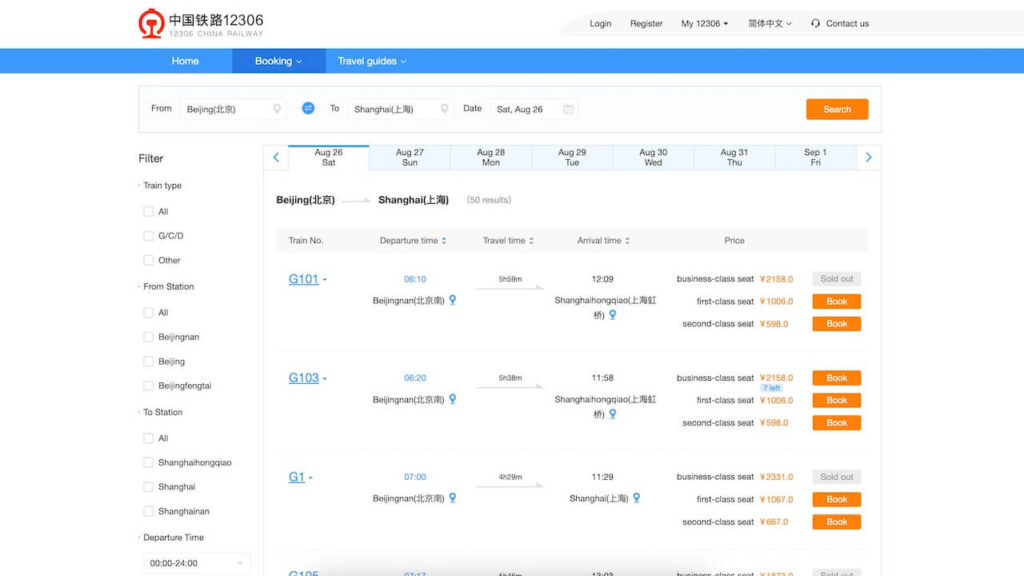
Things to Know When Buying Train Tickets in China
There are two important points to keep in mind when buying tickets. One is that a lot of trains run out of tickets right after they go on sale, so buy as soon as possible. Usually, these websites open to sell tickets 14 days before departure. Second, when registering an account and buying tickets, it is necessary to enter your real information and that of your companions exactly as it appears in your passport. This is because when you board the train, the staff will check your passport to see if it matches the ticket or not.
If you don’t want to buy on the website, you can also buy train tickets through a third-party app, like 12Go . This application supports different languages with supporting channels for you.
In case you can’t buy a ticket online, you can buy it at the station. Nevertheless, the selection will be much less and the date you want to go may not be available.
Arriving at the Station
Many train stations in China are as large as airports, with some big centers. Indeed, Shanghai Hongqiao railway station is even larger than airports. This is because they have metro stations, inner-city bus stations, long-distance bus stations, and even a civil airport. Additionally, some stations feature amenities such as food courts, supermarkets, and souvenir shops. Passengers can purchase food and drinks to enjoy onboard their journey.
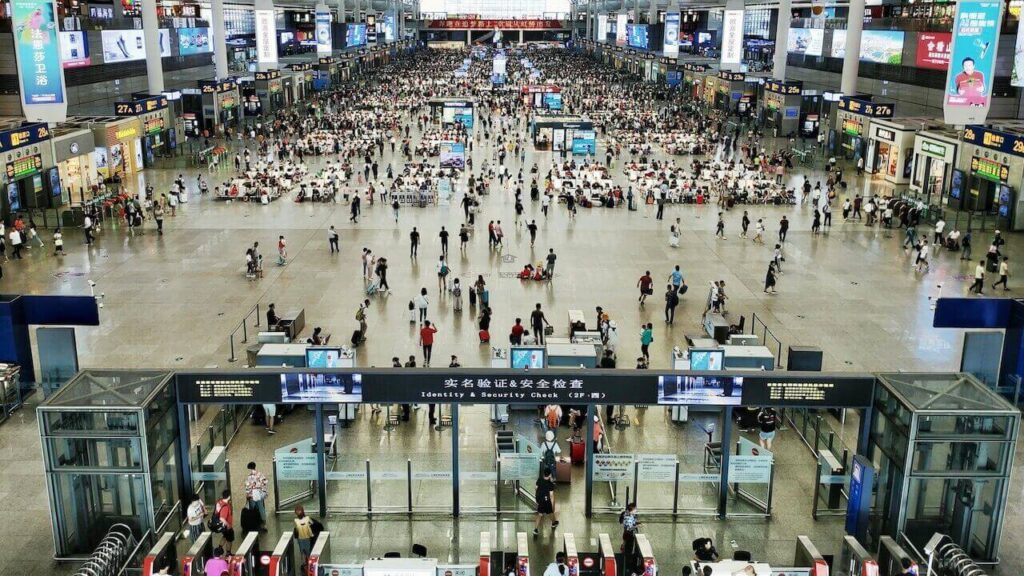
The terminal is large, so you will need a lot of time to move, especially when dragging luggage. Therefore, you should aim to be at the station at least 30 minutes before the train’s departure time. In those 30 minutes, you need to complete two procedures:
At the entrances of all stations, there are security checkpoints and baggage screenings. Railway regulations are not as strict as aviation. You can still bring food, liquids, and personal items, but you should avoid carrying potentially dangerous items such as cutlery, chemicals, and explosives. There is a list of prohibited items on the train, clearly stated on the railway website. However, if you are only carrying regular luggage, there is no need to worry. It only takes a few minutes to go through security. Then, find the correct check-in gate to board the train.
Scan documents at the boarding gate (check-in). You do not need to present any kind of ticket because your ticket is already saved in the system, corresponding to the personal document you used to buy the ticket. Chinese passengers just need to swipe their citizen IDs to board the train. For foreign visitors, there will be a separate gate with staff standing by to assist them. You should give your passport to that person. They will enter the passport number into the machine and then return it to you. Thus, when buying tickets for yourself and your companions, make sure to enter accurate information.
All stations have English signs. During the above two steps, you do not need to communicate with the station staff unless there is an issue with your luggage or ticket.
Getting on a Train in China
On most trains, no one will check your ticket. Passengers find the correct carriage and seat number and settle into their seats before the train departs. When compared to trains in other countries such as Europe , Japan , Korea , India , or Southeast Asian countries , trains in China are the most spacious, modern, and clean. Each seat is approximately 50 cm wide, providing ample room for comfort. The legroom is wide enough for individuals up to 1.90 meters tall to sit comfortably. The aisle between the two rows of seats is more than half a meter wide, allowing passengers to easily move about the train. It is also convenient for carrying large luggage. Most seats are equipped with power sockets, dining tables, and storage compartments. Additionally, every car is equipped with clean and comfortable toilets, free hot and cold water dispensers, and multiple electronic screens that display important information such as the departure and arrival stations, train speed, and outdoor temperature in both Chinese and English.
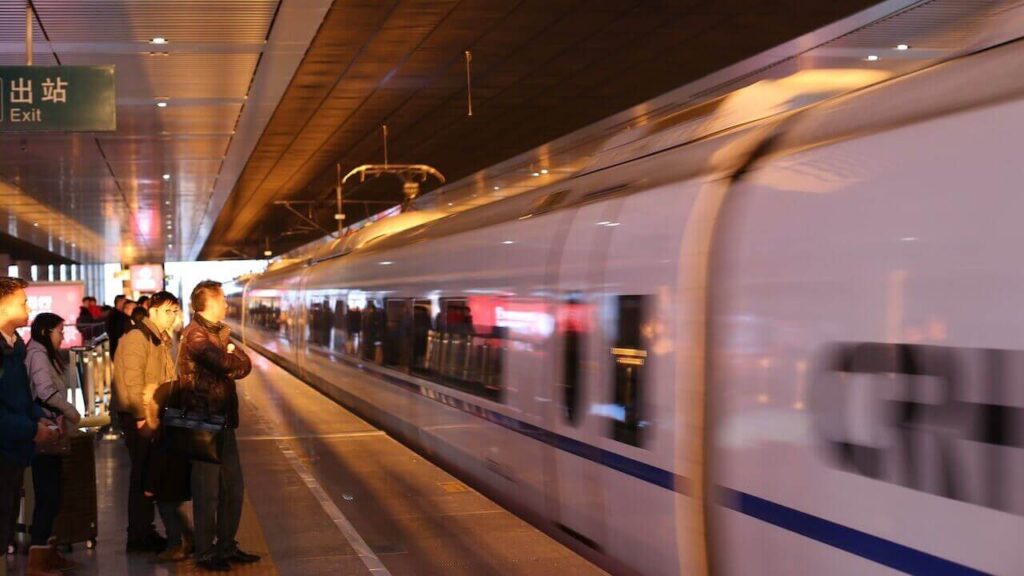
On the train, there are often staff pushing food carts to sell to passengers at reasonable prices. You can also pre-purchase a wide selection at the station. Please clean your table and seats after eating; there are trash cans and sinks available in every car.
The train ran very smoothly; a full glass of water was placed on the dining table and not a drop was spilled during the 5-hour journey. On the train, there is almost no smell, and no one plays loud music or talks loudly.
Handling the Luggage
The general regulation of China Railways for luggage is not to exceed 10 kg per child and 20 kg for an adult. The sum of the dimensions should not exceed 160 cm. Wheelchairs for people with disabilities are charged separately. At the station, there are almost no scales and tight gauges like at the airport. However, you should not bring too many things, leading to difficulty in moving and the risk of delay due to baggage problems.
For large suitcases, put them in the luggage compartment at the front of each car, and small bags in the tray above the seats. Trains in China are civilized and safe, but you should still carry your passport, wallet, and phone with you wherever you go. If you need assistance, you should ask the station and train staff. They are professional and friendly.
Final Thoughts on Train Travel in China
Train travel in China is a wonderful way to discover the beauty and diversity of this amazing country. By following our guide, you can plan and prepare for your train travel in China with ease and confidence. You can also enjoy your journey onboard with comfort and convenience. Whether you are looking for speed, scenery, or culture, you can find it all by traveling by train in China. So, what are you waiting for? Book your train tickets now and get ready for an unforgettable adventure!
Note: This post contains affiliate links from which I can earn commissions if you use services or buy products from the blog’s partners. If you love the blog, please use the services or buy the products. In that way, you give me support for the blog’s maintenance and development. I appreciate it a lot and thank you for that!
Essential Items
If your next destination requires a visa.
IVISA will help you with their speed, simple, and secured services with just a minimal chance of being rejected.
Find Your Flight and Transportation to The Destinations
You can read my travel tips to Find Cheap Flights . You can also use 12Go to book buses, trains, ferries, or any transportation to places.
Book An Accommodation
Driving yourself will be more enjoyable.
You can easily compare prices and find great deals on Discover Cars .
Protect Yourself and Your Trip
Travel Insurance is Important , especially after COVID-19, there are more possible health issues and pandemics. Please don't forget to have a shield for yourself and your trips!
IF YOU LIKE THE TIPS TO TRAVEL BY TRAIN IN CHINA, ‘PIN IT’ NOW

Khoi Nguyen
Khoi Nguyen builds The Broad Life with a desire to inspire people go exploring the world and live a more interesting, experience, and adventurous life. This blog shares the stories, pictures, and experiences at destinations where he has traveled to.
17 Comments
This is a great blog post, because I love traveling, and I love to do it affordably. I am from Europe, and we use the train all the time, even for international travel. I have always dreamed of visiting China one day. I would love to visit Beijing and Shanghai. Thanks for sharing these tips.
China is truly a great place to visit with so many attractions. And traveling around the country by train is one of the best choices.
bright loveland snow
This is one simplest guide to travel around china. so simple and well understanding. thanks
Thanks for your comment!
How wonderful that they have a bathroom. Our commute trains here do not unless you’re traveling for a long trip.
No doubt a very helpful guide to anyone traveling around China in a train. I can’t see this ever being me but still found it interesting to read.
Thanks for your comment! What are you favorite means of transportation when traveling?
China has one of the most extensive rail networks in the world. They also have huge stations like beijing, so it cna be overwhelming and pretty hard to take trains. thank you for your comprehensive guide.
China even has one of the fastest high-speed trains in the world .
This is an amazing resource for Traveling by Train in China. Your guide is perfect for visitors!
I hope this guide can help travelers in China.
Great information! I think visiting China would be a great adventure, and this information is quite helpful to know for exploring.
Are you ready to take an adventure in China now?
Your guide on traveling by train in China is incredibly comprehensive! From booking tickets to navigating stations, you’ve covered it all. The tips and insights you provide make train travel in China seem much less daunting. Thanks for sharing your expertise in such a reader-friendly way!
Thanks for your comment! Just hope that my article is helpful.
Ntensibe Edgar
Oh wow….thank you for this guidance on using the train service in china. it’s so helpful that they’ve got the directions in the english language now. I will definitely try it out when i am there.
China is a good place to visit so you can come anytime and experience the trains.
Leave a Reply Cancel reply
Your email address will not be published. Required fields are marked *
Notify me of new posts by email.
Post Comment
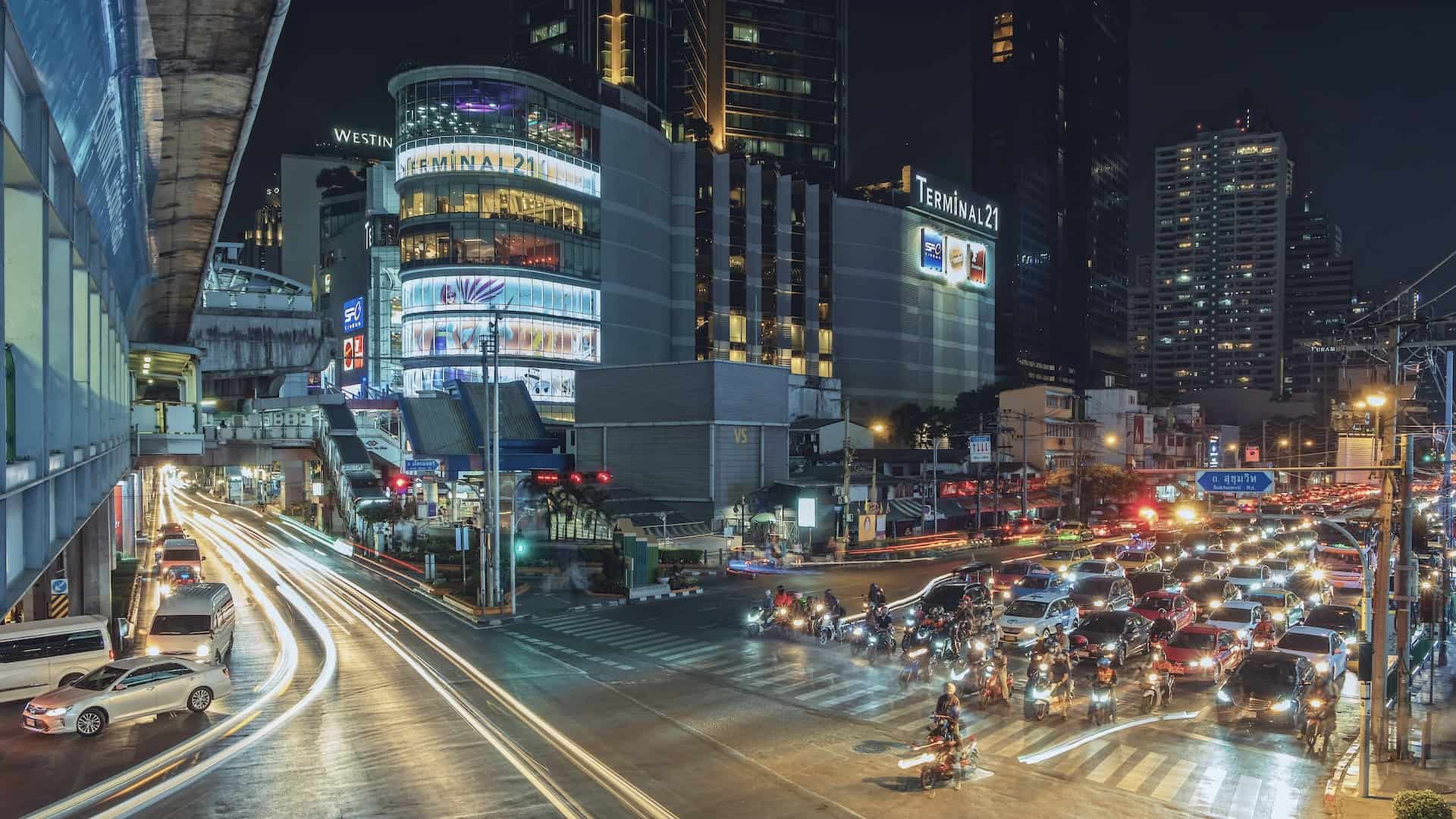
Bangkok Travel Guide: Everything You Need to Know About the City of Angels
Bangkok is the most visited city in the world, with over 20 million visitors every year. But what ma

48h in Quy Nhon City, What to Do?
A hidden gem of Middle Vietnam, Quy Nhon City brings to you the amazing taste of the sea, mountains,
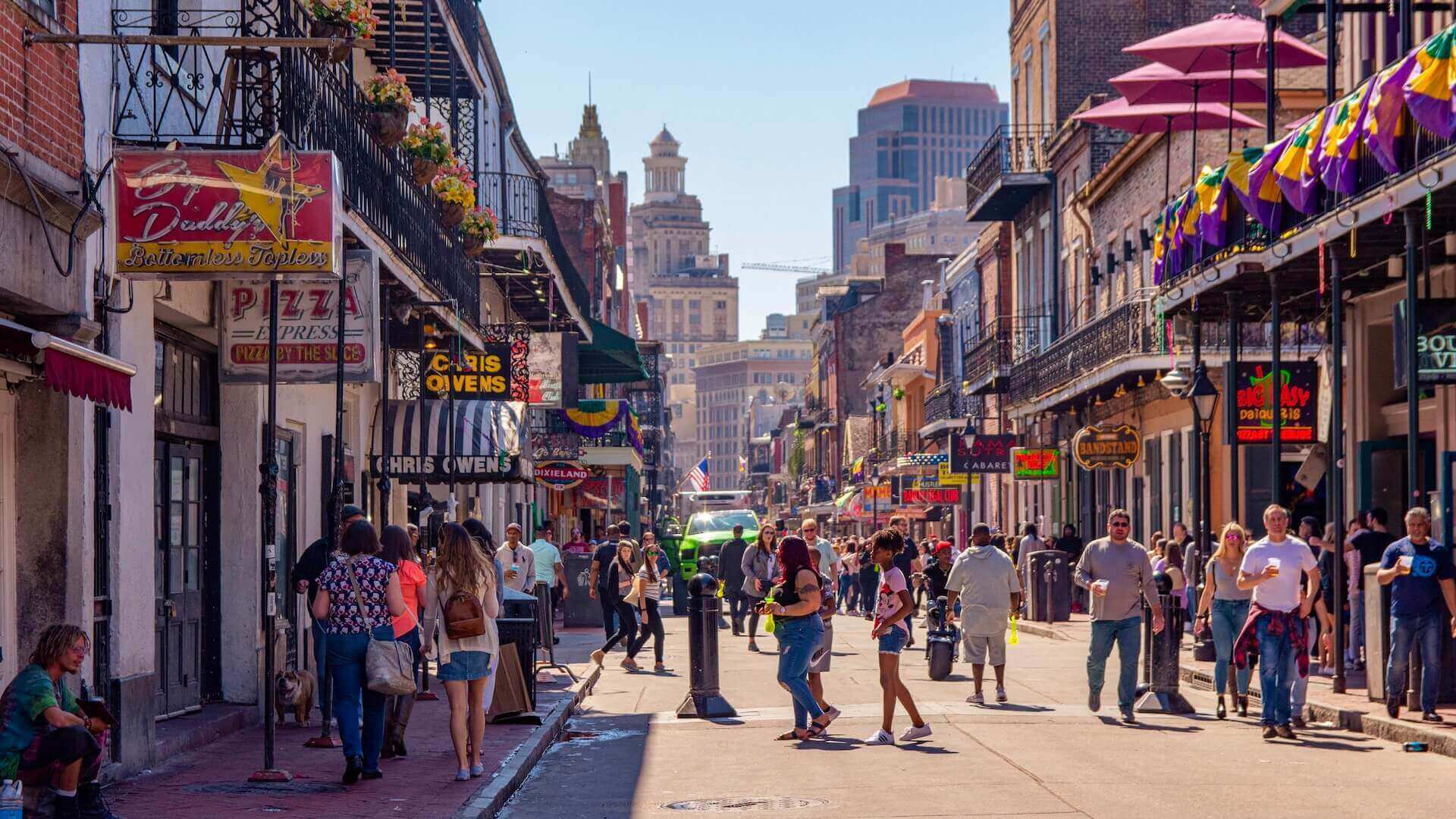
New Orleans Attractions: The Ultimate Guide to the Best Things to See and Do in the Big Easy
New Orleans is a city that offers a rich and diverse cultural experience for visitors. Whether you a

Travel Cambodia 7 Days Itinerary
I remember my trips when staying at home too long during the Coronavirus. Yes, those were the awesom

Sign up for Newsletter
Discover more from Travel Blog - Blog About Traveling | The Broad Life
Subscribe now to keep reading and get access to the full archive.
Type your email…
Continue reading

All Destinations , Asia , China , Overland Itineraries , Overland Travel , Plan Your Trip , train travel
A complete guide to train travel in china.

China is a fantastic place for more adventurous travellers.
There’s no specific tourist path through the country, no shuttles transporting people to each destination, and very few bars and restaurants catered especially for backpackers.
Because of all of this, China can seem a little daunting; and the question of how to get around is just one of the many challenges when planning a trip to China .
But, even though it looks daunting, train travel in China is fairly easy to get the hang of – plus it is a cheap and effective way to travel.
Granted, it takes a lot longer than flying, but the yuan saved makes it really worthwhile. Of course, train travel is always a lot more eco-friendly than short plane journeys which is another reason why I will always choose trains over planes when possible.
Personally, I’m a huge fan of the experience of train travel.
China offers some of the most stunning scenery I’ve ever seen and travelling by train allowed me to see this and make connections with other passengers on the train, be amazed at the train food provided, and experience a 42 sleeper train cabin.
Flights are the same anywhere in the world, but taking a Chinese train is a unique experience. And you know what? It’s possible, even if you’re solo travelling in China .

Taking a Chinese train by yourself, with little or no command of the language, is pretty daunting, and learning how to take it successfully is one of the best things to know before visiting China .
And the good news is, it’s possible to see most of the country by train! So whether you’re planning to travel in Yunnan or journey between Beijing and Shanghai, getting a grasp of Chinese trains is an excellent idea.
If you’re planning such a trip, read on for everything you need to know to reach your destination safely.
Buying Your Tickets for the Train in China
Buying tickets for a train in China doesn’t have to be hard.
I normally choose to buy them in advance – beds can sell out (you don’t want to do a 40 hour journey on a seat or with no seat, trust me) and it saves confusion at the station.
There are two great services for buying train tickets in China – 12go.asia and China travel guide. You can use this handy 12go.asia gadget below, or click here to go through to China travel guide’s website .
Collecting Tickets
If you’ve bought your tickets in advance, you’ll need to collect them at a Chinese train station.
Many major train stations offer English-speaking booths – so head to one of those if you can.
You can also buy tickets at the station.
Here are some of the key phrases you might need when collecting your Chinese train ticket, written by my Chinese stepmum so I know they’re legit!

(From top to bottom – “Do you speak English?” “I want to pick up my train tickets” “this is my booking number”)

(From top to bottom – “Fast Train” “Sleeper” “I want a ticket to __ “)
Boarding the Train

“ But it’s all completely in Chinese!” I hear you say.
No dramas, there are a couple of ways you can work out which train is yours and where to leave from.
Numbers in Chinese are the same, so take a look at what time your train leaves and try and match it to one of the numbers on the board.
Your train number should be a mix of numbers and letters in pinyin characters and that will also be displayed on the board.
So, although you won’t be able to read what is actually on the board, you’ll definitely be able to find the train number and time that match your ticket and from there work out the platform number… yippee!
That sorted, get to your gate at least 45 minutes before the train leaves , if not more.
Trains in China start boarding up to an hour before departing and have been known to finish boarding at completely random times.
You probably could still get on the train up to 10 minutes before departure, but nobody wants a panicked dash through a foreign station where they can’t communicate themselves to people around, do they?
When its time to board, join the crowd (there is no queue, just a hoard of people pushing to get through the gate) and if you want to get on the train quickly, remain defensive to people pushing in front.
But your seat will already be allocated, so if you’re not too bothered about where in the crowd you board the train, relax (as much as possible when taking the trains in China!) and follow the crowd until you get to the front.
Then you just need to give the ticket inspector your biggest grin and your ticket (the second item is more important than the first) and march confidently down to the platform.
Rest assured that even if you did read the board wrong (which you shouldn’t have with my foolproof technique), you’re in no danger of actually getting on the wrong train – the inspector will stop you here.

When the train arrives, you’ll want to find your carriage.
Now here’s another factor to why trains in China are as confusing as hell; all of the carriages are often mixed up . Carriage 4 might be next to carriage 10 which might come before carriage 7. No idea why.
There should be another inspector at the bottom of the stairs who, if you show your ticket to, will point you in the direction of your platform.
When the train actually arrives, if you don’t see your carriage straight away just show someone official your ticket again and they’ll be happy to point you in the right direction.
Weirdly, everyone else at the station always seems to know exactly what’s going on!
Trains in China normally stand at each station for at least 10 minutes, so you should have enough time to work out where you’re meant to be sitting and board your carriage. Just don’t dally around!
When you board the carriage, be sure to do my favourite trick when travelling on Chinese trains . Find the carriage assistant, and with a beaming smile and a ‘please help me’ look in your eyes hand them your ticket and make a huge fuss of which station you’re disembarking at.
They should get the message – you have no idea how you’re going to work out where you’ll get off the train and you need their help .
Every assistant I’ve met has been more than happy to help out.

When you get to your seat, say NiHao to your neighbours.
This is done out of politeness in China – and be prepared for them to be fascinated with you and if they know English, to want to have a jolly old chinwag.
They’ll likely be super friendly and accommodating.
For extra security, show them your ticket and point at the station you’ll be getting off at.
If you’re lucky, they might be disembarking at the same station – meaning that your train quest is easily resolved by just following them off.
If they are getting off the train after you, they’ll definitely want to help you out by letting you know when you should be getting off.
Once you’ve met your neighbours, settle in to your seat/ bed, relax and enjoy the ride!
Train Packing List
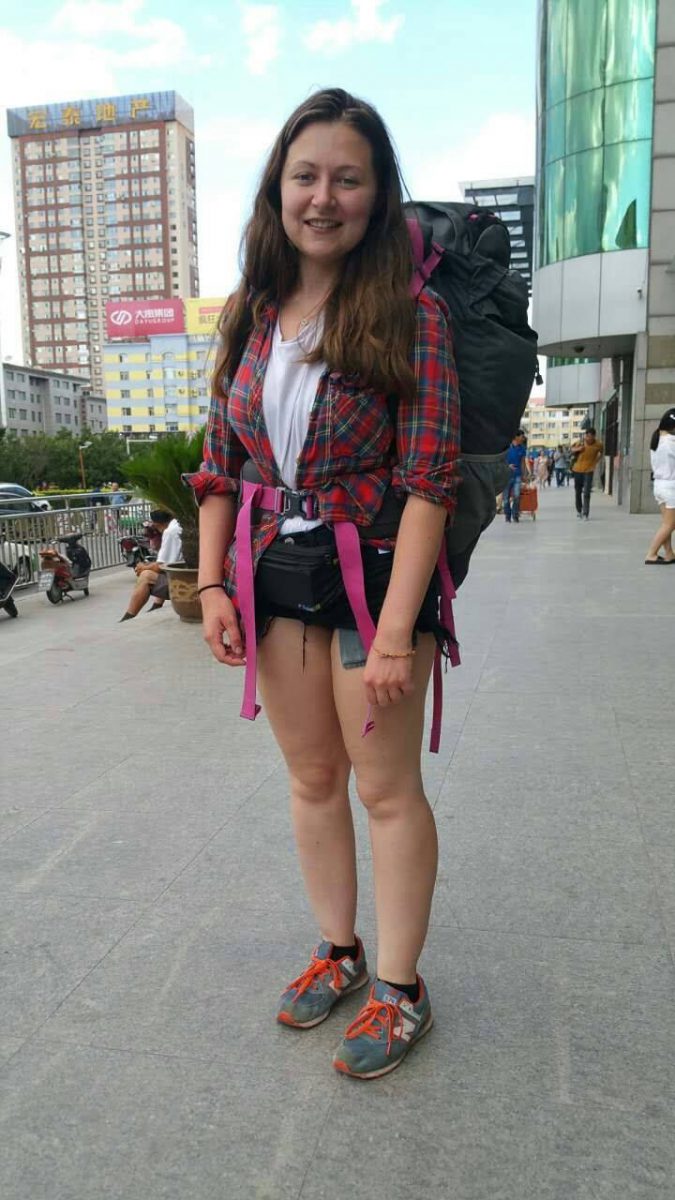
You’ll need all of the stuff that you’d generally take on a long haul flight or long coach journey, like the Megabus from London to Amsterdam I took last year.
Food on Chinese trains isn’t too expensive but can also be bought for much cheaper in supermarkets.
You’ll also want some products to keep you clean and fresh for the amount of time you’ll be on a train.
Things I make sure to have when I board a train in China include:
- My journal and idea notebook
- A great book to read – I travel with my kindle
- My laptop (blog life)
- Headphones and my ipod
- At least 2 packets of noodles a day – there’s boiling water on tap available
- Teabags and a cup
- Plenty of fresh fruit
- A choccie treat or two…
- Toilet roll – trains in China will often run out
- Hand sanitizer – the toilets can get a little gross to say the least!
- My general washbag with my toothbrush, toothpaste etc in
- My water to go bottle , so I can refill from taps on the train
Have you taken a train in China and have any more ideas? Let me know over on Facebook or in the comments section below!
On The Train
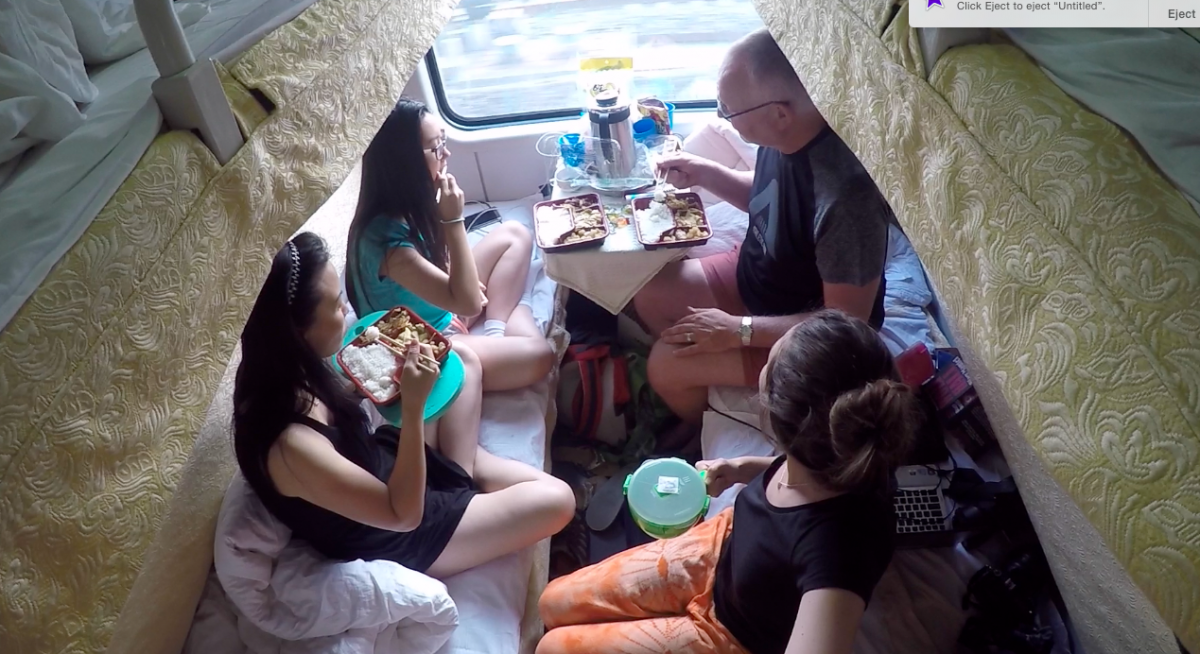
After your stop, the ticket inspector will come around and take your ticket and replace it with a boarding card.
They will keep your ticket for the duration of the journey.
Train journeys in China are long . But for a lot of people, they’re everyday life. Servers come round with hot food every hour or so, where you have the chance to buy a meal that’s not noodles!
Lights out is at about 10pm and the carriages normally come back to life at about 6/7am. It’s tough if you want to sleep in – music starts playing as soon as people get up, but you can turn the stereo nearest you down if you don’t really want to listen to Chinese opera at half past six in the morning.
If your assigned seat is the bottom bunk, you may find that it turns into a sofa for other people in the day. This is just train etiquette and you can’t do much about it.
Finding Your Stop and Disembarking the Train
If you’re in a sleeper, just before your train stop a ticket inspector should come back around with your ticket. This should indicate that the next stop is yours.
However, I learned that this didn’t always mean that the very next stop was mine so it always helps to keep asking people around to make sure you disembark at the right stop.
If you’re in a seat, or are a bit unsure as to whether your stop is next or not, after making such a scene when boarding the train you’ll probably have hoards of people – passengers and workers alike – to let you know whether your stop is correct.
If you don’t, ask around at any stop you feel might be yours. Unless it’s one of the lesser explored cities in China , other people should be getting off at it too.
I really can’t emphasise how friendly and helpful Chinese people are and many will be delighted to help you out.
If you want to be a little more independent, you can prepare by having a copy of your China itinerary .
This will brief you how many stops there are between your departure station and your destination and if you see a sign at any of the stopover stations, you’ll be able to match each station on the itinerary to the one that you’re at.
Signs at Chinese stations are sometimes difficult to see and comprehend, but having all of the names written down will give you the best chance of navigating your journey.
You can also, of course, keep your eye on GPS to see where exactly you are.
Guide to taking the train in China
There you have it, a (somewhat) foolproof way to train travel through China!
The trains in China are definitely an intimidating experience, but you’ll soon realise that while they’re complicated as heck, the sheer amount of people on them willing to help means that you’ll never be really lost.
As always, in China and other countries, hand gestures and a smile will take you a long long way.
Have you taken the trains through China, or any other country? Do you have any tips to share? Let me know in the comments below!
You know you want to pin me!
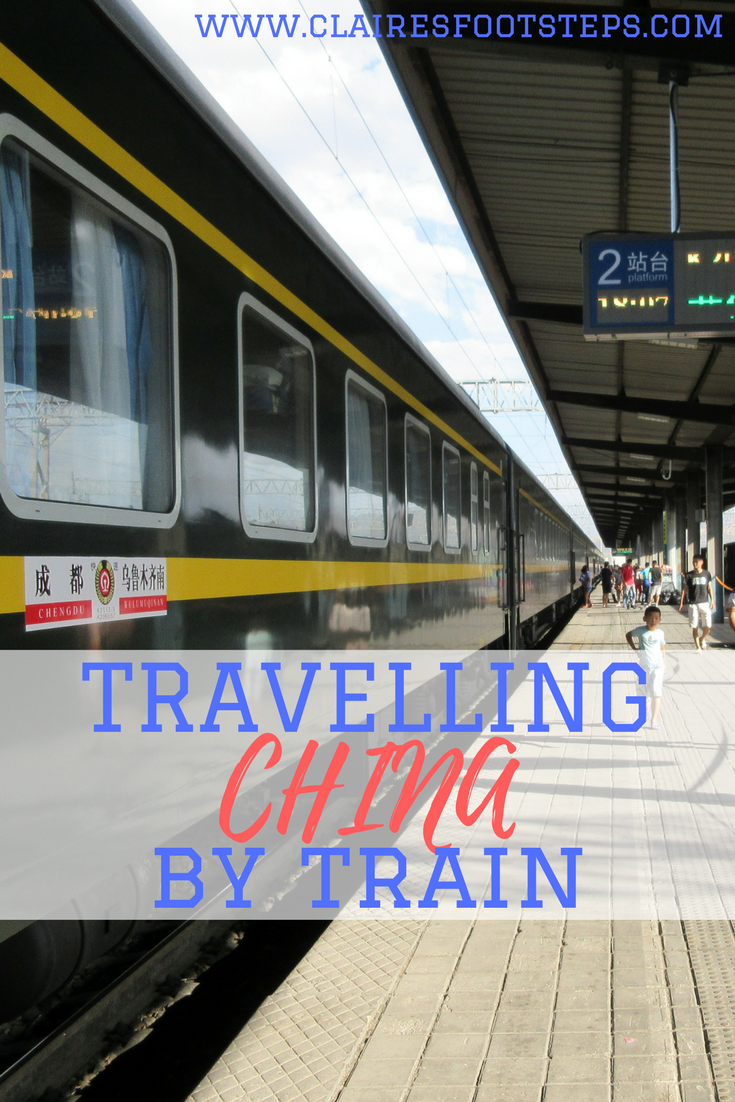
Disclaimer: some of these links are affiliate links . If you make a purchase through these, I receive a small commission at no extra charge to you. I only recommend products I use and endorse. This is just one of the ways I keep this site running and free to use!
8 thoughts on “ A Complete Guide to Train Travel in China ”
Wow, what a thorough guide! Love that you’ve even included the translations of useful phrases. I’ve no plans to travel in China at the moment, but would love to get there one day.
It’s a great place! Hope you make it 🙂
Wow, this is a very detailed and useful guide! I’ve been to China twice but have never taken the train there. Your article has made me interested in trying it out!
It’s a great way to see the country! I hope you get to try it some day!
I’ve been to China and now I currently live in Singapore. Commuting in is quite the same with China and Singapore. They have certain similarities though what Singapore has offered me so far are HDBs for rent. I tried looking for some places in China that I can comfortably stay so that I can attend to such events. Trying to live the Expat way, but not really lol. Nevertheless, thank you so much for
It is great when someone else goes on about how great train travel in China can be. A quick note for anyone over the age of 55 (or younger if the description fits) and not quite as agile as young people, or most Chinese passengers – try to avoid booking the upper berth in hard sleepers! However, do travel by train at least once if in China. Hardseat during a Golden Week with three children was the most challenging – I was in my 40s; that top berth at 59 the most difficult physically. Heading back in Sep 2017.
Hi I apologise this is over a year later but I am currently studying in Beijing for a month and then going to travel on my own for two weeks and taking quite a few trains! I just wondered what happens about luggage, is there a specific space? ( I have a normal travelers backpack but know it can sometimes be a pain to fit in places). And did you have much of a problem with the attention being a solo female? I’ve had a lot of attention in beijing and not always the most pleasant, and not sure how to deal with it especially for when I’ve got a 20hr journey! Thank you for the post, its calmed my nerves that I won’t be blindly trying to find my train or stop!
Hey! You’ll be able to fit your backpack under the bunk or on the big storage shelf above the window. Keep your valuables on you although it is very safe. Yes you do get attention, but it was never too OTT for me. If people can speak English they’ll probably want a chat but I found that nice! There might be a bit of staring when you get on but not as much as around other tourist attractions by a long way. People will also be really helpful if you need any help. You’ll be fine and remember it’s a great adventure! 🙂
Comments are closed.
- New Zealand
- The Philippines
- The Netherlands
- United Kingdom
- Inspiration
- Overland Itineraries
- Packing Lists
- Travel Tips
- Working Abroad
- Accomodation Guides
- Overland Travel
- Preserving Cultures
- Protecting Animals
- Living Abroad
- Car Rentals
- Airport Transfers
- Attractions & Tours
- Bundle & Save
- Destinations
- Trip.com Rewards
Plan Your Travel with China Railway Lines: China Train Map, China Bullet Train Map

April 18, 2024
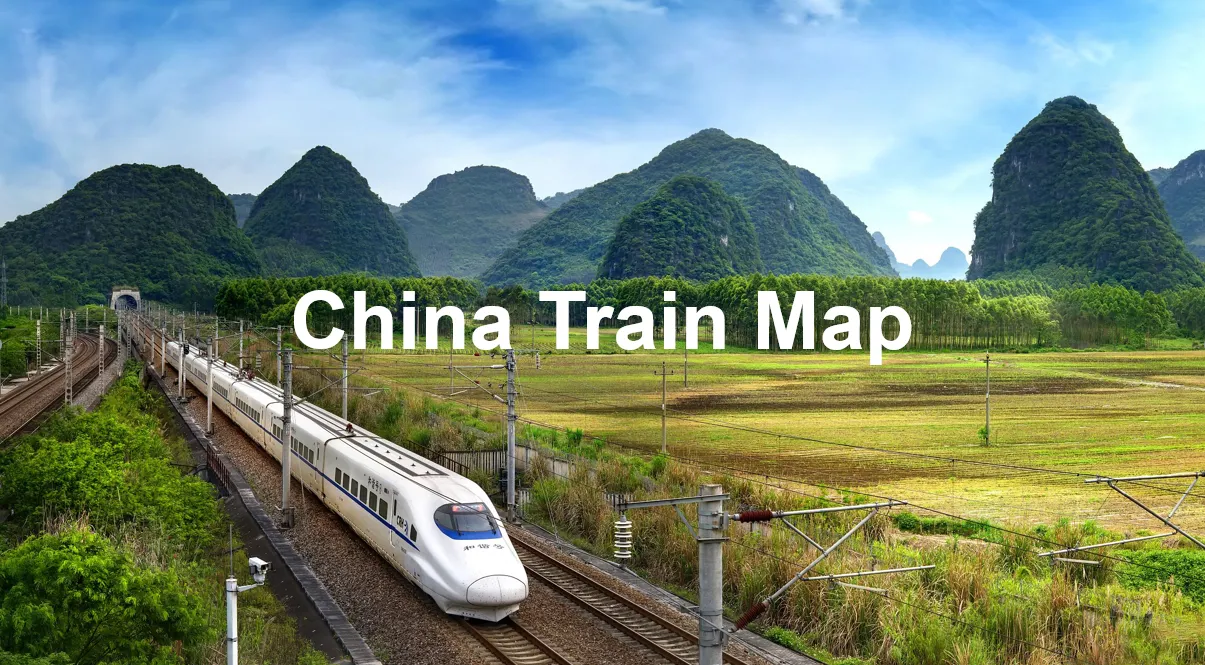
About China Train Map
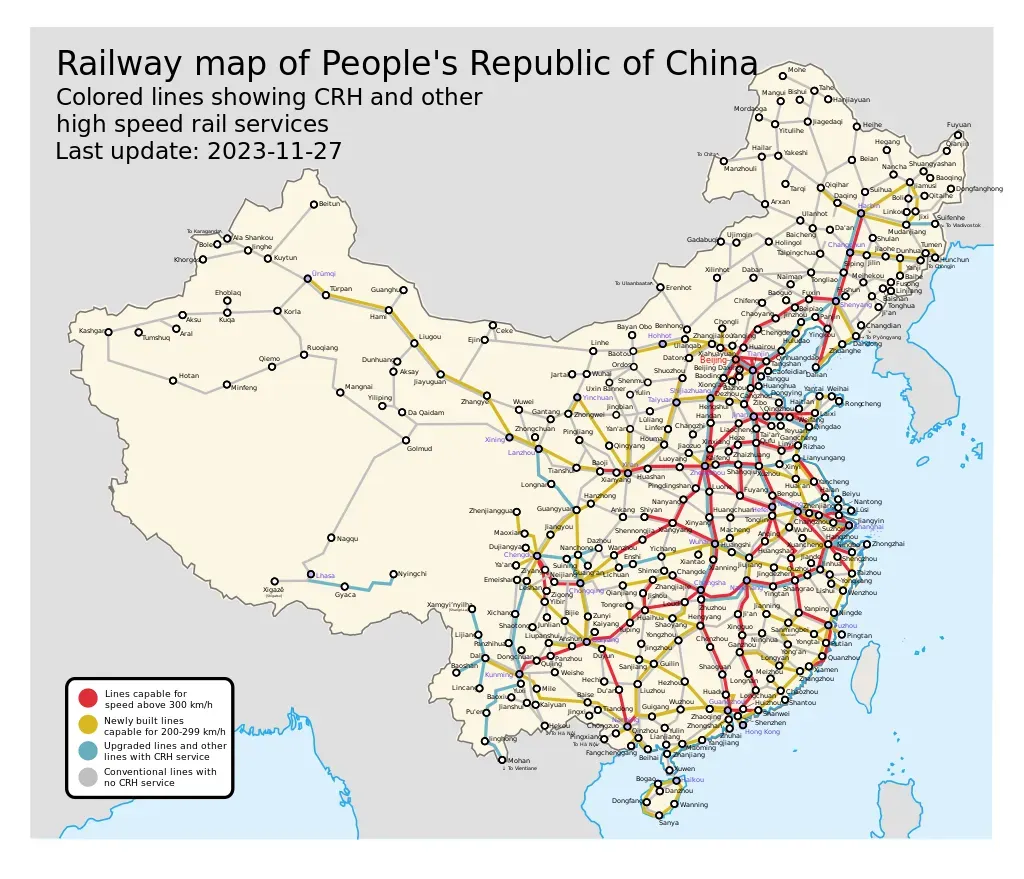
Source: Wikipedia
China railway network is extremely extensive and reaches all parts of the country, including remote and mountainous regions. As of 2020, the total operational length of China's railway network is approximately 146,300 kilometers , making it the second-longest railway network in the world, surpassed only by the United States.
China has also developed one of the world's most extensive high-speed rail (HSR) networks. As of 2020, the total length of China's high-speed railway lines is about 37,900 kilometers , accounting for about two-thirds of the world's total high-speed rail tracks. The high-speed rail system has significantly reduced travel times between major cities in China, with trains reaching speeds of up to 350 kilometers per hour.
Moreover, China aims to increase the total length of the high-speed railway to 70,000 kilometers by 2035, covering more than 90% of the population.
Visitors can check the above China train map for more accurate information.
Top China High Speed Train Routes
Popular china railway routes: china train map.
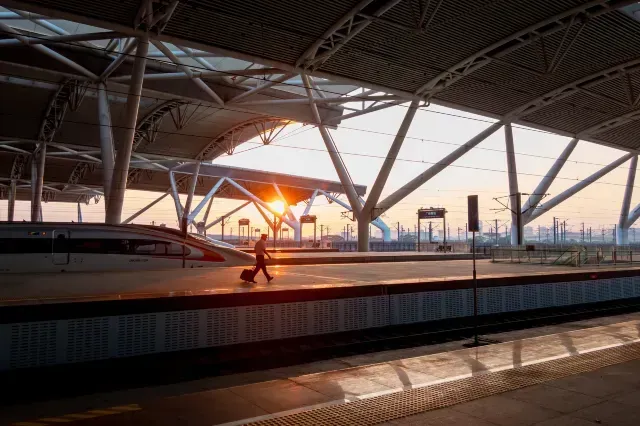
China boasts one of the most extensive and advanced railway networks in the world, with high-speed trains (known as Gāotiě) connecting major cities across the vast country. Here are some of the most popular China railway routes, destinations, and related China train maps:
1. Beijing-Shanghai High-Speed Railway(京沪高速铁路)
Connecting the capital city of Beijing with Shanghai, China's largest city, this high-speed rail line is one of the most frequented routes in the country. The journey covers a distance of about 1,433 kilometers and can be completed in as little as 4.5 hours, reaching speeds of up to 350 km/h. Along the way, passengers can stop at major cities such as Tianjin, Jinan, and Nanjing.
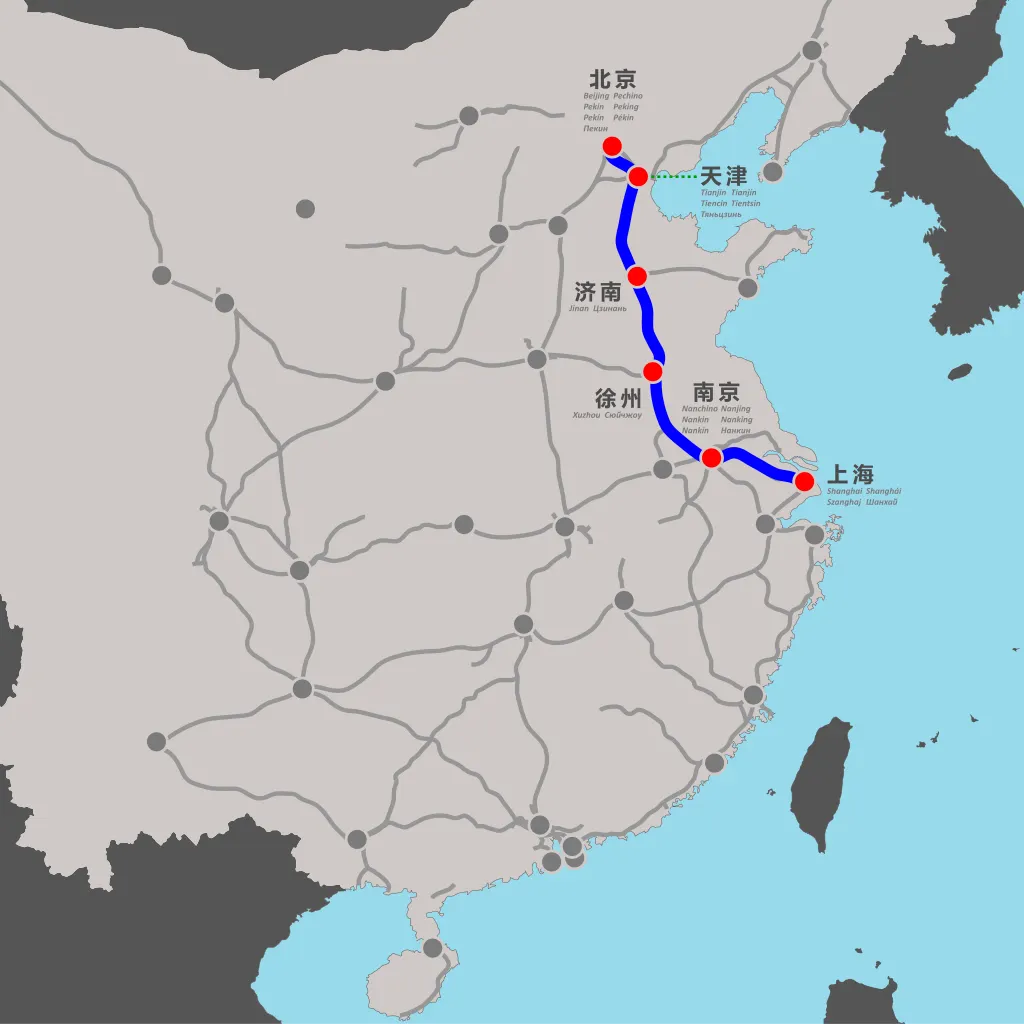
Source: from Wikipedia
2. Beijing-Guangzhou High-Speed Railway(京广高速铁路)
Spanning over 2,230 kilometers, this route links the northern capital of Beijing with the southern city of Guangzhou. It is one of the longest high-speed rail lines in the world and passes through several important cities, including Shijiazhuang, Wuhan, and Changsha. The journey can take around 8 hours, which is a significant reduction from the 20+ hours it would take by conventional train.
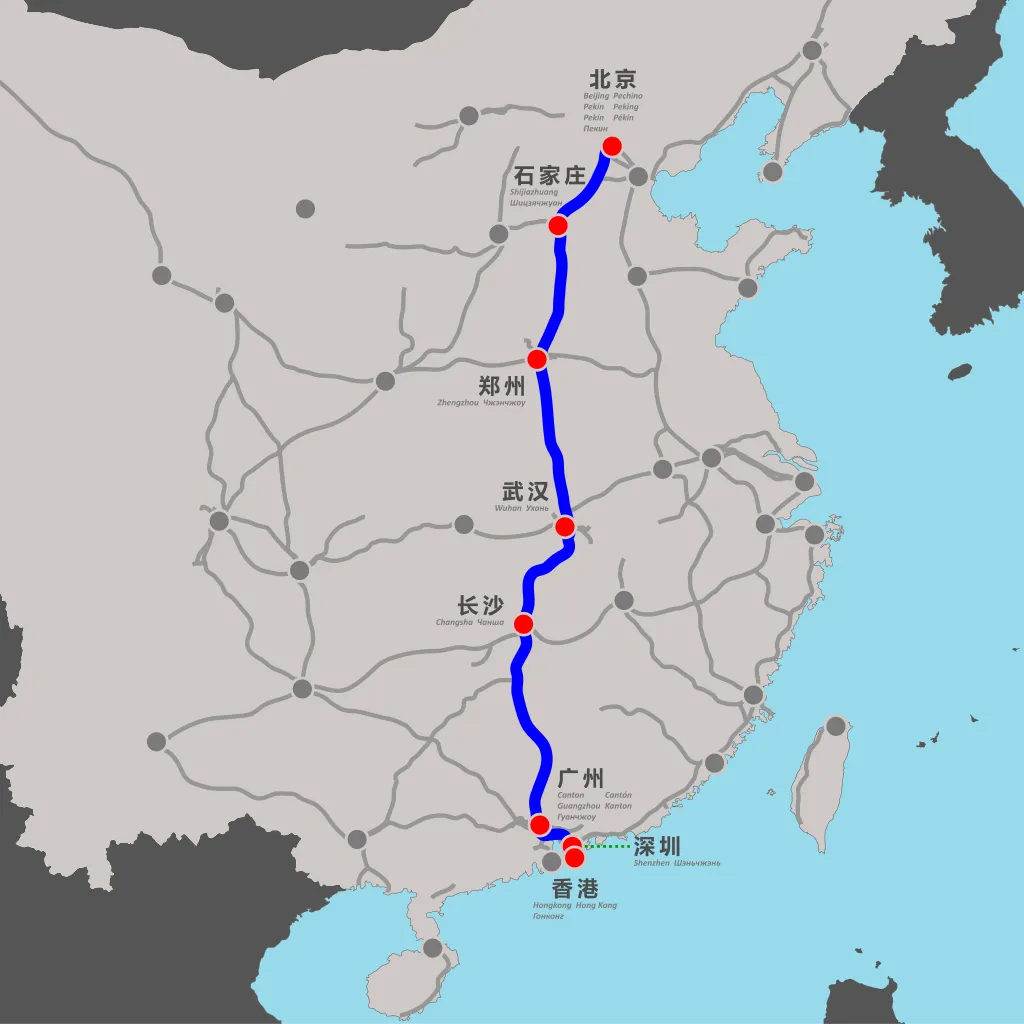
3. Shanghai-Kunming High-Speed Railway(沪昆高速铁路)
This route connects Shanghai on the east coast with Kunming in the southwest, traversing a distance of over 2,258 kilometers. The line passes through several provinces and offers access to scenic destinations such as Hangzhou, Nanchang, Changsha, Guiyang, and the beautiful landscapes of Yunnan province. The entire trip takes approximately 11 hours.
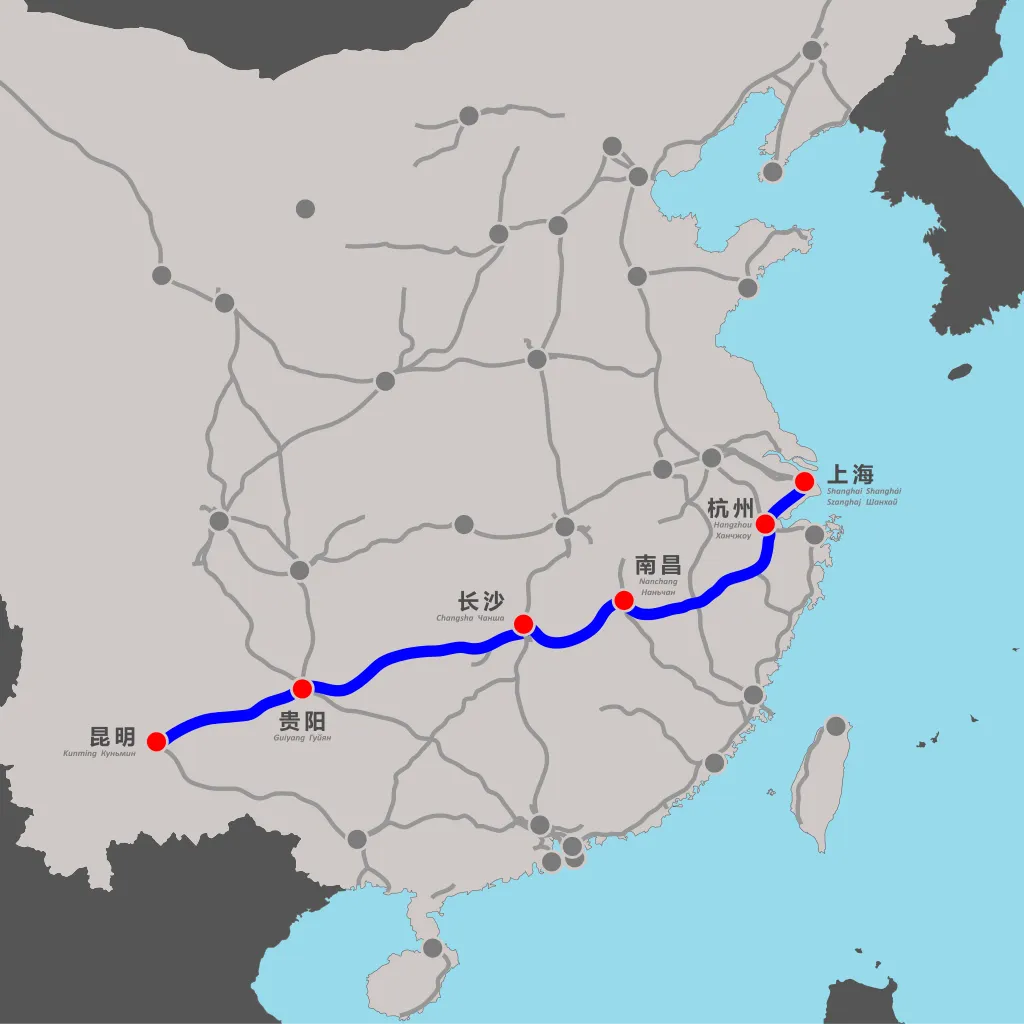
4. Beijing-Harbin High-Speed Railway(京哈高速铁路)
Linking Beijing with Harbin, the capital of Heilongjiang province in northeastern China, this high-speed rail line extends for about 1,700 kilometers. Known for its ice festivals, Harbin is a popular winter destination. The train passes through cities like Chengde, famous for its summer resort and imperial gardens, and Shenyang, an important industrial center.
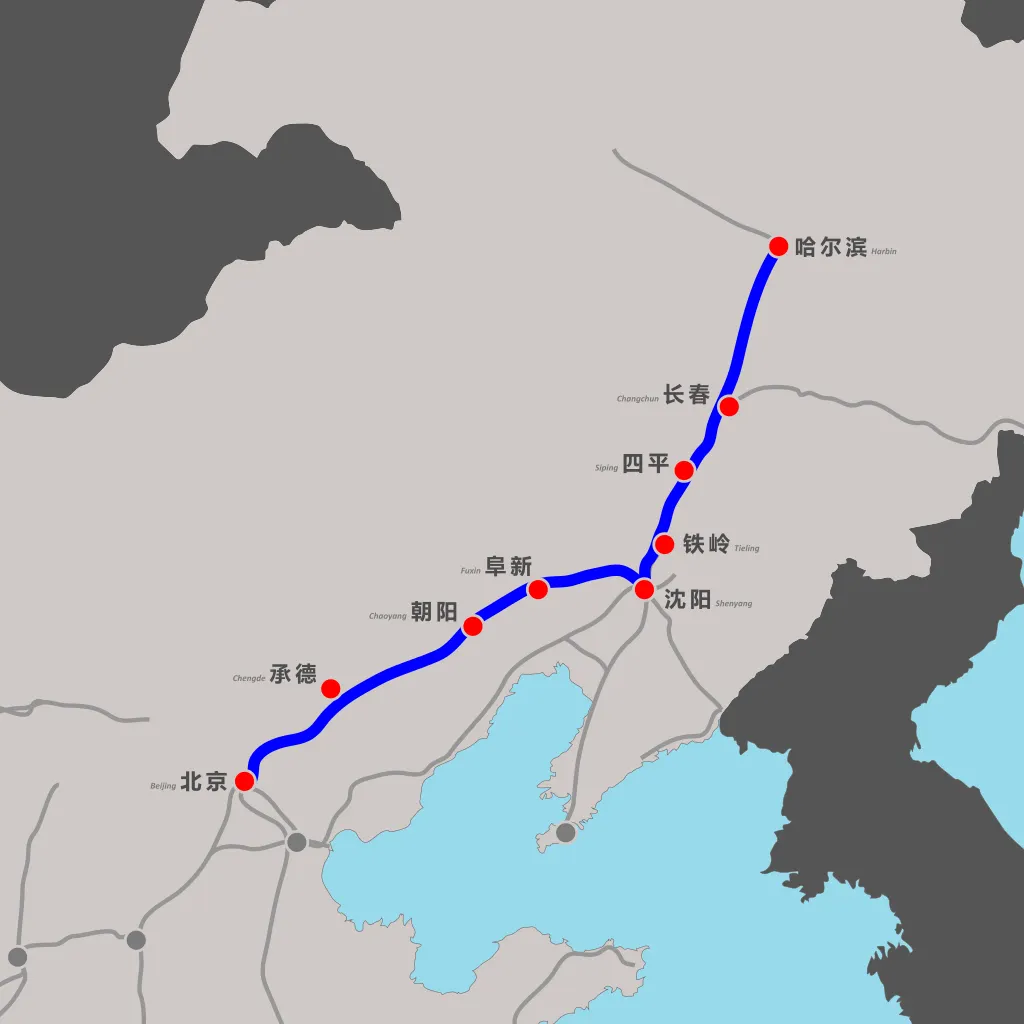
5. Guangzhou-Shenzhen-Hong Kong Express Rail Link(广深港高速铁路)
This relatively short but very important route connects the major cities of Guangzhou and Shenzhen with Hong Kong, facilitating easy cross-border travel. The entire journey from Guangzhou to Hong Kong can be completed in under an hour. This line provides a crucial link for business and tourism between mainland China and Hong Kong.
6. Chengdu-Chongqing High-Speed Railway(成渝高速铁路)
This route serves the economic corridor between Chengdu, the capital of Sichuan province, and Chongqing, a major city in Southwest China. The journey covers around 307 kilometers and can be completed in just over an hour, making it an excellent option for business travelers and tourists exploring the region's spicy cuisine and stunning landscapes.
7. Xi'an-Chengdu High-Speed Railway(西成高速铁路)
This line connects Xi'an, home to the famous Terracotta Army, with Chengdu, known for its panda sanctuaries and Sichuan cuisine. The journey covers about 510 kilometers and takes approximately 3 to 4 hours, passing through the Qinling Mountains, which offer a picturesque backdrop for travelers.
8. Hangzhou-Huangshan High-Speed Railway(杭黄高速铁路)
For those interested in natural beauty and ancient villages, the Hangzhou-Huangshan route is a must. It connects the city of Hangzhou, renowned for its historic West Lake, with Huangshan, where the Yellow Mountains (Huangshan) are located. The trip takes about 3 hours and provides access to some of China's most breathtaking landscapes and UNESCO World Heritage Sites.

China Train Lines

Conventional China Train Lines
China high speed train lines.
- Beijing–Shanghai High-Speed Railway (Jinghu High-Speed Railway)
- Beijing–Guangzhou High-Speed Railway (Jingguang High-Speed Railway)
- Shanghai–Kunming High-Speed Railway (Hukun High-Speed Railway)
- Hangzhou–Fuzhou–Shenzhen High-Speed Railway
- Harbin–Dalian High-Speed Railway
- Beijing–Harbin High-Speed Railway (Jingha High-Speed Railway)
- Beijing–Hong Kong (Taipei) High-Speed Railway
- Hefei–Fuzhou High-Speed Railway
- Xiamen–Shenzhen High-Speed Railway
- Guiyang–Guangzhou High-Speed Railway
- Zhengzhou–Xi'an High-Speed Railway
- Xi'an–Chengdu High-Speed Railway
- Nanjing–Hangzhou High-Speed Railway
- Shanghai–Nanjing High-Speed Railway
- Tianjin–Qinhuangdao High-Speed Railway
- Shijiazhuang–Jinan High-Speed Railway
- Changsha–Kunming High-Speed Railway
- Lanzhou–Xinjiang High-Speed Railway
International China Railway Lines
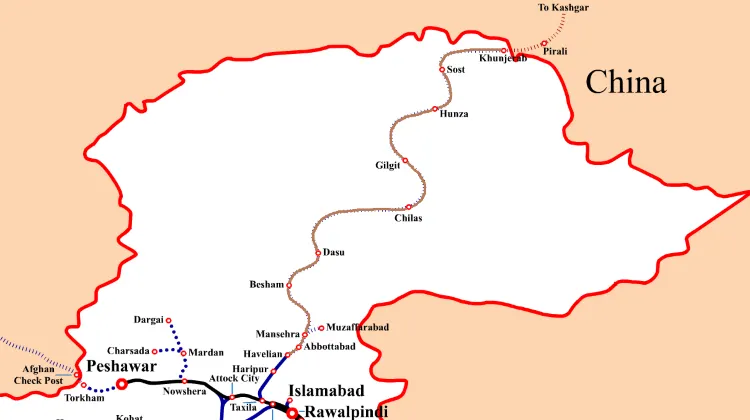
Source: from Wikipedia/China–Pakistan railway map
- China–Nepal railway
- China–Pakistan railway
- China–Laos railway
- China–North Korea railway
- Yiwu–London railway line
- Chongqing–Xinjiang–Europe Railway
- Yiwu–Madrid railway line
- Trans–Mongolian Railway
Plan your China Railway Travel with Trip.com Now!
Faqs about china train map, can i purchase china train tickets online, how can i use the china train map to plan my trip, does the china train map include high-speed rail lines, are all train stations shown on the china train map.
China Train Map Guide
- 1. About China Train Map
- 2. Top China High Speed Train Routes
- 3. Popular China Railway Routes: China Train Map
- 4. China Train Lines
- 5. Plan your China Railway Travel with Trip.com Now!
- Customer Support
- Service Guarantee
- More Service Info
- Website Feedback
- About Trip.com
- Terms & Conditions
- Privacy Statement
- About Trip.com Group
Other Services
- Investor Relations
- Affiliate Program
- List My Property
- Become a Supplier
China successfully tests maglev trains in vacuum tube, eyeing future speeds of 4,000 kph
China's new high-speed train doesn't roll along railways, it flies through tubes.
There are hopes it will one day connect cities and villages across the country, running at speeds of up to 4,000 kilometres per hour.
The magnetic-levitation (or maglev) train can clock speeds of 623 kph in tests — almost 200 kph quicker than the fastest train in service.
It is yet to be rolled out, but in February it went even faster, during a test of technology crucial to the train's high speed.
For the first time it travelled stably through the 2-kilometre low-vacuum tube, according to China's state run Aerospace Science and Industry Corporation (CASIC).
CASIC is yet to reveal the speed it reached, but said it was faster than its previous record of 623 kph.
How does the train go so fast?
The train is moved and suspended above the ground using magnetic-levitation technology — basically using the push and pull forces of magnets to guide, speed or slow the train.
This means the maglev train is much lighter, as it doesn't need wheels and brakes and other heavy bits of engineered steel to keep it safely on a railway.
To help keep friction down, China's latest superconducting maglev train is suspended, using three types of magnets, in a low-vacuum pipeline to "fly".
This generation is designed to reach up to 1,000 kph — faster than most people will ever travel on an airplane.
Unless you're Taylor Swift, whose private jet can still outpace the maglev train … just.
What are the main challenges?
UK high-speed rail expert Professor Andrew McNaughton told the ABC there were several difficulties in building large maglev networks.
Firstly, all new infrastructure, like the low-vacuum tunnel in China, has to be built and no older trains or railways are compatible.
Secondly, the energy requirement is "very substantial", Professor McNaughton said.
"The third is that the volume of people between just two destinations is insufficient to justify the cost — unless it is two mega cities," he explained.
"Various studies have suggested that the construction and operational cost of maglev is probably four to five times that of a conventional high-speed railway."
Because of the velocities involved, noise is a big problem and means additional measures, like expensive tunnels and sound barriers, would need to be installed around communities.
"Lastly, whilst a maglev can operate around 500 kph compared with a conventional high-speed train at 350kph, the time saved — unless over a very long distance — is not huge and certainly not enough to justify the cost," Professor McNaughton said.
How will a train this fast change things?
Commuters can come into cities from further away, and the increased speed of logistics will be a boon for most businesses.
Because the train is capable of going up to 1,000 kph, there are other positives too.
When that kind of speed can be reached, trains can basically compete with planes.
A train capable of the high-speeds China is aiming for would likely have a big impact for a large country, said associate professor Jonathan Couldrick from the ANU College of Engineering, Computing and Cybernetics.
"Imagine commuting 400 kilometres in around half an hour — that would be a game changer for the population centres," he told the ABC.
"And so you can actually have growth areas away from the capital cities, and people commute in in the morning."
Mr Couldrick said the fast trains could also be better for the environment.
He has estimated that completely replacing regional passenger aircraft with ultra-high-speed trains in some countries where people have to travel vast distances could reduce carbon emissions by 3 or 4 per cent.
Designers want to push the limits of the train and Mao Kai, the technical chief of the project, told Chinese media it could ultimately reach a blistering 4,000 kph.
That's even faster than the record 3,529.6 kph reached in 1976 by the almighty SR-71 Blackbird reconnaissance aircraft — the fastest manned aircraft in history.
How does it compare to other high-speed trains?
In places like Japan and France, high-speed trains have been around for decades.
Since 2010, about 10 countries have developed high-speed trains — ones that can travel more than 250 kph.
But they run on railways and can't achieve speeds much beyond 350 kph, railway expert Associate Professor Philip Laird from the University of Wollongong told the ABC.
Except for the TGV in France, which holds the record for the fastest commercial train on steel wheels .
In special test conditions, a modified version can race along at 574.8 kph, but with passengers aboard it usually operates at speeds of about 320 kph.
The Shanghai maglev currently holds the record for the fastest train in service.
At 460 kph, the 30-kilometre journey between Shanghai's Pudong airport and Longyang Road station takes only about seven and a half minutes.
Japan's fastest bullet train can hit a maximum speed of about 320 kph, Dr Laird said.
But Japan also has a 42-kilometre test track on which it has run a maglev train at 503 kph, but that train is not expected to be in service until 2030 at the earliest, according to Dr Laird.
When Japan's new generation of maglev trains rolls out, they are expected to run at maximum speeds of 500 kph between Tokyo and Nagoya.
In October, Indonesia unveiled a high-speed railway that runs for about 150 kilometres between Jakarta and Bandung.
With maximum speeds of 350kph, the Whoosh is the fastest railway line in South-East Asia and was built by China at a cost of about $7.65 billion.
India has also been hard at work building a high-speed train between Mumbai and Ahmedabad.
It is due to be opened by 2027, Dr Laird said.
Could maglev connect Australia's distant cities?
Australia has been looking at connecting cities with high-speed rail for about 40 years.
Despite the huge costs involved with acquiring land and building the network, the High Speed Rail Authority (HSRA) was created last June to take the idea from paper to reality.
The federal government has also committed almost $80 million to the greatly anticipated high-speed rail line from Sydney to Newcastle .
Whether they would be keen to take it a step further and build a maglev rail remains to be seen, but Dr Couldrick is sceptical.
He estimated the cost to construct a maglev system in Australia would be, conservatively, about $1,000 per metre — for the magnets alone.
"That's $1 million per kilometre, on top of all the other infrastructure costs" he said.
"The cost–benefit may not be there"
Dr Laird said he was optimistic Australia would one day have a high-speed rail network, but it would take a while to construct.
He also was unsure about the likelihood of a maglev system but believes a high-speed rail network could be built incrementally.
"This has been the case in Japan — it started off with just over 500 kilometres (of high-speed railway lines) in 1964," he said.
"Now they have about 3,000 kilometres."
Professor McNaughton said the only place where a maglev would make sense would be between Brisbane, Sydney and Melbourne.
But, because maglev needs entirely new infrastructure and cannot run on existing lines while its dedicated track is built, the whole network would have to be completed before the first train could run.
"That's one heck of an infrastructure project," he said.
"If there are barely enough people travelling to justify high-speed rail — four planes an hour is one high-speed train, really — then justifying maglev at several times the cost isn't going to be remotely likely."
- X (formerly Twitter)
Related Stories
Virgin claims world's first passenger test ride on super high-speed hyperloop system.
'Move on': Report pours cold water on renewed calls for high-speed east coast rail
Japan's maglev train sets new world record of 603kph
- Community and Society
- Environment
- Government and Politics
- Rail Transport Industry
- Science and Technology
- World Politics

IMAGES
VIDEO
COMMENTS
Quick Guide on Train Travel in China. China train system boasts over 159,000 km (98,800 mi) long railway, including the world's largest high speed train network connecting more than 500 cities across the country, and the highest speed can reach 350 km/h (217 mph). To plan a budget, convenient and safe travel, China train is your best choice.
Provides official China train schedule, fares and ticket availability search plus train station guide and rail travel information for overseas visitors. Check your trip by Route Station Train No. Input departure station:
Why to travel by High Speed Trains. Super Fast - China high speed trains run at speeds about 250~350km/h. The newest Fuxing trains' speed can reach to 400km/h. You can get to Beijing from Shanghai (over 1,200km) within 5 hours. More Punctual & Reliable - High speed trains are on time.
Welcome to the Ultimate China Train Guide, updated for 2024! I've been taking trains in China for more than 10 years now and it is one of the most comfortable and fun ways to explore China. These are all the things you need to know in order to search for the right train, buy train tickets, navigate the China train station and more.
Train times, fares & how to buy tickets for train travel in China, including trains from Beijing to Xian, Beijing to Hong Kong and Beijing to Guangzhou, also the train from Beijing to Lhasa in Tibet. Shows what are the trains like and how to buy Chinese train tickets at the station or online. Information on ferries from Shanghai to Japan.
How to Take the Train in China. A quick guide on how to take China trains: Step 1: Arrive at the railway station 1-1.5 hours in advance; Step 2: Pass ID-ticket check and security check at the station entrance; Step 3: Find the right waiting room and wait for boarding; Step 4: Check in at the right boarding gate; Step 5: Go to the platform for ...
24/7 One-to-One Service. We provide reliable and professional service throughout your journey planning and train travel in China. International passengers may have known that the policy for taking a train in China is becoming less strict, and more and more trains are being resumed day by day. It is the best time to take a train trip in China now.
1. Book tickets online - hassle free if on TravelChinaGuide. 2. Buy tickets at railway stations or ticket outlets in Mainland China - language barrier. Valid ID is required for booking the train tickets in China, which include: Foreign Passengers: Passport; China Permanent Residence Permit. Hong Kong, Macau and Taiwan Passengers: Mainland ...
What's On. China Railway will operate 40 more high speed trains between Hong Kong and Guangdong, and 22 high speed trains between Hong Kong and other cities outside Guangdong, such as Beijing, Shanghai, Xiamen, Chongqing, Guilin, Kunming, etc., from April 1, 2023. - 23/03/2023. China Discovery collected 8 Most Beautiful High Speed Railways in ...
China Train Travel. Traveling by train in China is a cost-effective, comfortable, and safe mode of transportation. Cabins on most trains are well-maintained and equipped with comfortable seating arrangements, allowing passengers to relax during their journey. With its increasing popularity, understanding the basics of train travel in China will ...
China's conventional (slow) trains offer several seat classes, catering to diverse travel modes. Z trains are non-stop express trains, making only the odd stops along the way. The top speed is 160kmph (100mph). They run between major cities like Beijing and Shanghai . T trains (express trains), K trains (fast trains), and 4-digit trains run ...
Train China is your complete Guide to all China Trains. China rail map... This is the best map of the whole China Trains network. With this China Train map designed by the Award Winning Trax2 ® design team will make planning and or mapping your China train trips easy. See the complete China Train schedule below. Train Schedules/Timetables. » 1.
China Travel offers China train ticket booking services online, including real-time railway ticket availability. Only 3 simple steps to get your tickets. ... China Train Beginner Guide. The top 8 tips for China train How long does it take to purchase your tickets E-tickets have been fully implemented.
Easy communication and urgent tickets booking via WeChat. Scan ChinaTravel Business Team QR Code. 1. Have a Quick Lesson about China's Trains. Traveling in China by train is easy and fun, even for first-timers. However, you might not be familiar with China's rail system, making it difficult for you to decide which train option will be ...
Taking trains in China was surprisingly straightforward & a lot easier than I expected. If you're planning to visit multiple spots in the country, rail travel is an affordable, efficient and scenic option that you should definitely consider. To help you out, I've broken down my experience with getting tickets and being onboard along with.
You could also buy train tickets from a travel agency (they are abundant in China), simply ask your hotel or Tourist Information Centre. Train Classes. Once you look to buy tickets, you'll notice there's several classes to choose from, indicated by letters. Here's what those letters mean: C, D & G trains: China's best high-speed trains. They're ...
Top 3 tours chosen by most customers to explore in the best way. Check the detailed itinerary, or tailor your own trip now with us. 6 Days Classic Beijing Xian High-speed Train Tour (Most Valuable) Beijing / Xian. 7 Days Shanghai Suzhou Beijing Contrast Tour by High Speed Train. Shanghai / Tongli / Suzhou / Beijing.
Train travel in China is a wonderful way to discover the beauty and diversity of this amazing country. By following our guide, you can plan and prepare for your train travel in China with ease and confidence. You can also enjoy your journey onboard with comfort and convenience. Whether you are looking for speed, scenery, or culture, you can ...
But, even though it looks daunting, train travel in China is fairly easy to get the hang of - plus it is a cheap and effective way to travel. Granted, it takes a lot longer than flying, but the yuan saved makes it really worthwhile. ... 8 thoughts on " A Complete Guide to Train Travel in China " Anne Morgan says: Wow, what a thorough ...
Beijing-Shanghai High-Speed Railway (京沪高速铁路) Connecting the capital city of Beijing with Shanghai, China's largest city, this high-speed rail line is one of the most frequented routes in the country. The journey covers a distance of about 1,433 kilometers and can be completed in as little as 4.5 hours, reaching speeds of up to 350 km/h.
China has the world's fastest train but it wants to push speeds even higher. It has recently run a train through a low-vacuum tube at speeds of more than 600 kph — but the designers want it to ...
6. Royal Gorge Route Railroad. Start & End Point: Cañon City The Royal Gorge Route Railroad whisks you along the curves of the Arkansas River and past the 1,000-foot-high granite walls of the canyon the railway is named for. Book a Vista Dome seat for spectacular views out of the curved glass roof and enjoy a gourmet meal in first class accompanied by a well-curated wine, brew and cocktail list.